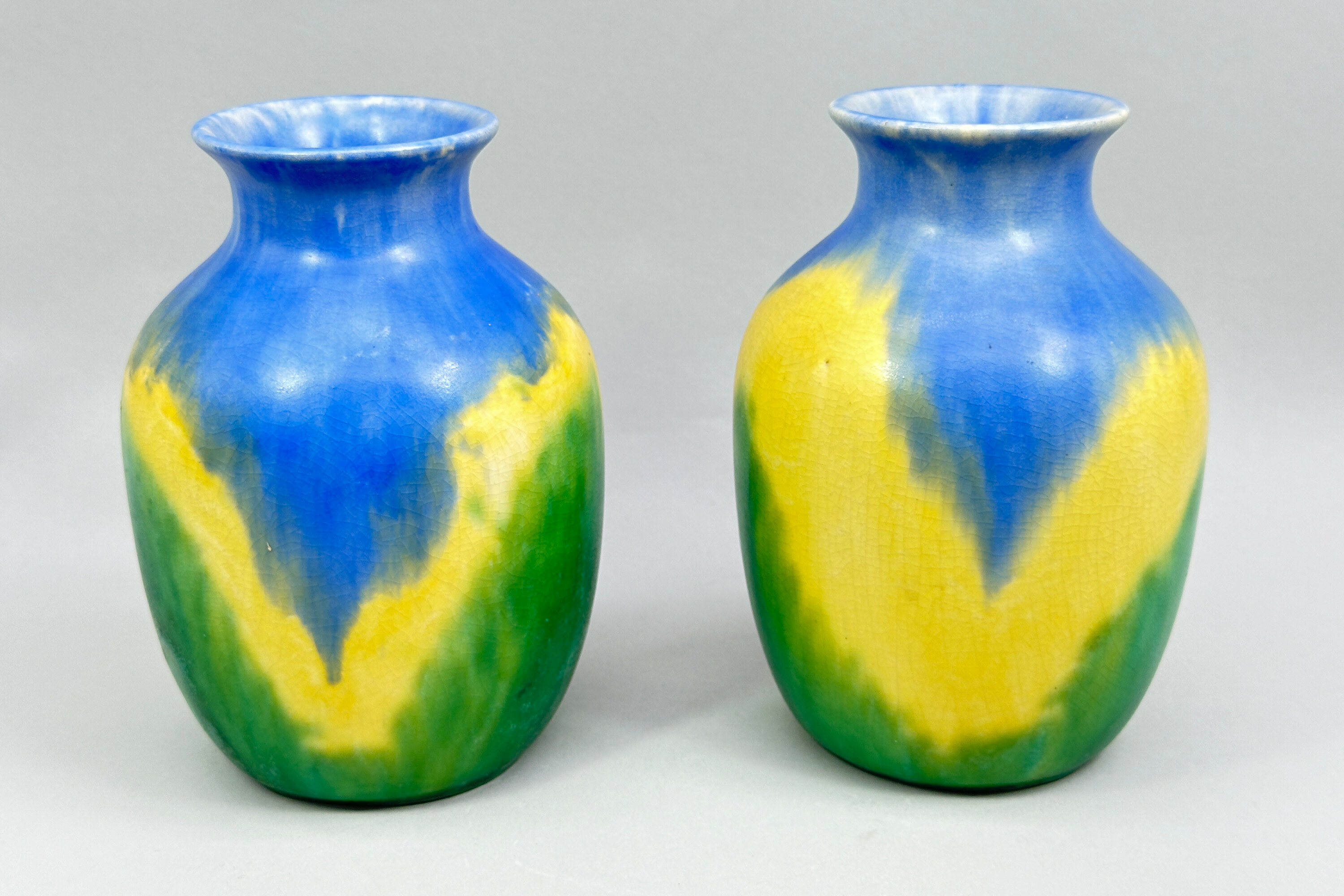
Delft style garniture vase, probably Chinese C20th
Price: £20
Japanese Kutani Part Tea Service circa 1920
Price: £75
West German Vase, Model No 517-38, Scheurich, 1960s
Price: £55Although not marked as such, this vase has all the hallmarks of the firm Scheurich Keramik which started production in 1954, rather later than most of its competitors, but soon became the largest producer of commercial art pottery in Germany. Their pieces rarely carried the factory name but usually the model number followed by the height in centimetres with ‘W.Germany’ below, as here. Model ‘517’ can be found in a variety of different glazes but the pattern and colourings here, more muted than some of Sheurich’s work and with a matt finish, are particularly pleasing and complement the elegant form most successfully. Dating is to the 1960s.

Rare Ditmar Urbach Art Deco Pitcher, Czech 1930s
Price: £250
Pair of Royal Dux Secessionist Style Vases, 1930s
Price: £250
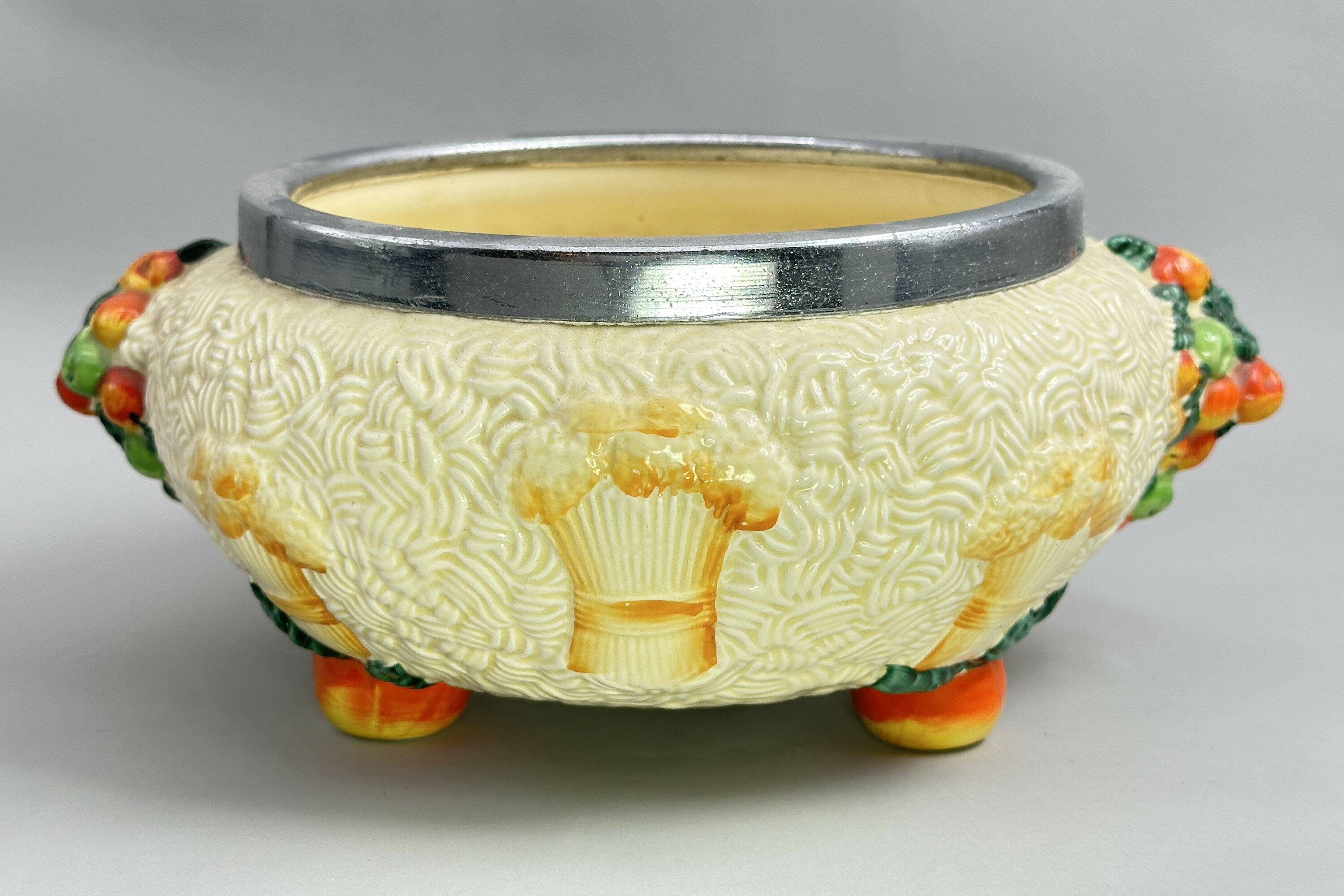
Clarice Cliff Celtic Harvest Centrepiece Bowl, marked, 1930s
Price: £55
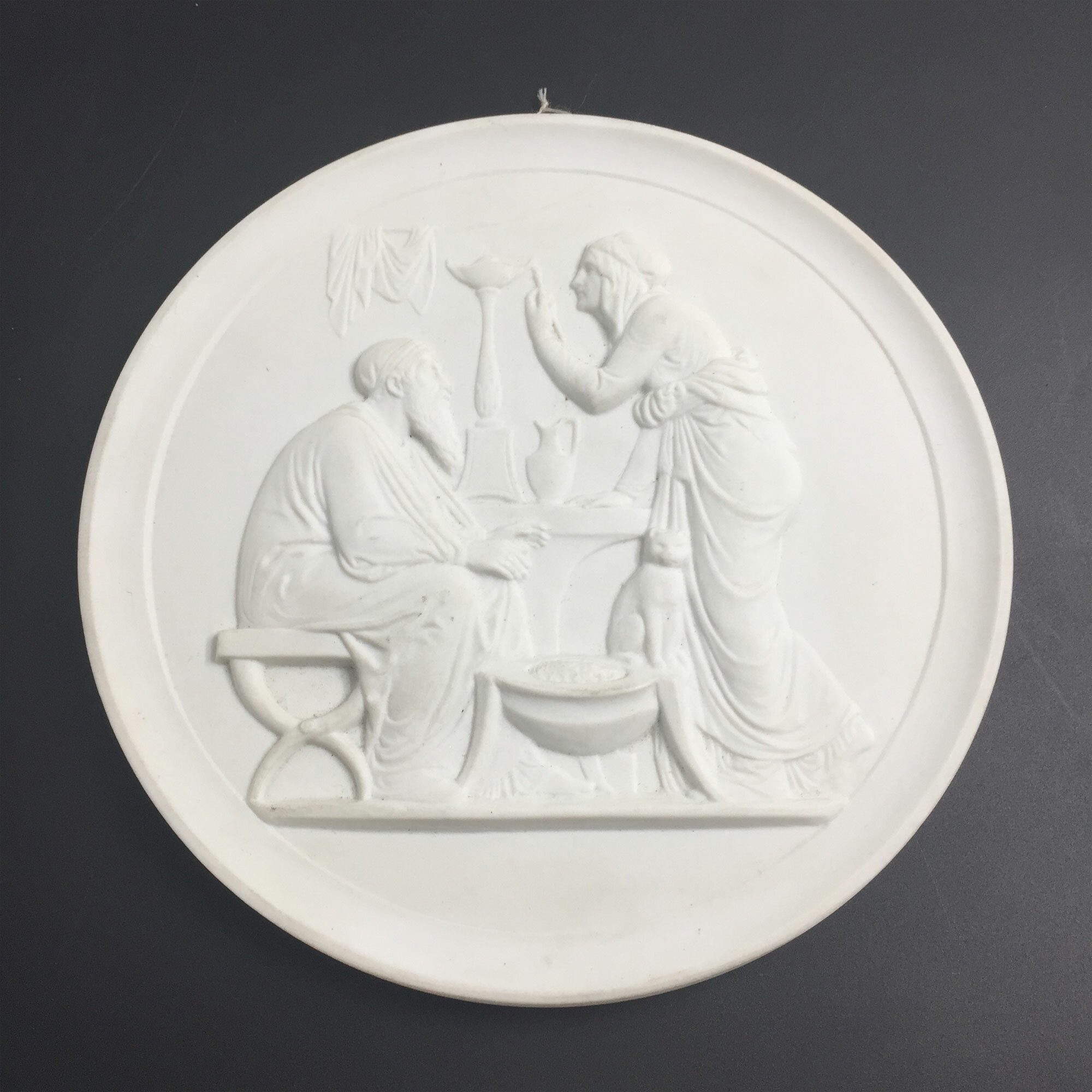
Pair of bisque relief plaques by artist Bertel Thorvaldsen. Royal Copenhagen 1969 - 74
Price: £40Bertel Thorvaldsen (born Nov. 19, 1770, or Nov. 13, 1768, Copenhagen, Den.—died March 24, 1844, Copenhagen), sculptor, prominent in the Neoclassical period, who was the first internationally acclaimed Danish artist. Prominent in Roman intellectual and artistic circles, he influenced many emerging artists from Europe and the United States. Most of Thorvaldsen’s most characteristic sculptures are reinterpretations of the figures or themes of classical antiquity. The Alexander frieze of 1812 in the Palazzo del Quirinale, Rome, modeled in only three months in anticipation of a visit by Napoleon, is an example of the feverish energy with which he could at times work. Religious sculptures include the colossal series of statues of Christ and the Twelve Apostles (1821–27) in the Vor Frue Kirke in Copenhagen. He also made numerous portrait busts of distinguished contemporaries.
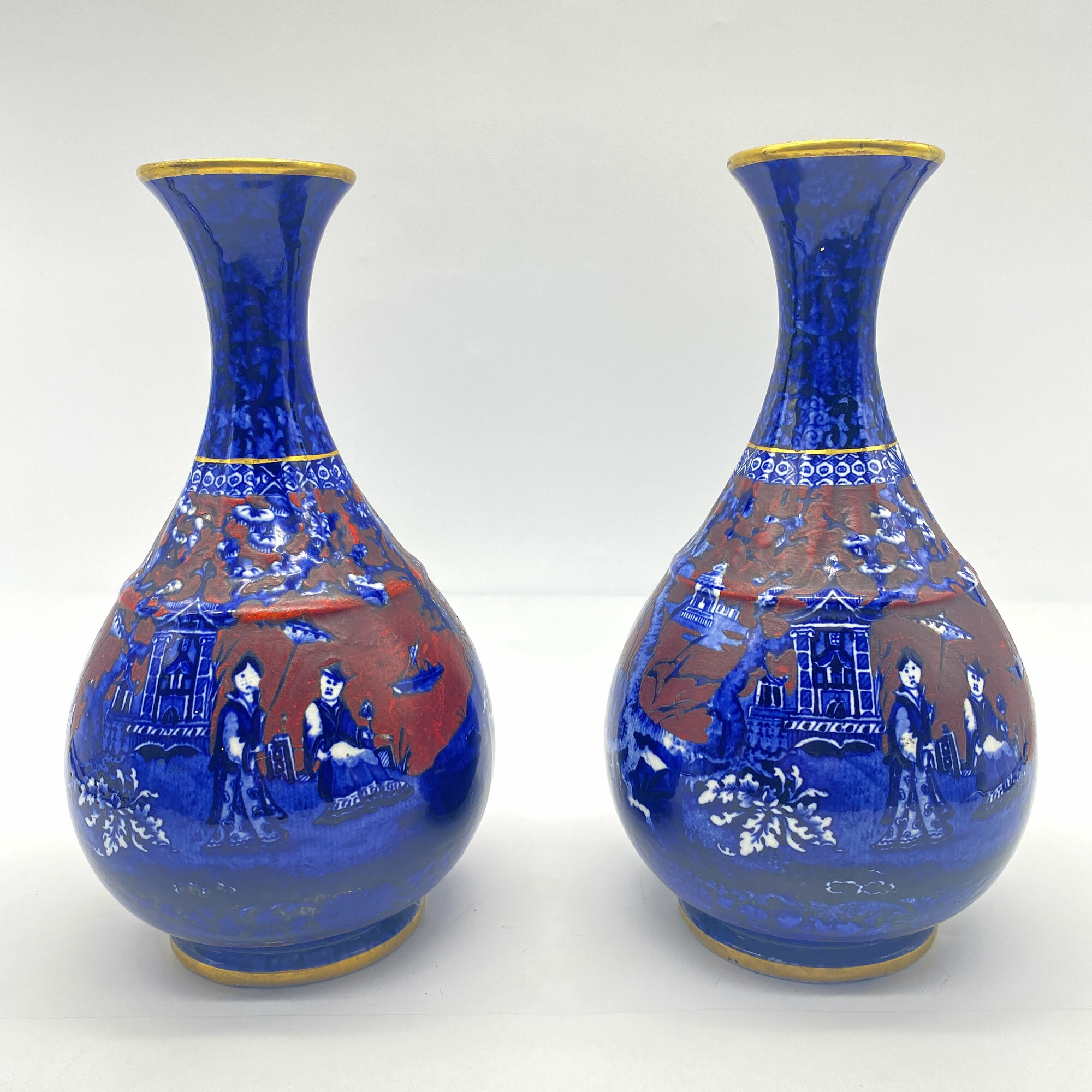
Pair of J Kent Chinoiserie Foley Ware Vases c1920s
Price: £75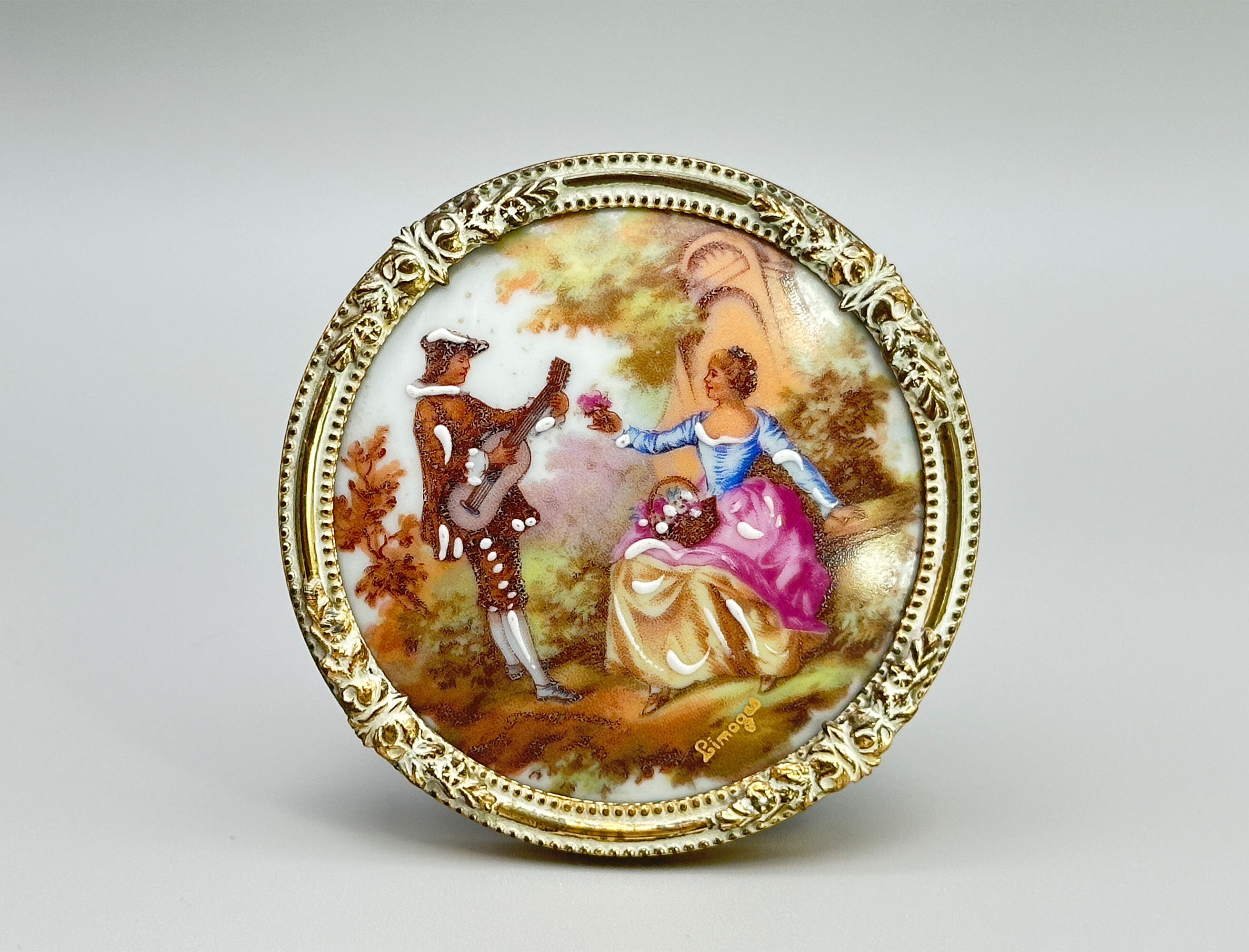
Small circular ceramic plaque after Fragonard marked Limoges, framed, late C20th
Price: £25
Kiralpo ware Dressing Table Set, marked, 1930s
Price: £35Kiralpo ware was one of the trade names used by Kirkland and Co, earthenware and ceramic manufacturers based at the Albion Pottery, Etruria, Stoke-on-Trent, England who traded from 1891 to 1938 when the business was bought and renamed by Mr A.E.Gray. The format of the mark gives a dating between 1928 and 1938 with ‘E’ standing for Etruria. Kirkland and Co made various modest but colourful decorative items to furnish the home. In a 1907 guide they are described as ‘general earthenware, fancy goods, and majolica manufacturers’. Their designs were not sophisticated but obviously had a popular appeal and this set with its bold transfer decoration of birds set within a rather vivid pink border is typical of their work.
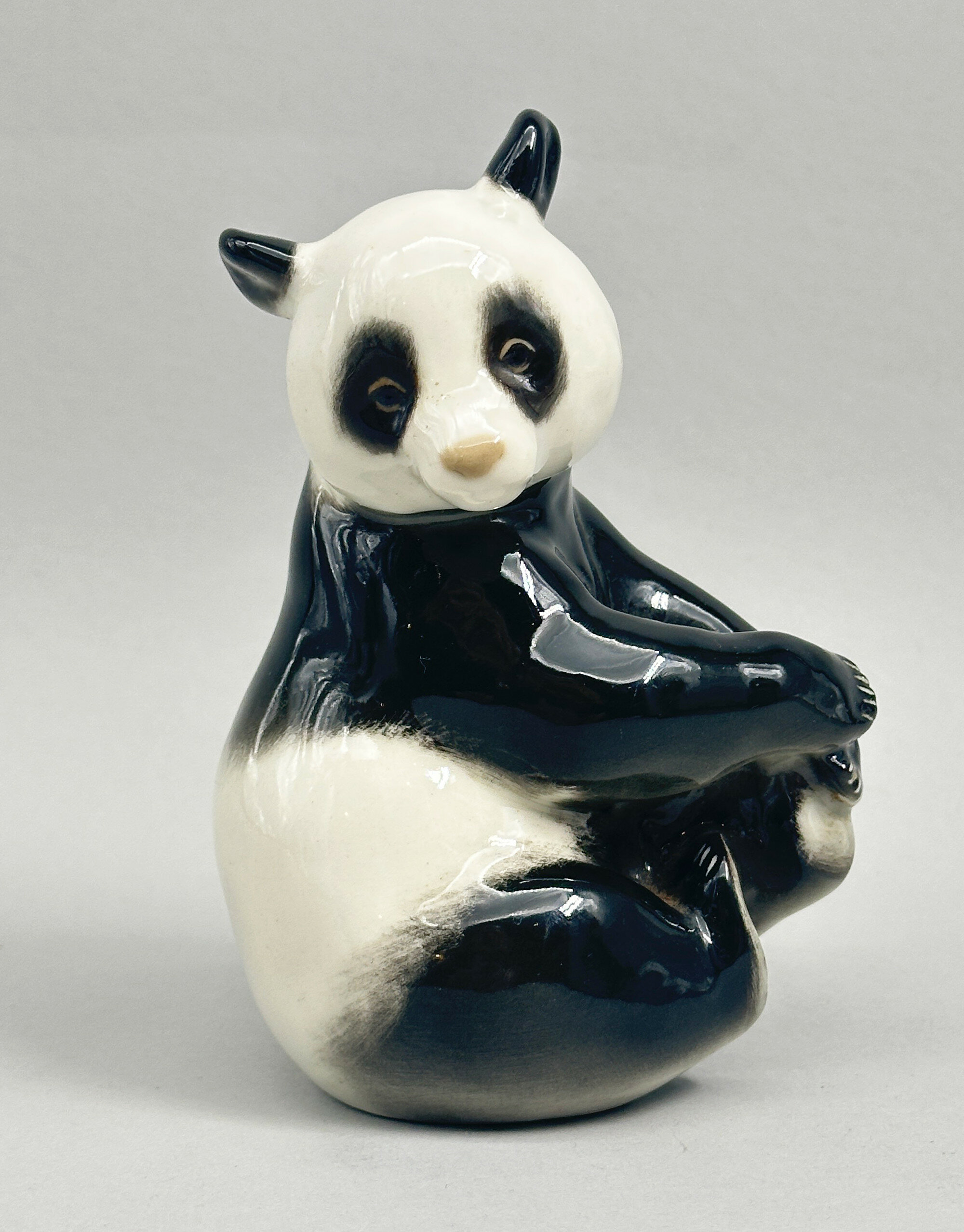
Porcelain Figure of a seated Panda, Lomonosov, USSR late C20th
Price: £25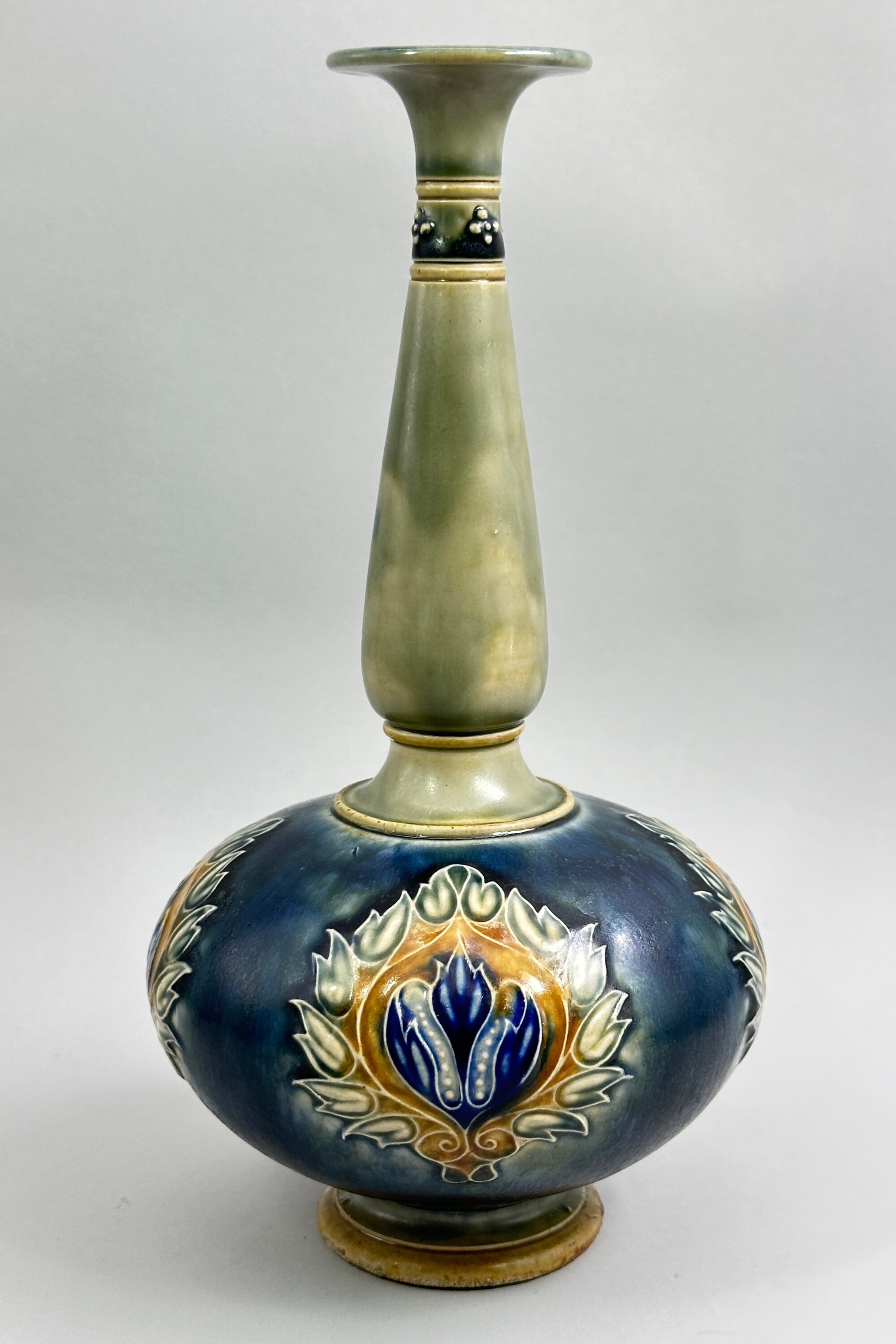
Royal Doulton bottle form Vase decorated with flowering lotus, early 20th Century
Price: £75The Doulton pottery originally had its first factory in Lambeth, London. Set up in 1815 by John Doulton, who is rumoured to have spent his life savings of £100 in starting the business, the firm concentrated on making pipes and utilitarian works. But in the 1880s the Company moved to Staffordshire and began making fine bone china tableware and decorative items. The pottery was located in Burslem, Stoke-on-Trent and has manufactured high quality ceramics and porcelains ever since, receiving a Royal Warrant in 1901.
This piece is typical of the glazed pottery pieces made in the late nineteenth and early twentieth centuries. A muted palette of colours was used and a variety of forms created with many artists taking a hand in the decoration. Most of the pieces are signed, as here. The pattern number indicates a date after 1894, but the Royal Warrant mark means a dating in the early 1900s. Perhaps a timing in the Edwardian era (1901-1910) is the most likely.
This vase is an excellent example of the creative designs which Doulton produced. As often, there is a slight Oriental influence but the style and design are unmistakeable.
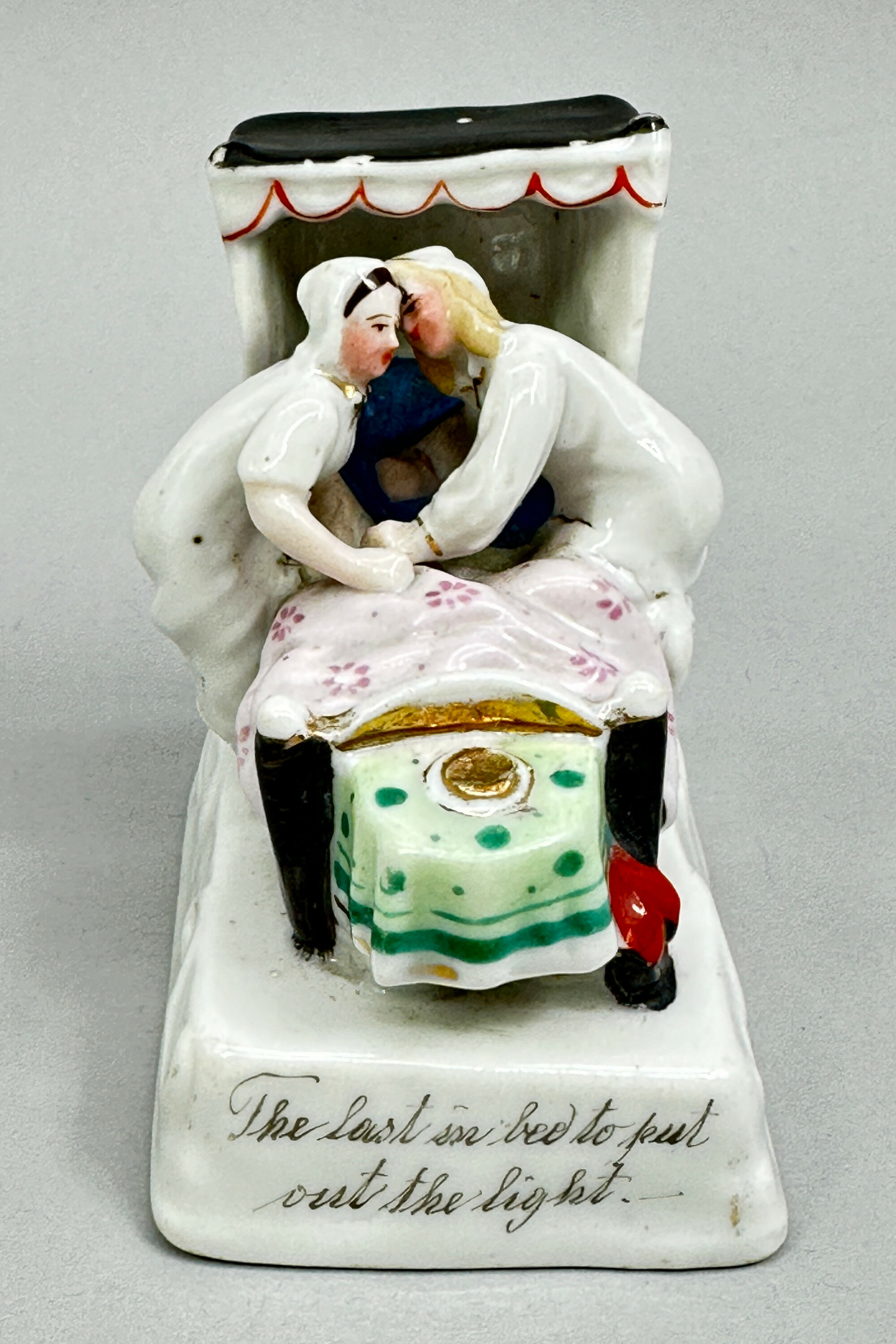
Fairing Figurine - The last in bed to put out the light, German, early Twentieth Century
Price: £25The various figures were made in white glazed porcelain with coloured decoration. The compositions were sculptural and often accompanied by an inscription, as here. Many models are known. Two typical examples are 'Returning from the Ball' and 'Twelve Months after Marriage' but the most common example is represented here 'The last in bed to put out the light'. A couple are seen climbing into a covered bed at the foot of which stands a candle in a holder. These candles are usually broken off, most likely because of simple damage over the years but it has been suggested that this was done deliberately for good luck.
Some of the fairing figurines are marked, as here. In comparison with the previous Lot 4, this example has a glazed circular mark which reads 'Made in Germany'. These marks appear on the later productions of the Conta factory and indicate a dating here to shortly before the First World War. This is consistent with the rather 'brassy' looking gilding used which is typical of ceramic production generally post 1900.
It is interesting to compare Lots 4 and 5 and to see how consistent the manufacture was throughout the period. Only the glazed base with its circular mark and the type of gilt decoration separate this example from its earlier companion.
Fairings have been collectors' items for many years now and still hold a naif charm which makes them appealing display items, with a history of their own.
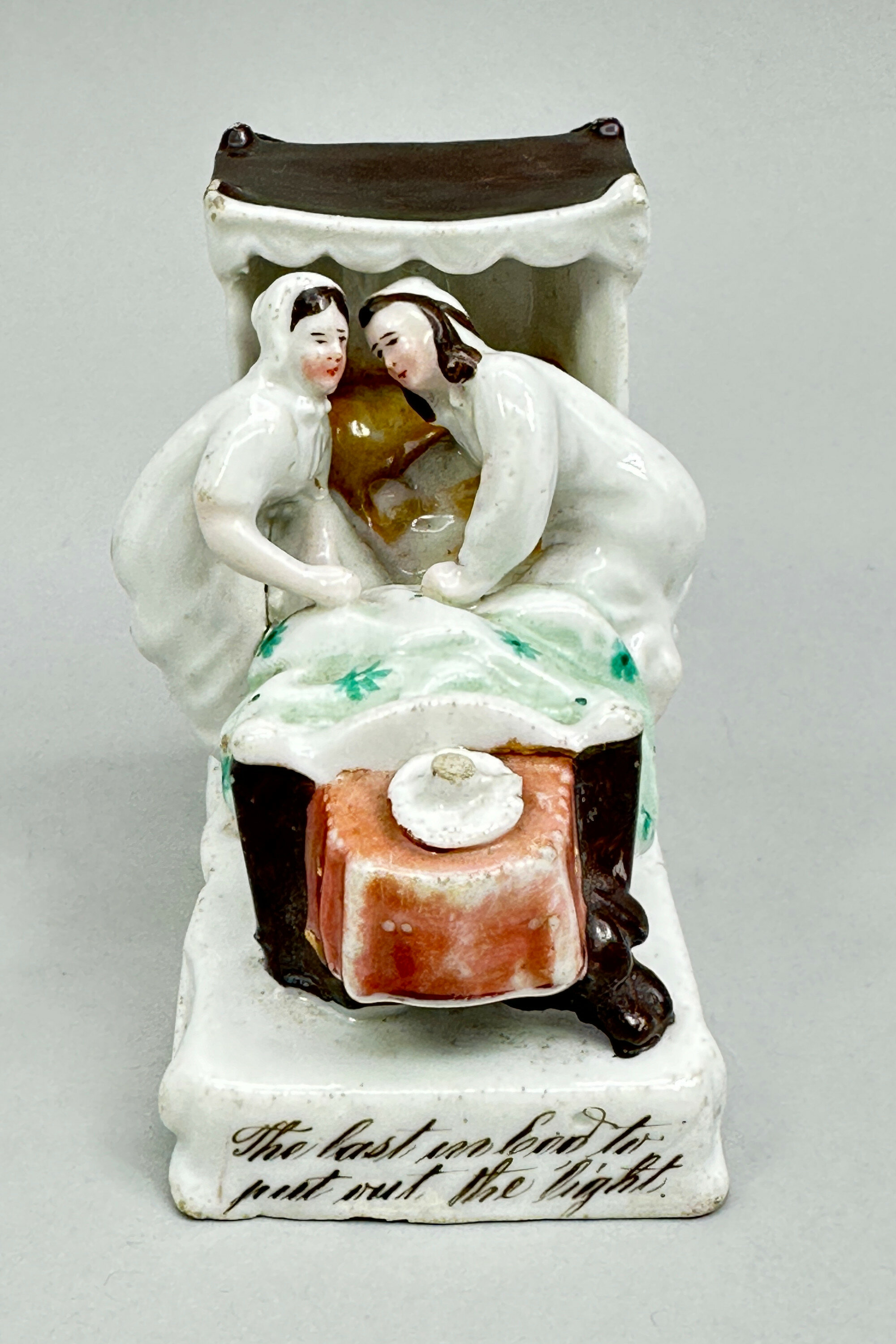
Fairing Figurine - The last in bed to put out the light, German, late Nineteenth Century
Price: £25The various figures were made in white glazed porcelain with coloured decoration. The compositions were sculptural and often accompanied by an inscription, as here. Many models are known. Two typical examples are 'Returning from the Ball' and 'Twelve Months after Marriage' but the most common example is represented here 'The last in bed to put out the light'. A couple are seen climbing into a covered bed at the foot of which stands a candle in a holder. These candles are usually broken off, most likely because of simple damage over the years but it has been suggested that this was done deliberately for good luck.
Some of the fairing figurines are marked, as here. The impressed number '2851' comes from the first series of figures produced by the Conta factory with numbers ranging from 2850 to 2899. The earlier examples do not have the shield mark found on most of the pieces which indicates an earlier dating here, more towards the middle of the nineteenth century.
Fairings have been collectors' items for many years now and still hold a naif charm which makes them appealing display items, with a history of their own.
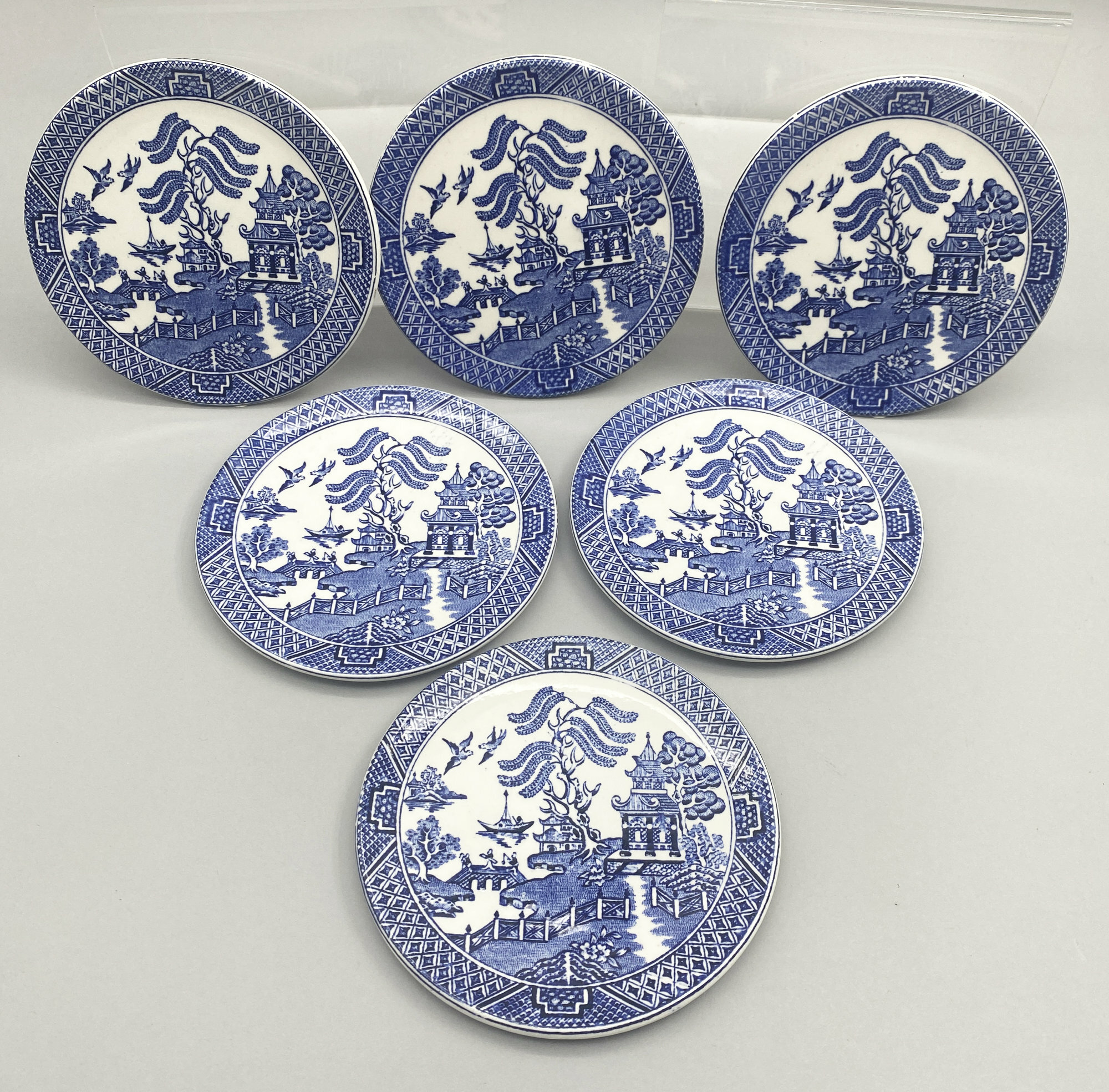
A Set of Six Blue and White Willow Pattern Coasters English Ironstone 1980s
Price: £25These coasters formed part of their range. The decoration employs the transfer pattern technique developed in England in the mid eighteenth century and a staple of nineteenth century productions. Printed designs were 'transferred' to the ceramic surface allowing the production of extensive services in a matching pattern. The Chinese derived 'Willow Pattern' design seems to have been first used around 1790 and was probably designed by Thomas Minton for Spode. All the versions contain similar elements besides the pagodas and landscape scenes most notably the three figures on a bridge and a pair of flying swallows. In order to promote sales, various stories were invented based on elements of the design. These coasters are an amusing recollection of times past and highly practical in addition.
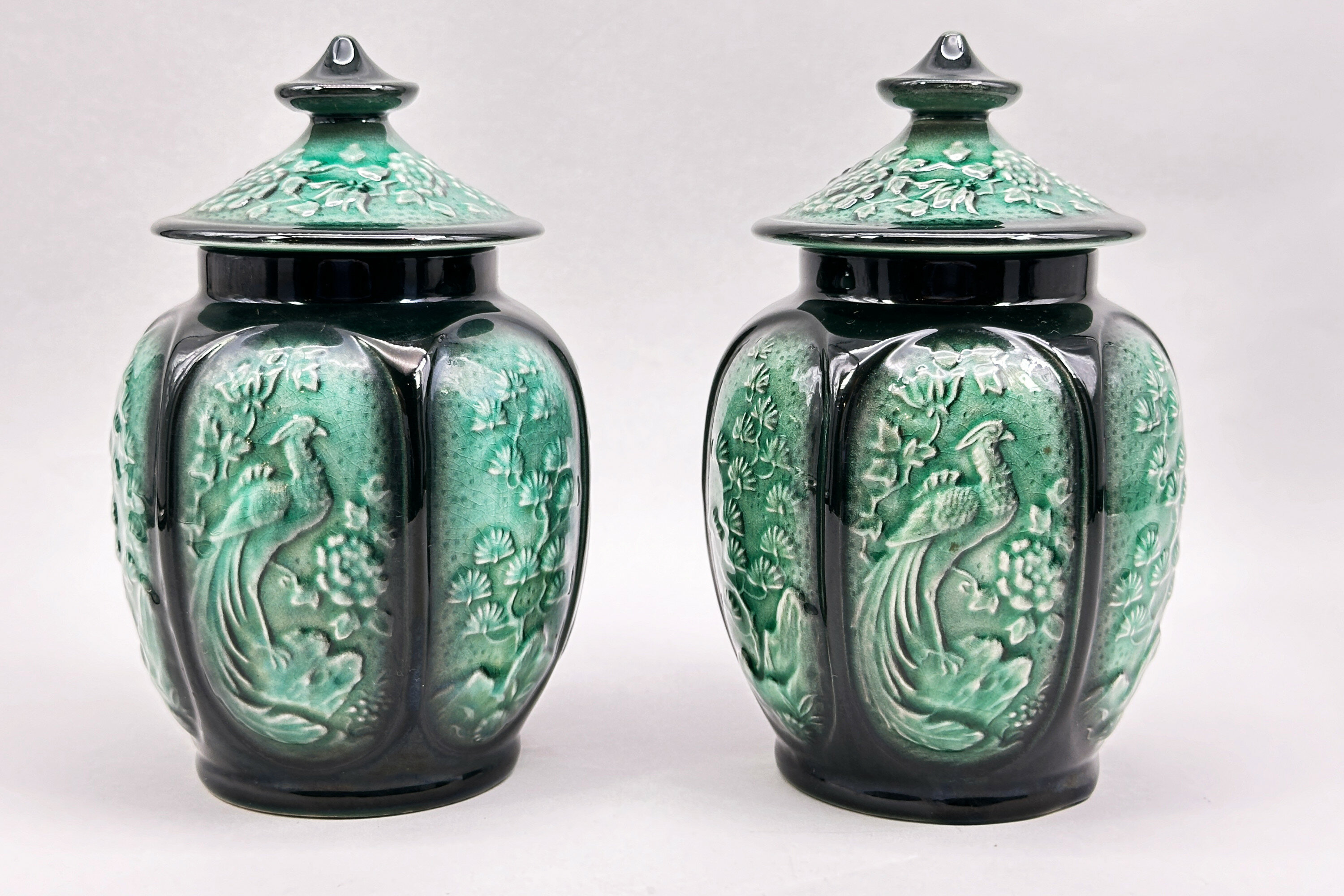
Pair of Oriental Style green glazed Sylvac Jars and Covers, circa 1960
Price: £95‘SylvaC’ (the name was written with a capital ‘C’ after registration of the trademark in 1938) was a trade name of Shaw and Copestake, a company formed by Mr. William Shaw and a Mr. Copestake around 1900. Mr. Copestake sold his shares to a Mr. Richard Hull after about six months of business and this partnership continued until Mr. Hull’s death in 1935. He was succeeded by his son, Mr. Richard Hull junior. In the following year, the business became a limited company. Various mergers and acquisitions followed and in the 1950s new premises were built and production expanded considerably continuing until the early 1980s when changing markets and increased competition forced the company into liquidation.
Sylvac were known for imaginative glazed wares, particularly animals, but this design with its reminiscences of the Orient in both form and decoration is rather more unusual and particularly pleasing. These jars were produced in a variety of colours but the combination here of green and black, loosely recalling Chinese ‘Famille Noire’, is probably the most successful.
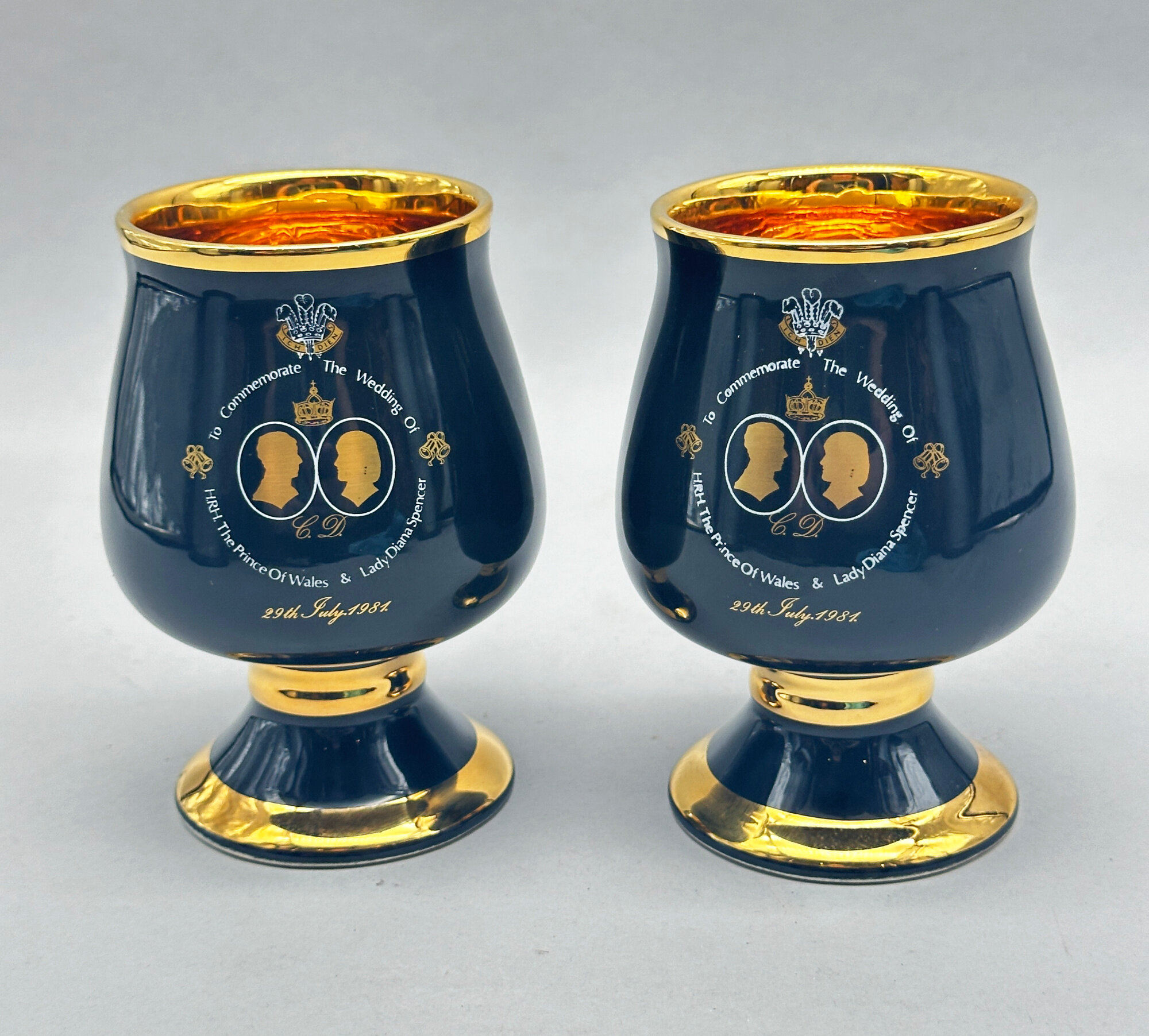
Pair of Ceramic Goblets : the Wedding of Prince Charles and Lady Diana Spencer in 1981
Price: £20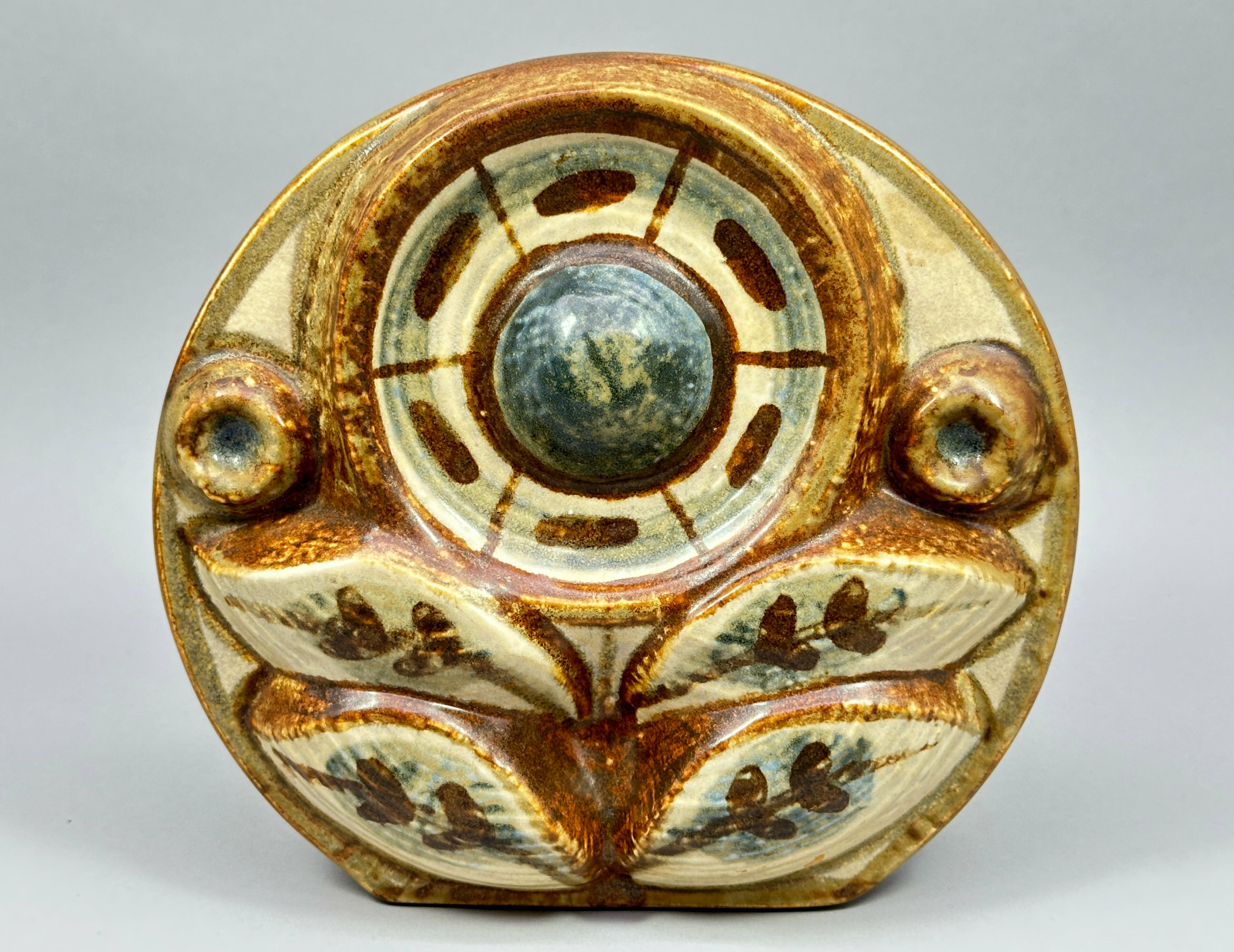
Wall Vase, designed by Noomi Backhausen, Søholm Stentøj, Denmark, late C20th
Price: £95The company Søholm Stentøj was founded by Herman Sonne Wolffsen and Edvard Christian Sonne in 1835 at Rønne, the principal town of Bornholm, a Danish island off the south coast of Sweden. One of the most respected of the Danish potteries it continued producing a wide range of ceramics until the firm closed in 1996. Noomi Backhausen was a designer for Søholm from 1966 to 1990 and set up her own pottery in Rønne in 1996 after the closure of her old employers. This wall vase is a typical example of her abstract organic designs and would be a worthy addition to a collection of twentieth century Danish design.

Falcon Ware Jardiniere decorated Mallard Duck and Foliage, 1930s
Price: £65Falcon Ware was the trade name for pieces produced by Thomas Lawrence, later Thomas Lawrence (Longton) Ltd, a business founded by Thomas Lawrence in 1885 which moved to the Falcon works, Longton, in 1895. In the same year he took his nephew, John Grundy into partnership and around 1920 Grundy became the Managing Director. Thomas Lawrence died in April 1932 and John Grundy became the sole proprietor until his death in 1938 when the business was sold to Grundy's son-in-law Mr Richard Hull (jnr) and Mr. E.J. Dennis and the name was changed to 'Thomas Lawrence (Longton) Limited'. At the same time the firm merged with Shaw and Copestake Ltd of which Richard Hull was a Director but the two businesses still operated independently until 1962 when the Thomas Lawrence business was fully subsumed by its partner with the ‘Falcon’ name ceasing to be used two years later in 1964.
Falcon Ware was known for colourful and decorative designs often with naturalistic themes. This jardiniere is an excellent and unusual example. The cipher ‘LG’, for Lawrence and Grundy, which is not so often found, implies a dating to the 1930s which corresponds with the general style of the piece with its hint of Art Deco associations.
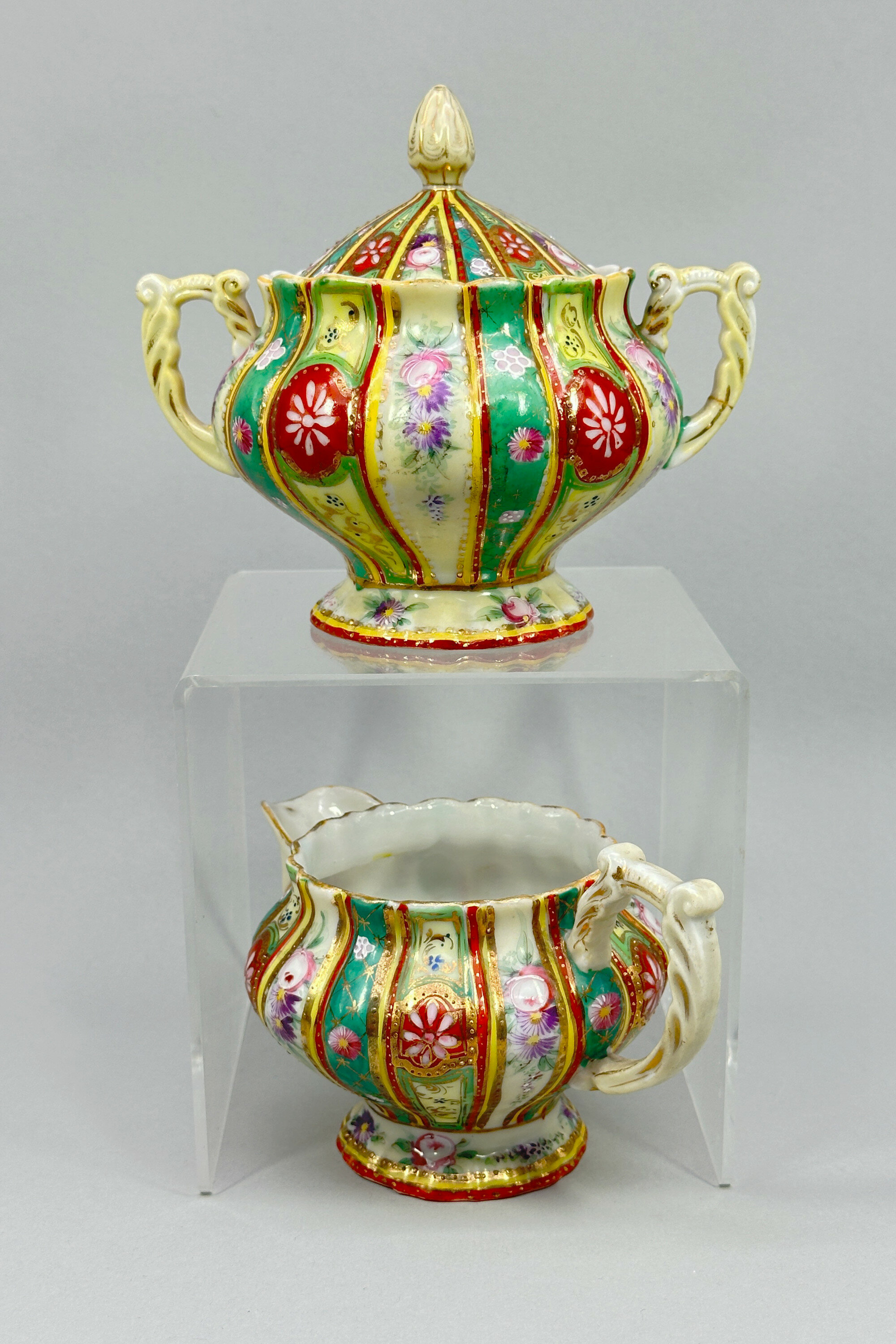
Vintage floral decorated Sugar Bowl and Cream Jug, probably Bohemian mid C20th
Price: £25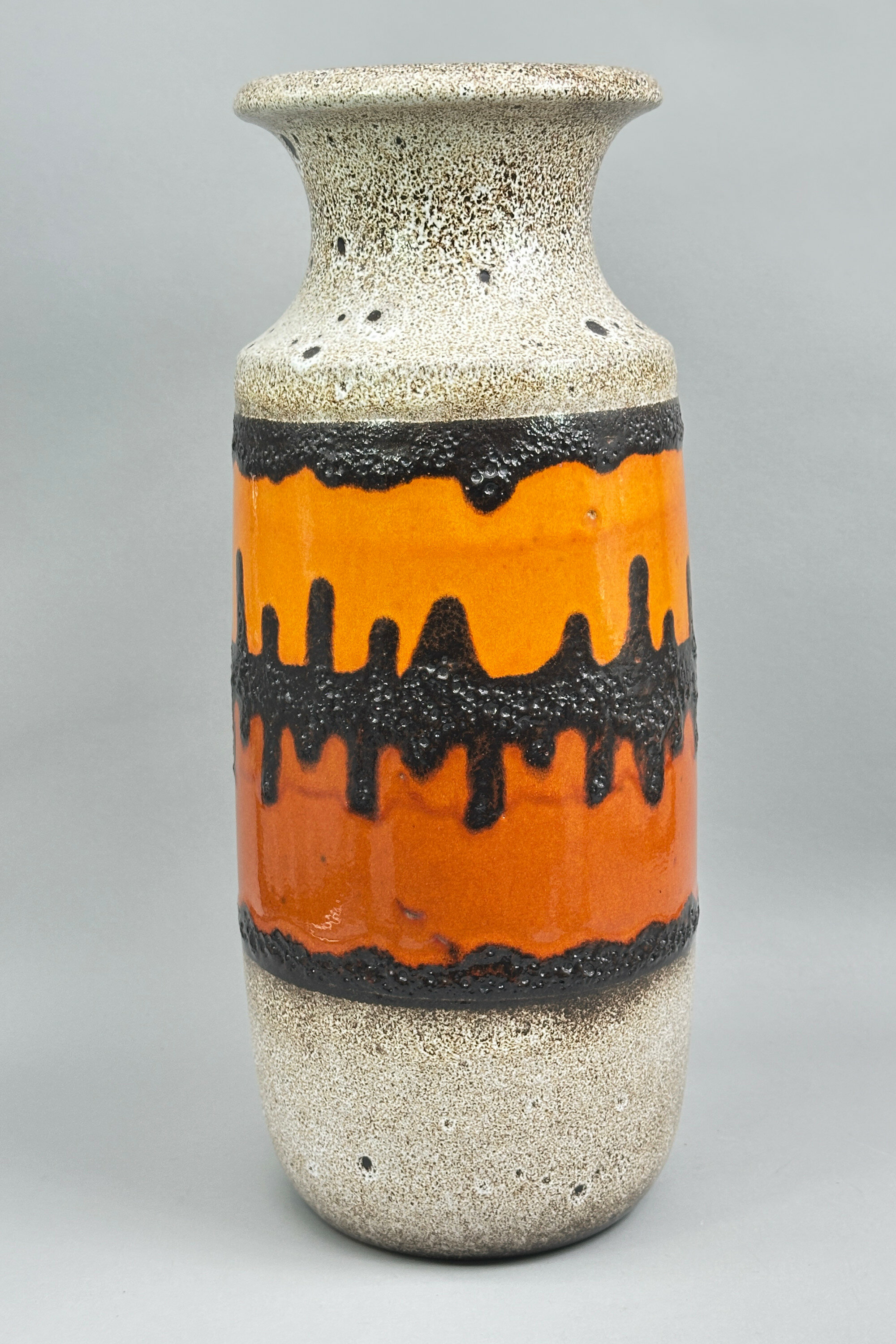
West German Studio Pottery Vase, Scheurich 259-41, 1970s
Price: £150……………………………………………………………………………………….....................................................................................… .
It took time for Germany to rebuild after the Second World War and it was not until 1949 that the country regained its national identity. The production of ceramics slowly revived and began to gain momentum in the 1950s eventually reaching a total of over one hundred companies and studio potteries. Some of the concerns produced a substantial output including Carstens, Bay, ES, and Dümler & Breiden but the most prolific of all was Scheurich. In 1927 Alois Scheurich established with a partner a company named ‘Scheurich and Greulich’ (S&G) which focused on producing low cost ceramic and glass items (see image 7). The success of this business provided the springboard for the creation of ‘Scheurich KG Keramikfabrik’ in 1954. While it commenced production rather later than some of its competitors it soon grew to overtake them and the glaze colourings for which it became best known were produced in the 1970s. Eventually the firm changed direction yet again and is now known for producing ceramic garden ornaments which have an international appeal.
Most of the Scheurich pieces are marked, nearly always with two sets of numbers ‘XXX-XX’ and the wording ‘W.GERMANY’, although there are variants. The firm’s name can appear in addition, as here, where we see as well ‘SCHEURICH KERAMIK’, and it is thought that this indicates a later dating to the 1970s/1980s. The first three numbers are the model number and the last two the height in centimetres, here ‘259-41’. ‘259’, as with nearly all the model numbers, was made with a wide variety of glaze colourings and effects. Equally, similar colours and patterns were used on different models. The shape is one of the firm’s most successful. The cylindrical body narrows gently towards the base and has a well defined shoulder with a concave neck and an inturning rim. The bright orange at the centre is bordered with and divided by irregular black ‘crusty effect’ bands. These are an excellent example of the apocryphally named ‘lava’ glaze for which Scheurich was so well known. Either side of this are two sections of grey speckle glaze which complete the whole. The vase is glazed brown inside and at the base which has the factory markings in raised lettering. Similar glaze combinations can be found on other pieces but the result is rarely as successful as here and the colour scheme used enhances the classic simplicity of the shape, loosely derived from a Chinese original.
This is a vase to appeal to decorators and collectors alike and is very much a ‘one off’ example of these popular wares standing rather apart from its many companions.
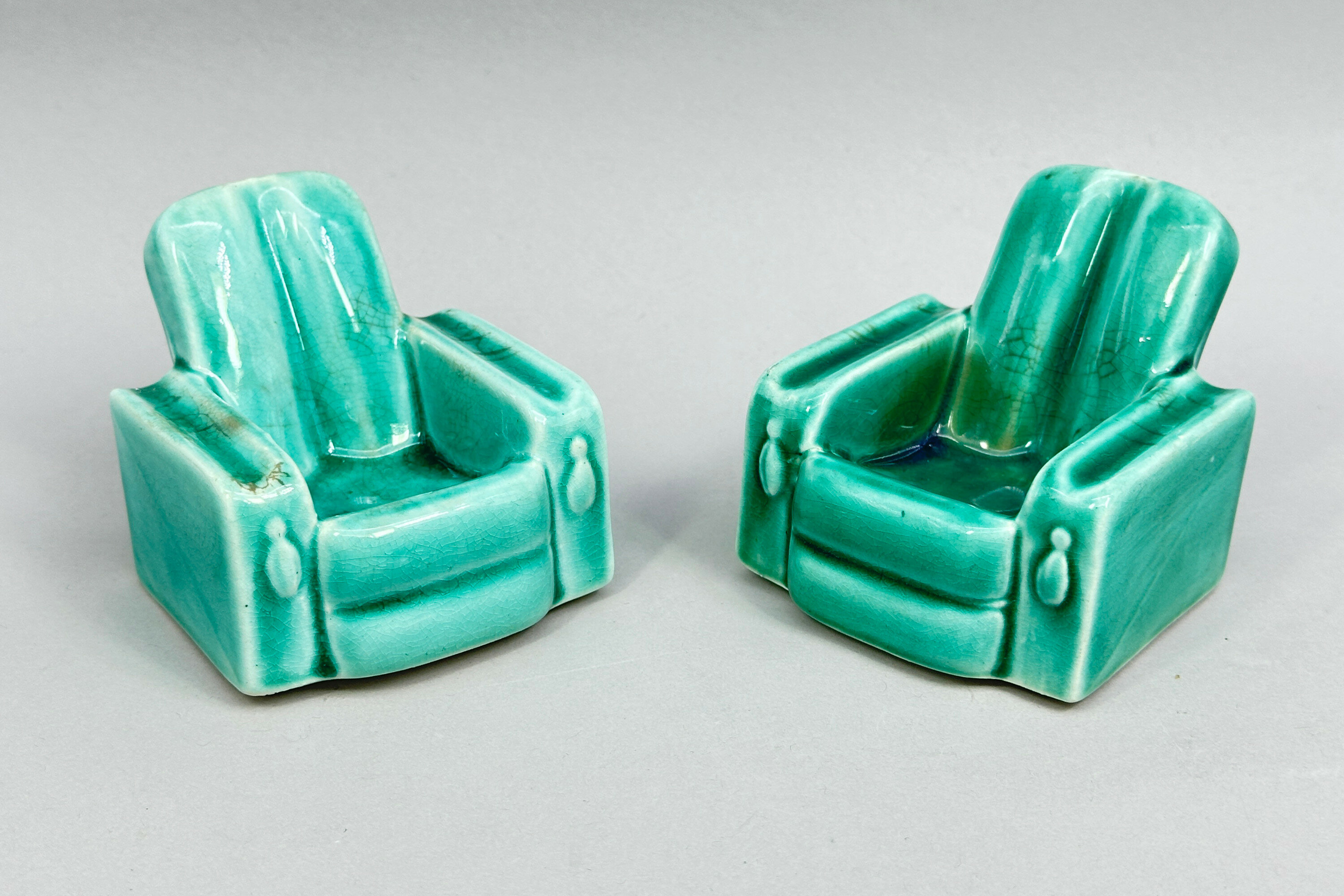
Pair of Vintage Art Deco style armchair Pipe Rests, English c1930
Price: £55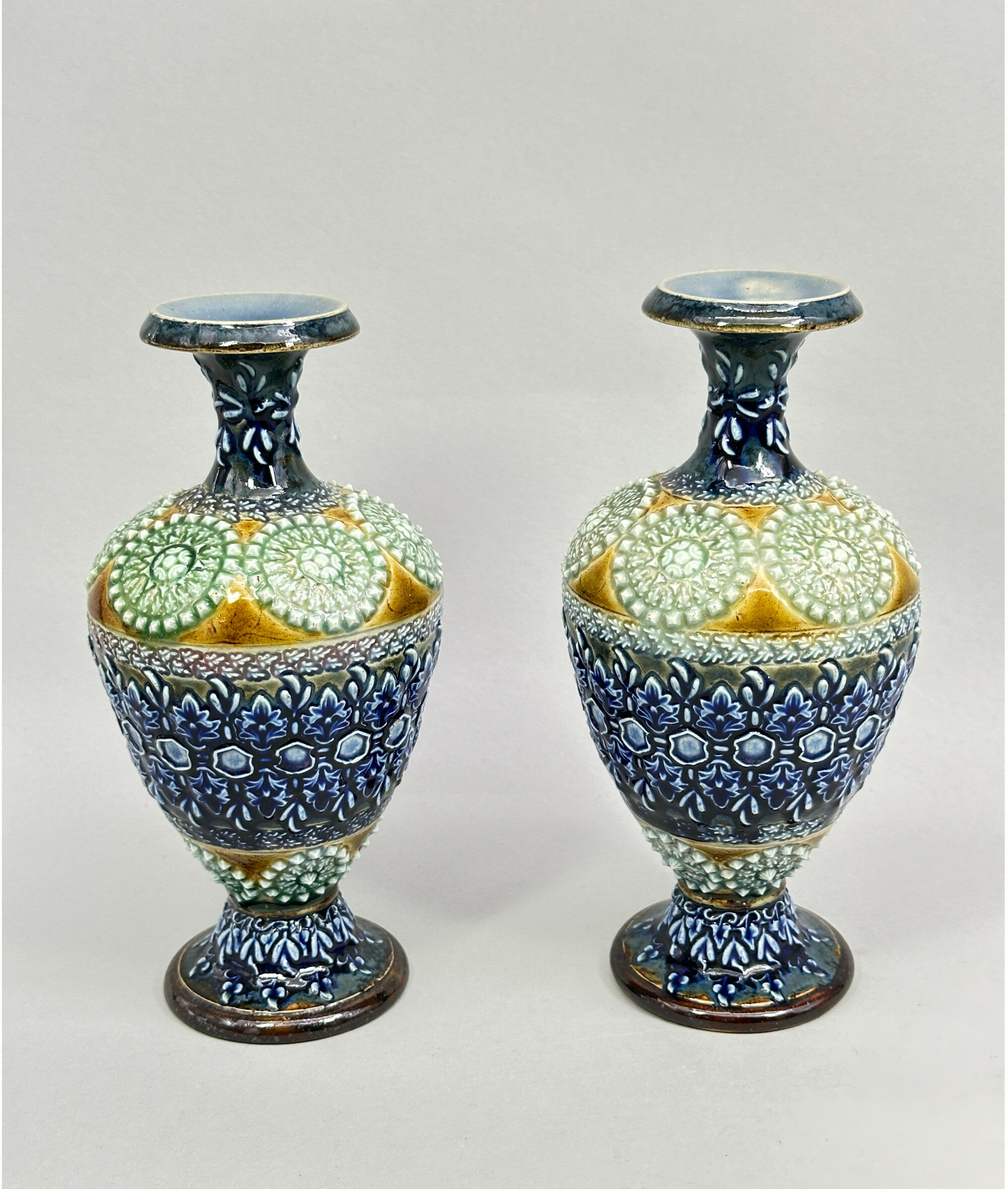
Pair of Doulton Lambeth Vases, signed and dated 1882
Price: £150The Doulton factory began production in 1815, first at Vauxhall and later moving to Lambeth. In 1882 it opened an additional factory at Burslem, Stoke on Trent in the centre of the English pottery. Known at first mainly for utilitarian works it began to develop decorative wares more extensively in the 1860s and soon gained a reputation for its distinctive designs. As the factory mark indicates, these pieces were made at the Lambeth factory and the absence of ‘England’ below it indicates that it dates to before 1891. The Lambeth ware pieces were often marked with the date of manufacture, here 1882 which is fully consistent with a design inspired by Eastern influence. The artist’s mark, ‘B’ with a tail, which appears on both pieces, is for Alice L Burlton, whose signature can be seen on other pieces of a similar date with similar raised decoration. The other three markings ‘B’ and ‘OO’ presumably indicate the pattern number.
In general, Doulton designs were often both striking an experimental and this pair of vases is an example of their work at its best, a striking form combined with skilful decoration making them true collector’s items.
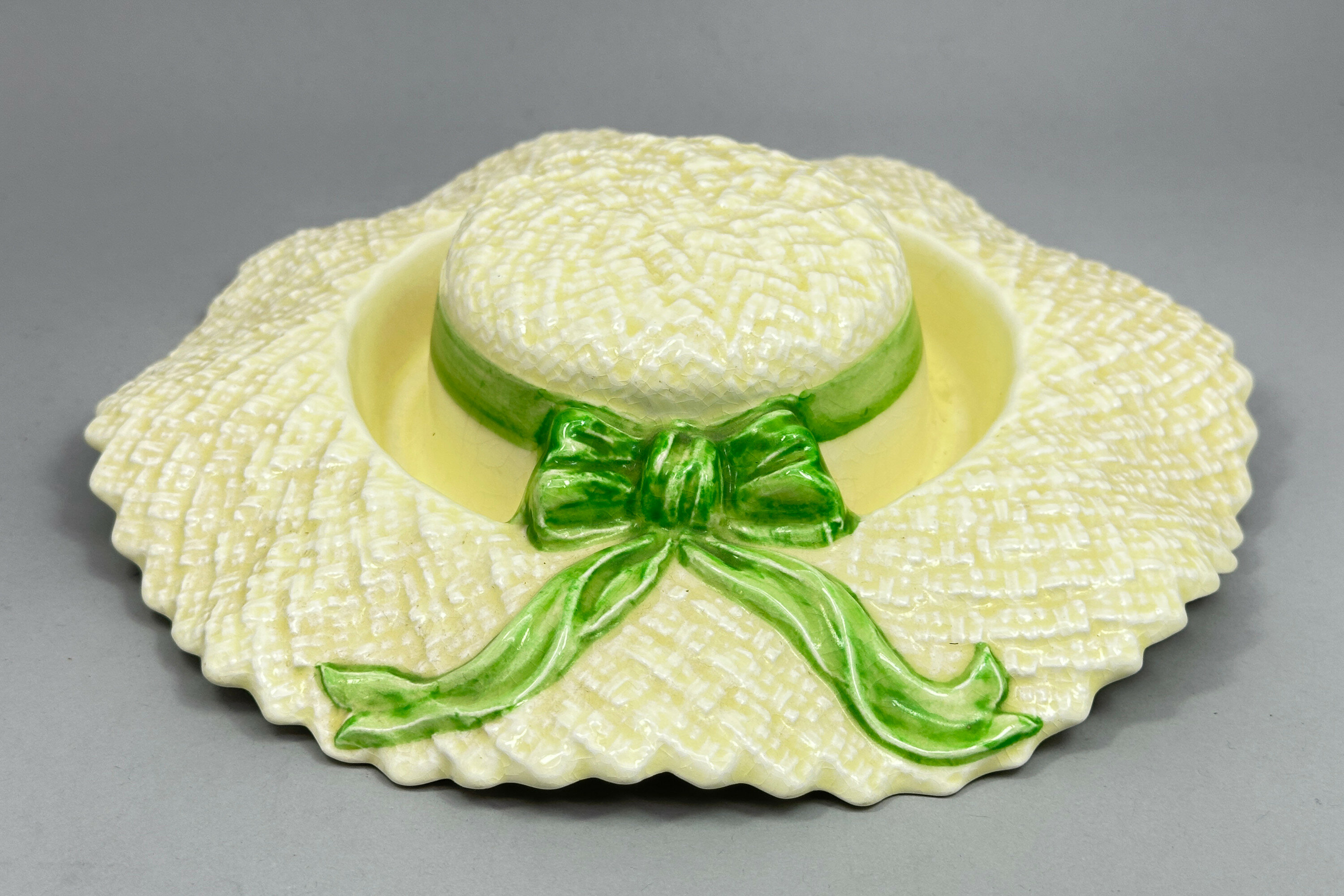
Novelty Bonnet Posy Vase, 1940s/1950s
Price: £25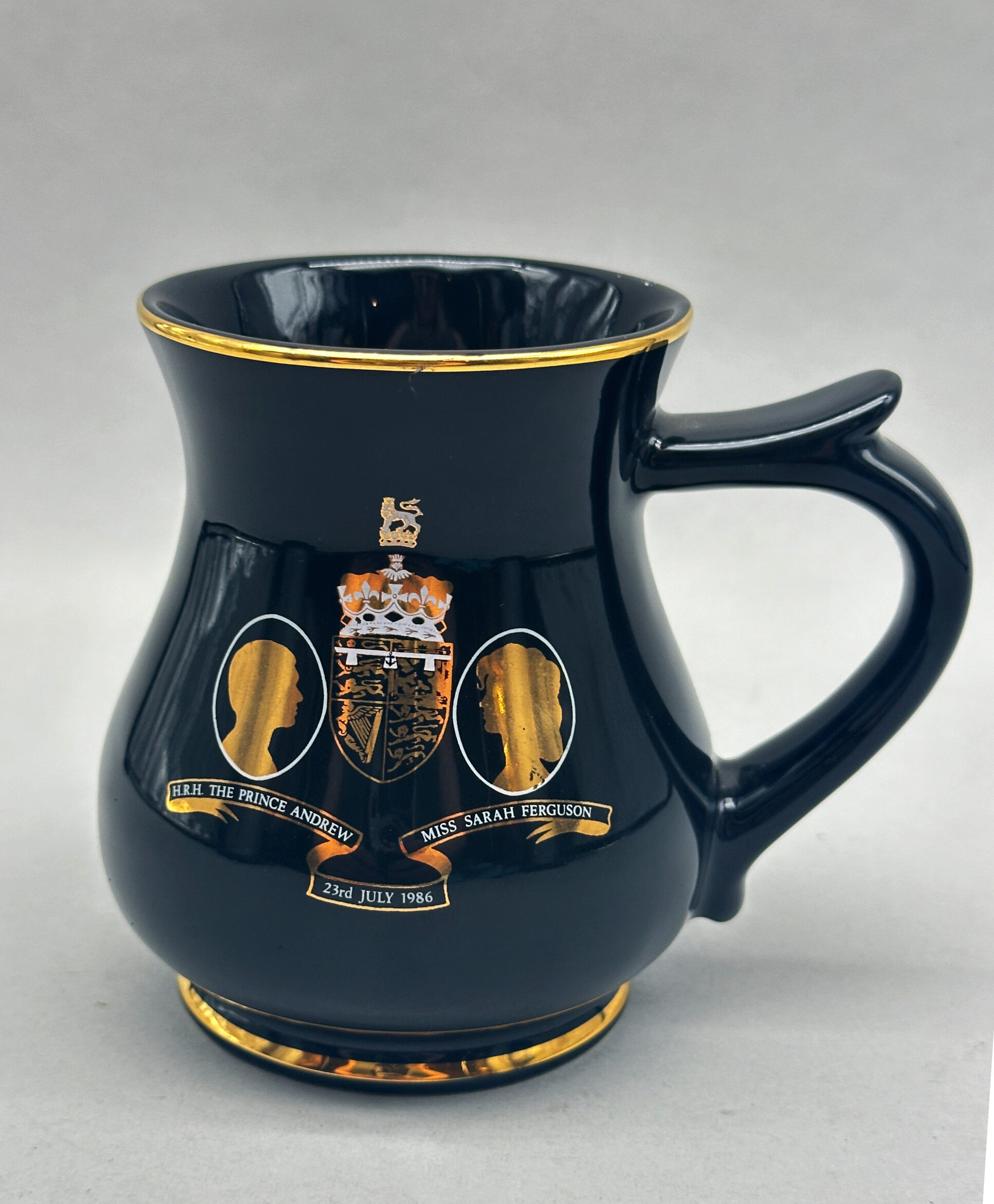
Ceramic Tankard celebrating the Marriage of Prince Andrew and Sarah Ferguson in 1986
Price: £10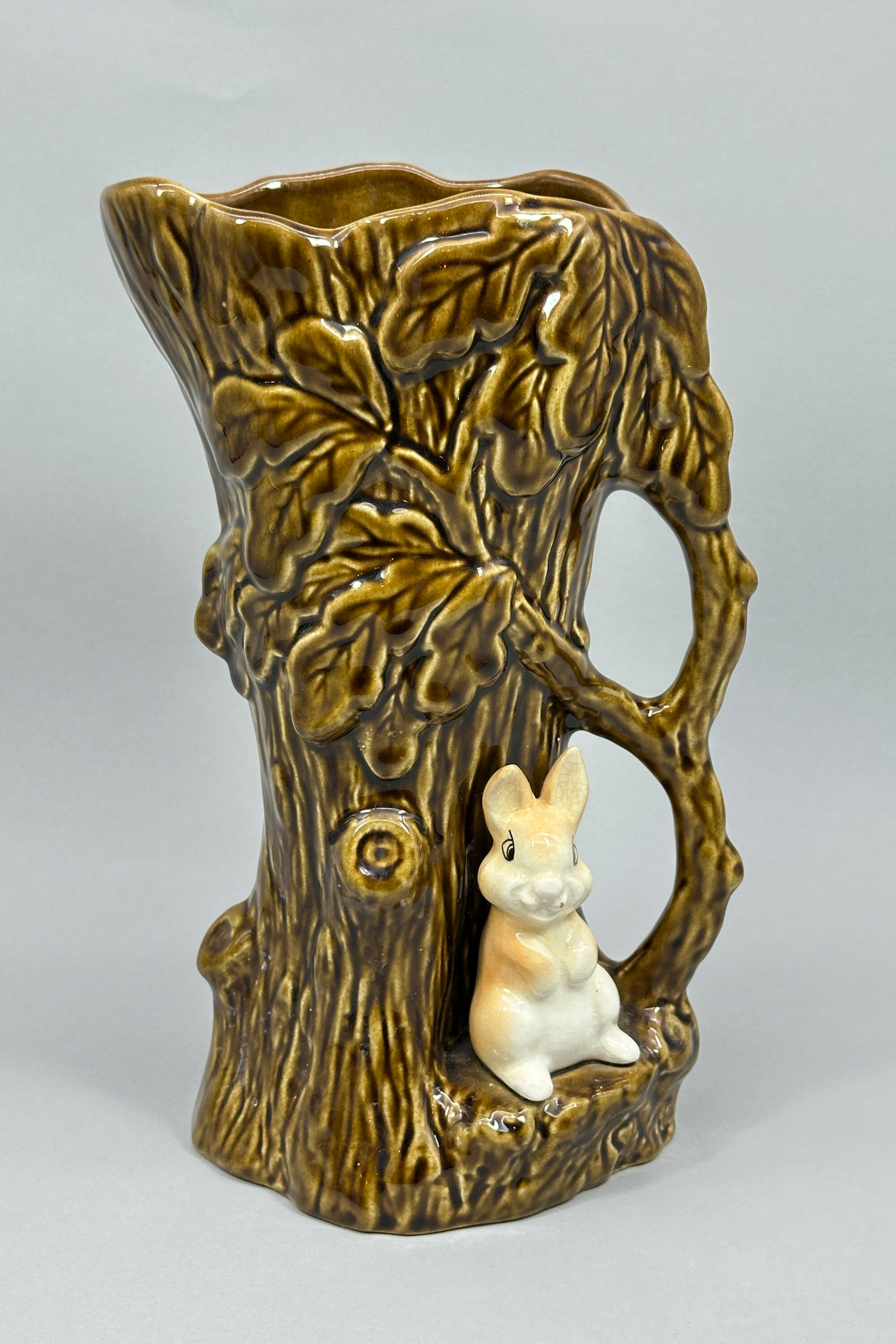
Sylvac woodland range Rabbit and Tree Jug, 1950s
Price: £35‘SylvaC’ (the name was written with a capital ‘C’ after registration of the trademark in 1938) was a trade name of Shaw and Copestake, a company formed by Mr. William Shaw and a Mr. Copestake around 1900. Mr. Copestake sold his shares to a Mr. Richard Hull after about six months of business and this partnership continued until Mr. Hull’s death in 1935. He was succeeded by his son, Mr. Richard Hull junior. In the following year, the business became a limited company. Various mergers and acquisitions followed and in the 1950s new premises were built and production expanded considerably continuing until the early 1980s when changing markets and increased competition forced the company into liquidation.
Sylvac were famous for imaginative glazed wares, particularly animals, and this jug is a typical and pleasing example of their work.

Continental Earthenware Vase with geometric motifs in the style of Amphora, C20th
Price: £45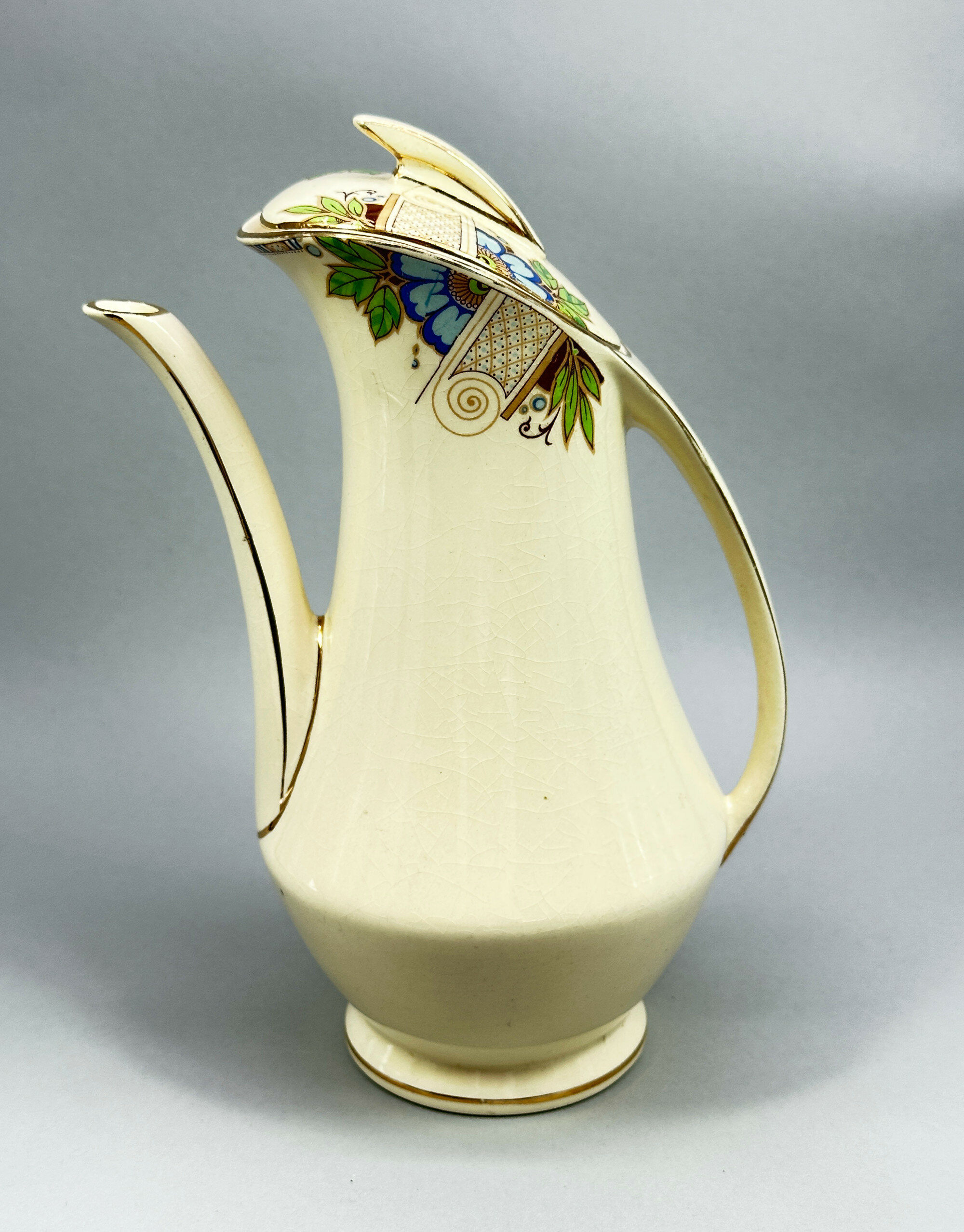
Art Deco Coffee Pot, Crownford Burslem, Staffordshire 1930s
Price: £35Burslem in Staffordshire was one of the famous six ‘pottery towns’ and immortalised in the novels of Arnold Bennett as ‘Bursley’. The firm Thomas Ford and Sons began its production there in the late nineteenth century, continuing until 1938 when the business was purchased by Oswald Shufflebottom who renamed it Ford & Sons (Crownford) Ltd. The trade name ‘Crownford’ had been adopted quite early on by the Ford family and was kept by the Shufflebottom family until the late 1980s. The ‘Crownford Burslem’ wares were mostly produced in the fashionable Art Deco style during the late 1920s and 1930s and this coffee pot is a fine and representative example of their work.
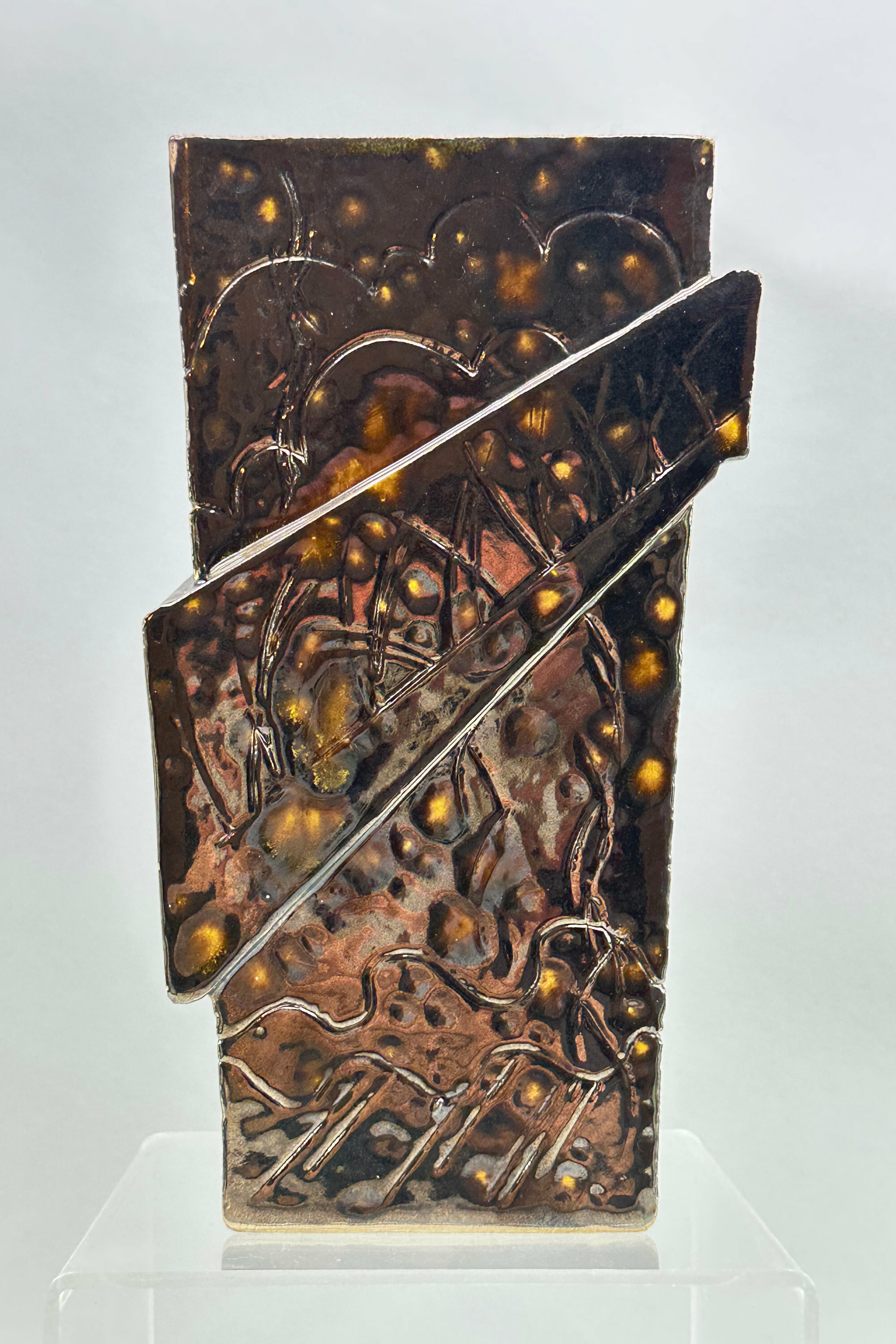
Art Deco Style brown lustre glaze triangular form Vase, signed, C20th
Price: £35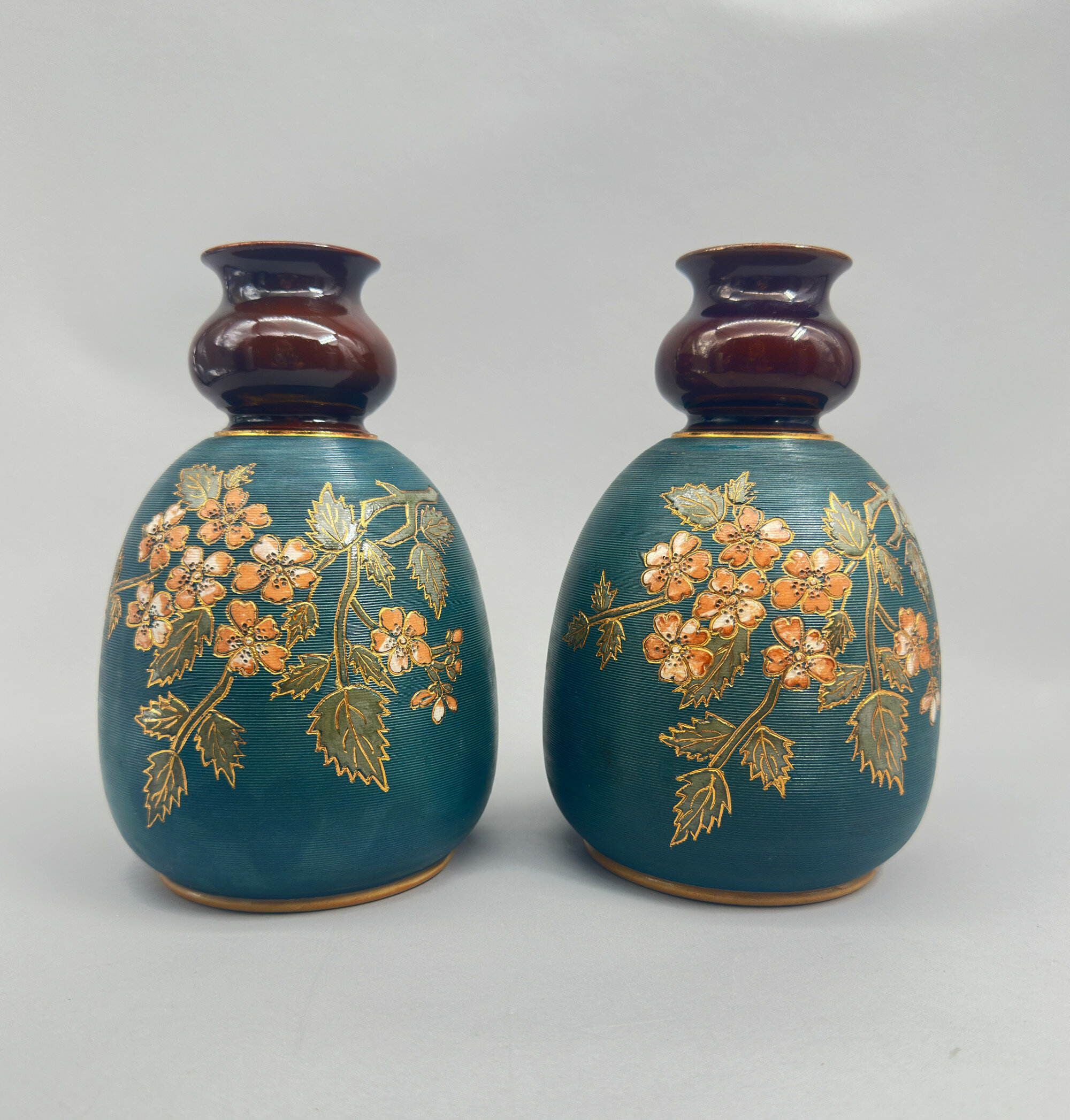
Pair of Lovatt and Lovatt Langley Mill Vases, early C20th
Price: £85The Langley Mill Pottery was located in Langley Mill, Derbyshire on the Derbyshire – Nottinghamshire border. From its establishment in 1865 to its final closure in 1982, it went through five distinct periods of ownership, producing a wide range of stoneware ranging from utilitarian items and to high quality art pottery. This pair of vases dates from the third company that traded there, Lovatt and Lovatt. The Lovatt family had entered into partnership with the owner of the founding business at Langley Mill, James Calvert. From 1895 the business was in sole control of the Lovatt family and traded as ‘Lovatt and Lovatt’ until 1935. The early years of the twentieth century proved to be something of a zenith for them and a wide range of art pottery pieces were made which enjoyed great popularity. Production techniques were streamlined without a reduction in quality and in 1905, leadless glazes were introduced. These are proudly announced on the base of this pair of vases which are an excellent example of the Lovatt and Lovatt style and probably date to 1912, indicated by the impressed numbers for that year.
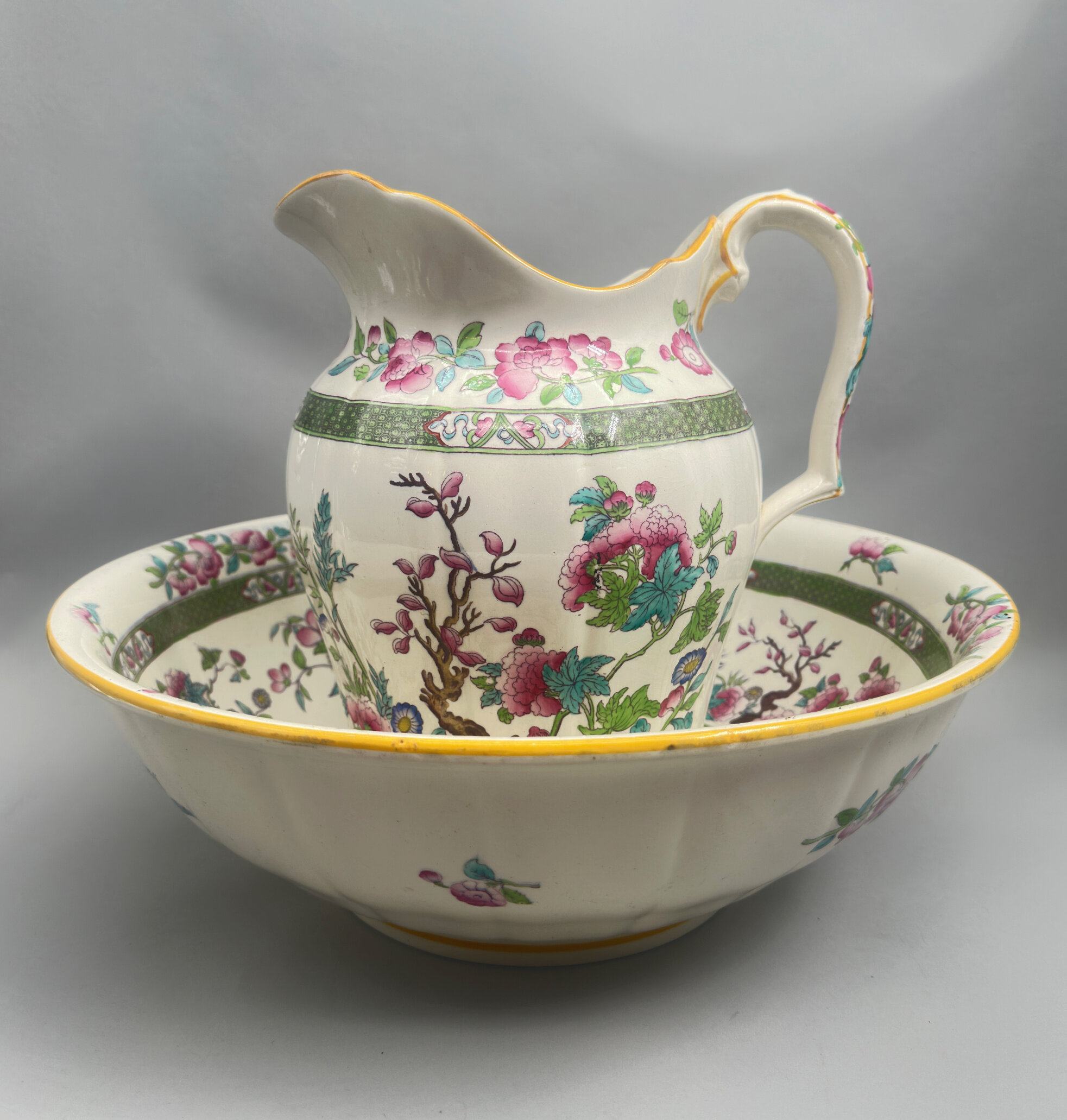
Minton Indian Tree Pattern Pitcher and Basin circa 1900
Price: £350………………………………………………………………………………………………….................................................................................
The celebrated firm of Mintons was founded by in 1793 by Thomas Minton (1765–1836) at Stoke-upon-Trent, Staffordshire, England as ‘Thomas Minton and Sons’, producing earthenware. The initial ranges were standard tablewares in blue transfer-printed or painted earthenware, including the ever-popular Willow pattern. By the mid nineteenth century and in partnership with Michael Hollins, Mintons began the production of decorative finishes for the interior and in particular floor tiles which enjoyed enormous demand and were the subject of numerous prestigious commissions including a contract for the flooring of the American Capitol. This was followed by the introduction of the plain white glazed ‘Parian’ wares and then the Italian inspired ‘majolica’ pieces with their richly coloured lead glazes. Mintons continued to follow popular trends, working with Christopher Dresser, recruiting Louis Solon from Sevres who had developed pâte-sur-pâte wares and finally contributing to Art Nouveau ceramics with a speciality in secessionist wares.
But the manufacture of tableware continued alongside all these other developments and Mintons adopted and adapted the popular ‘Indian Tree’ pattern which was first produced by Coalport in 1801. This design fused elements from Indian textiles and Chinese ceramics into an amalgam with immediate appeal. The pattern includes the crooked branch of a tree and a partial landscape including exotic flowers and leaves with a palette of colours emphasising green, blue, pink, and orange, resembling quite closely the Chinese export wares decorated in ‘Famille Rose’ enamels which had been exported to Europe in great quantities in the eighteenth century. Many of Coalport’s rivals, including Spode, Wedgwood and Royal Worcester produced their own versions of the design, but Mintons’ interpretation was held to be one of the most successful.
It was used by Mintons to decorate a variety of shapes, mainly dinner and tea wares, but the toilet pitcher and matching basin are seldom found in this pattern. Both the forms are extremely elegant, the pitcher with light fluting, a scalloped rim and a complementary handle, while the basin, also lightly fluted, employs simple lines with a turnover rim which follow the shape of a Chinese original. All the standard elements of the pattern can be seen, in particular the twisted tree, and the diaper work borders again reflect Chinese originals.
Both pieces are marked with the pattern number ‘T 216’ and a Minton stamp, the form of which allows fairly accurate dating. The globe topped by a crown with the banner ‘Mintons’ was used from 1873-1912 but ‘England’ was only added after 1891, giving a circa date in the late nineteenth or early twentieth century, probably around 1900. The original toilet set, which would have included the pitcher and basin along with, probably, a chamber pot, a soap dish, candlesticks and other accessories, was clearly a ‘deluxe’ item at the time and its quality is still apparent today when it can be enjoyed simply for its decorative appeal and as a reminder of a past era of grandeur.

Set of Three Empire Porcelain Company Biscuit Jars circa 1900
Price: £120The Empire Porcelain Company was established in 1896 at the Empire Works in Stoke Road, Hanley, Stoke on Trent. A wide range of pottery and porcelain was subsequently produced until the factory’s closure in 1967. The various marks include the initials EPC, EP or the word Empire. The form of the mark seen here occurs on the earliest pieces made between 1896 and 1912. Blue ground pieces with mythological scenes were produced in a variety of forms during this period, some decorative, such as ornamental vases, and some more practical, as here : modest but graceful accessories for the Edwardian drawing room.
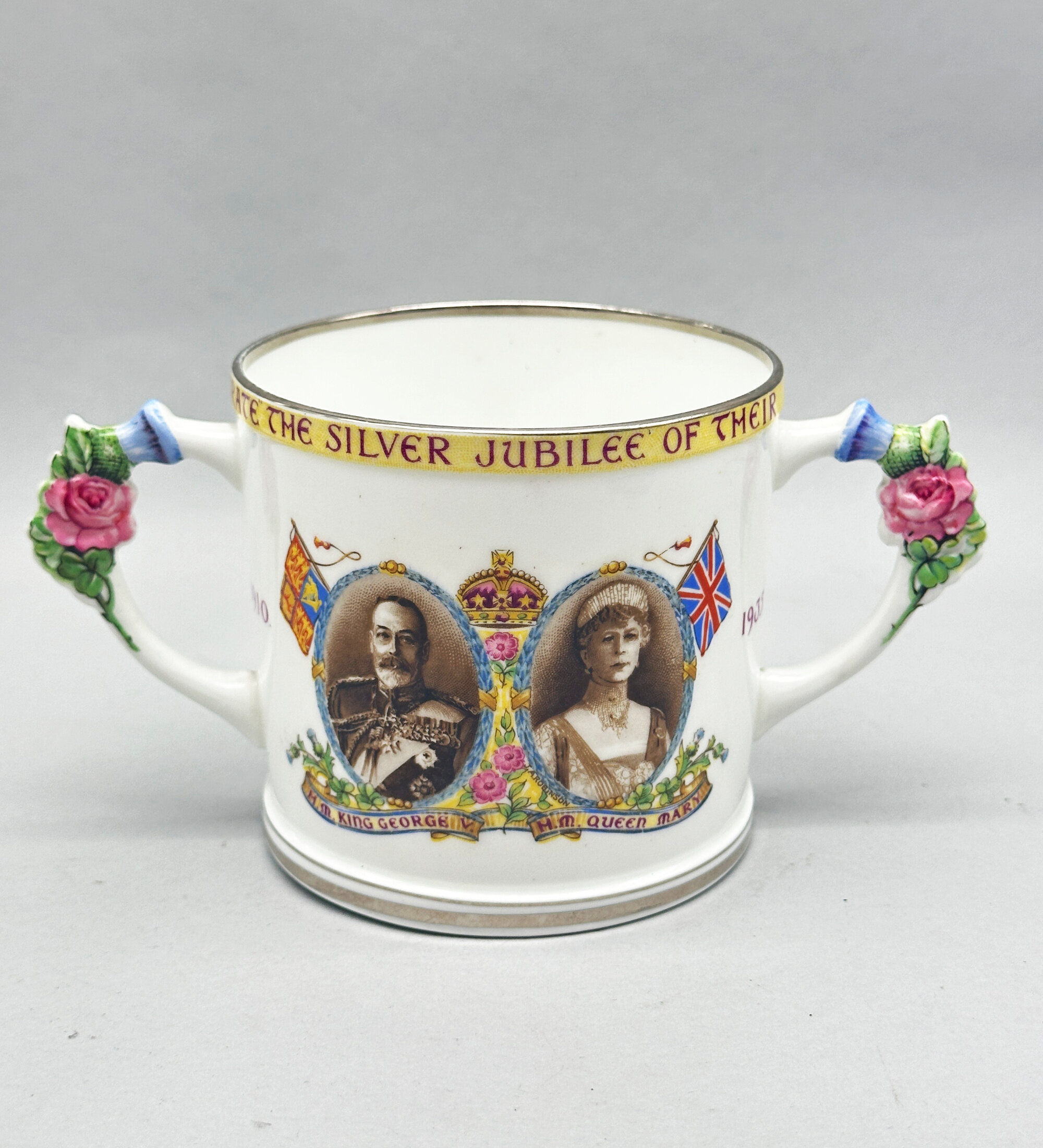
Cup Commemorating the Silver Jubilee of King George V and Queen Mary in 1935
Price: £55The Paragon China Company, formerly the Star China Company (see Lot XX), produced high quality gift items from 1920 to 1971, at first independently and then in alliance with other companies, finally being absorbed by Royal Doulton in 1972 who kept the ‘Paragon’ name until 1991. Commemorative wares were a speciality and this cup is a fine example.

Pair of continental style openwork border Dishes, probably Chinese C20th
Price: £20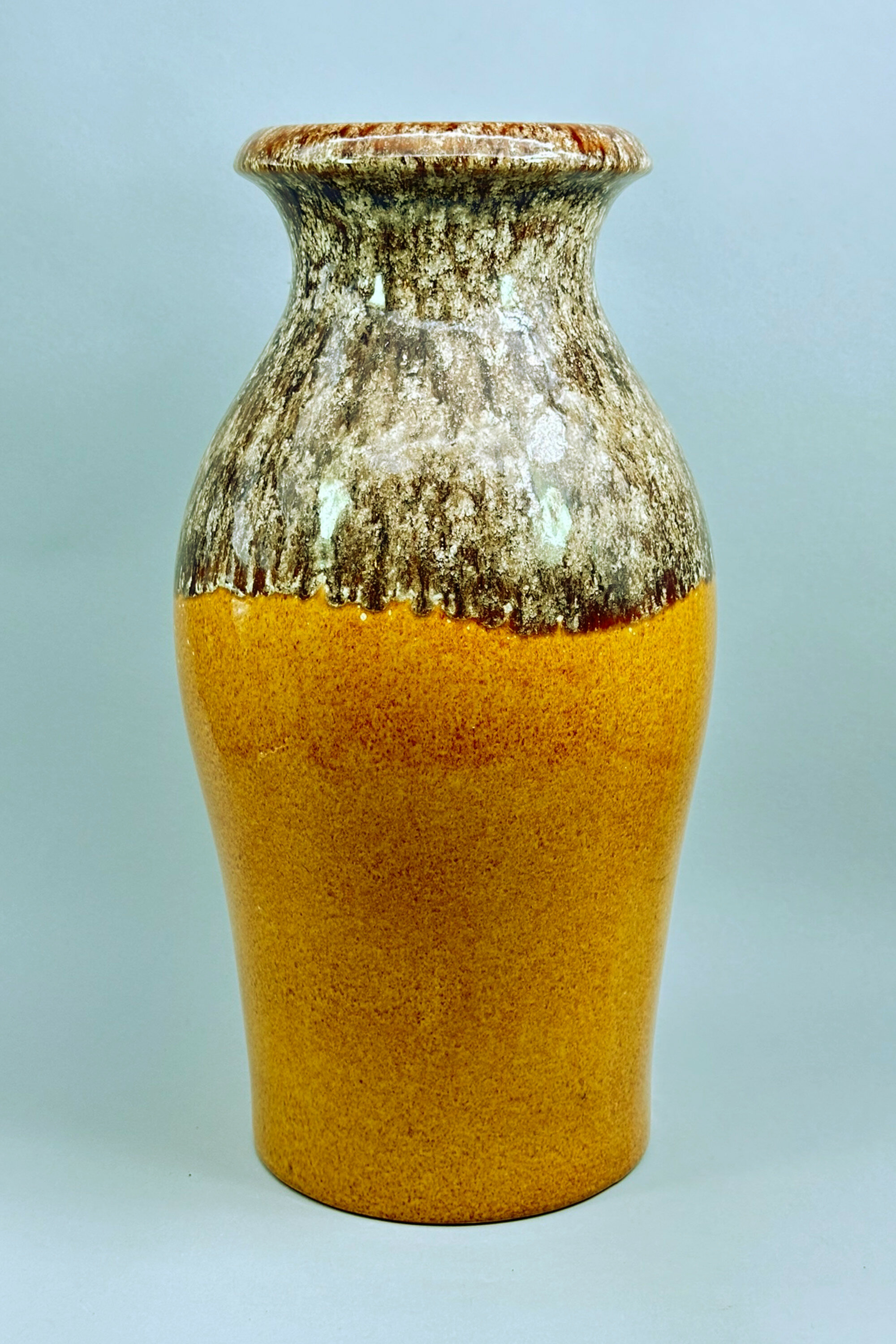
West German ceramic Vase, Scheurich, No 290-40, 1960s
Price: £55Although not marked as such, this vase has all the hallmarks of the firm Scheurich Keramik which started production in 1954, rather later than most of its competitors, but soon became the largest producer of commercial art pottery in Germany. Their pieces rarely carried the factory name but usually the model number followed by the height in centimetres with ‘W.Germany’ below, as here. Scheurich were well known for producing a wide variety of pieces with variegated, almost experimental glazes and this vase is yet another successful example of their work, the simple lines of form combining with a more austere selection of glaze effects than found in some of their other pieces. Dating is to the 1960s.
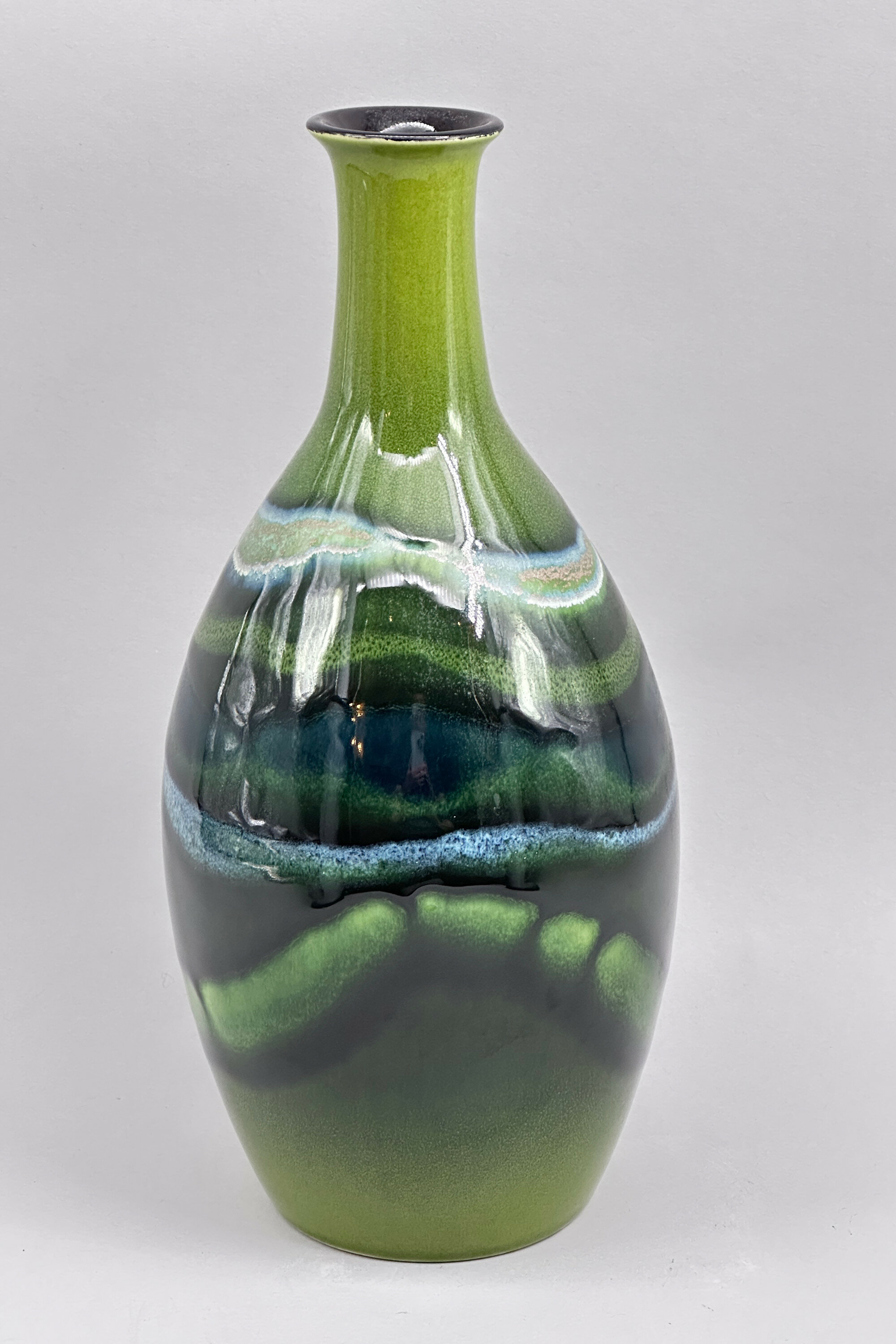
Poole Pottery Maya Pattern Bottle Vase, early C21st
Price: £85This fine quality vase is from the Maya range made by Poole Pottery, some of the pieces still being in production today and described in the maker’s catalogue as follows “Poole Pottery’s Maya collection is inspired by British landscapes and earthy tones. The greens and blues in this stunning range represent the earth meeting the sky in a natural yet bold design. Here at Poole Pottery, all our Maya ceramics are hand-cast and made using our signature reactive glaze in the famous Middleport Pottery in Staffordshire. The distinctive pieces you see here are created via our Living Glaze technique, where layers of colourful glazes react with one another to create a unique, glossy and dynamic finish.” But this particular form does not appear in the current catalogue and does not seem to be otherwise available. The form of the mark appears on other Poole pieces of more recent manufacture and dating is probably to around twenty years ago. The initials are for the artist’s signature and Poole write “Items are personalised with the artist's own individual mark, adding value to the collectability of each piece.” Given its scarcity, this vase would make an interesting addition to a collection of Poole Pottery aside from being a highly decorative item in its own right.
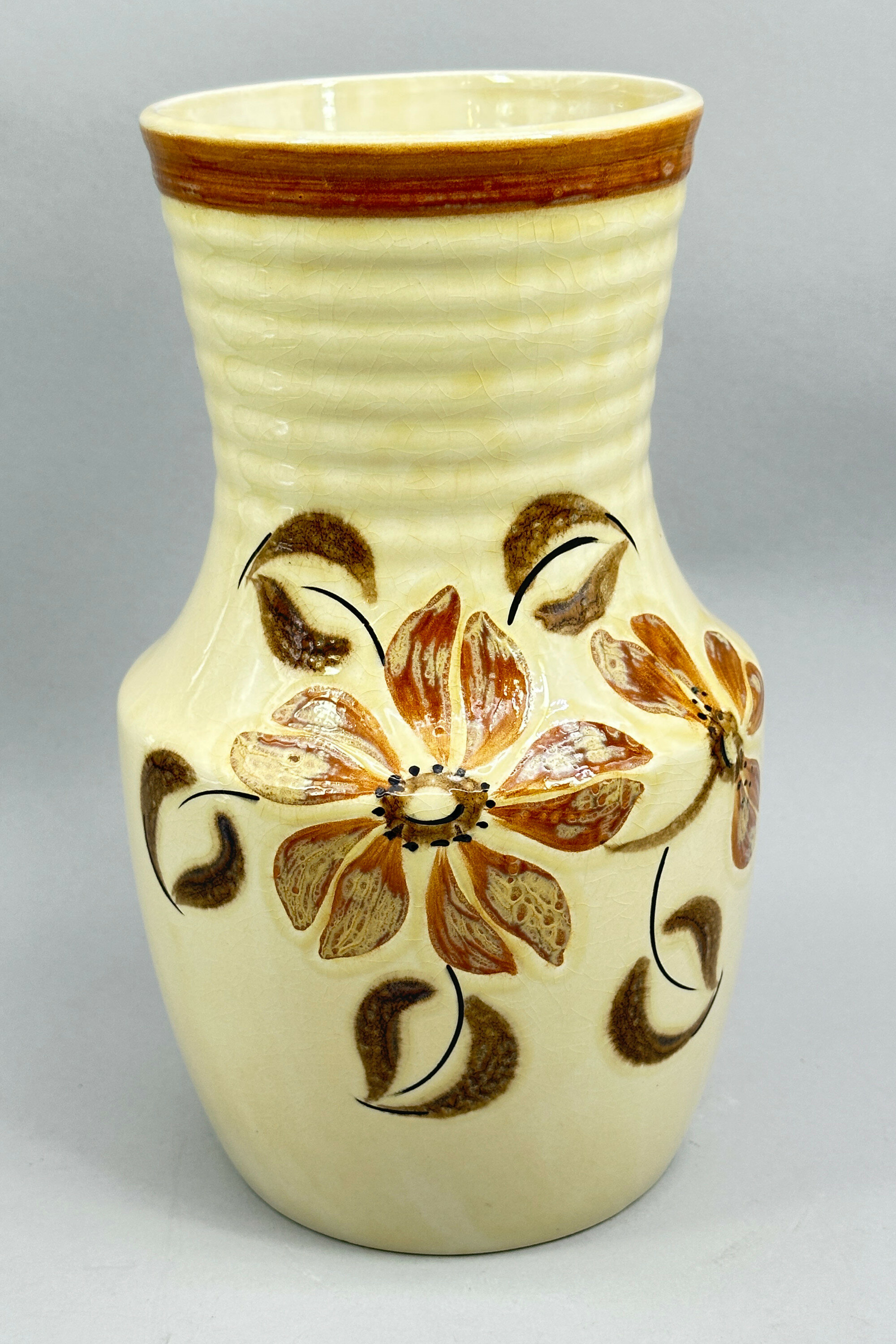
Vase with signature E.Radford and numbered 1267, mid C20th
Price: £45There were, in fact, two craftsmen working in the C20th British pottery industry with the name Edward Radford, father and son. Radford senior worked for Pilkington’s Royal Lancastrian Pottery in Manchester from 1903 until his retirement in 1936, acting as their main thrower. Radford junior joined his Father in 1905, but the First World War intervened, in which he won a Military Cross for his actions at Passchendaele in 1917 and afterwards he settled in Stoke on Trent, the heart of Britain’s pottery industry. An association developed with H.J.Wood’s Alexandra Pottery in Burslem who produced a range of wares bearing his name in the 1930s, although Radford himself may have acted as more a salesman than the designer. Production continued after the war and even after Radford’s retirement in 1948. The form of mark used here implies a later dating and both the shape, indicated by the model number underneath which is found on other vases with different decoration, and the decoration itself suggest the post war era, probably in the 1950s. There is, though, a modest charm here which would blend comfortably with a modern interior.

Doulton Vase with geometric and floral designs, late 1920s
Price: £75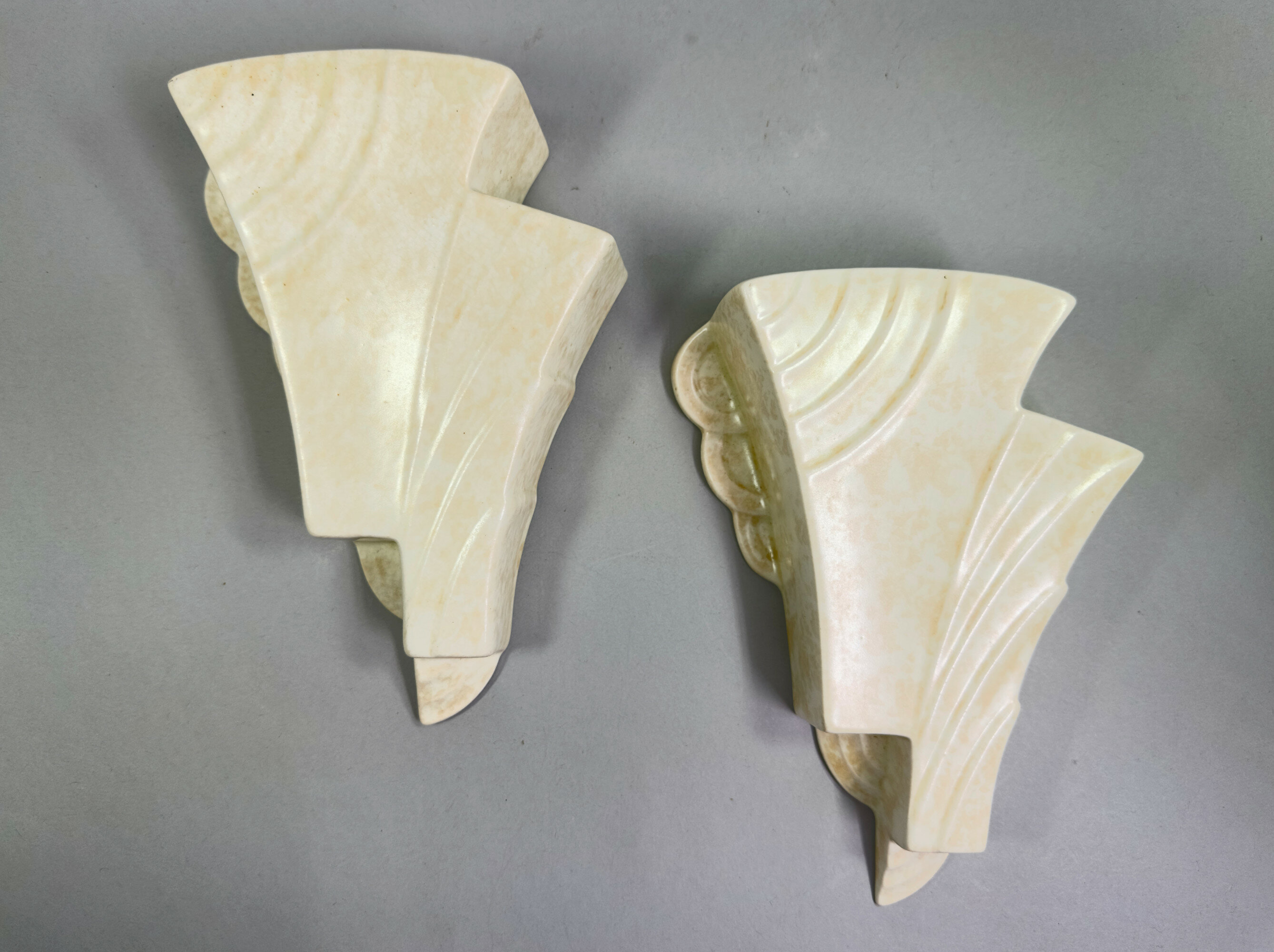
Pair of Art Deco Style Wall Pockets, C20th
Price: £55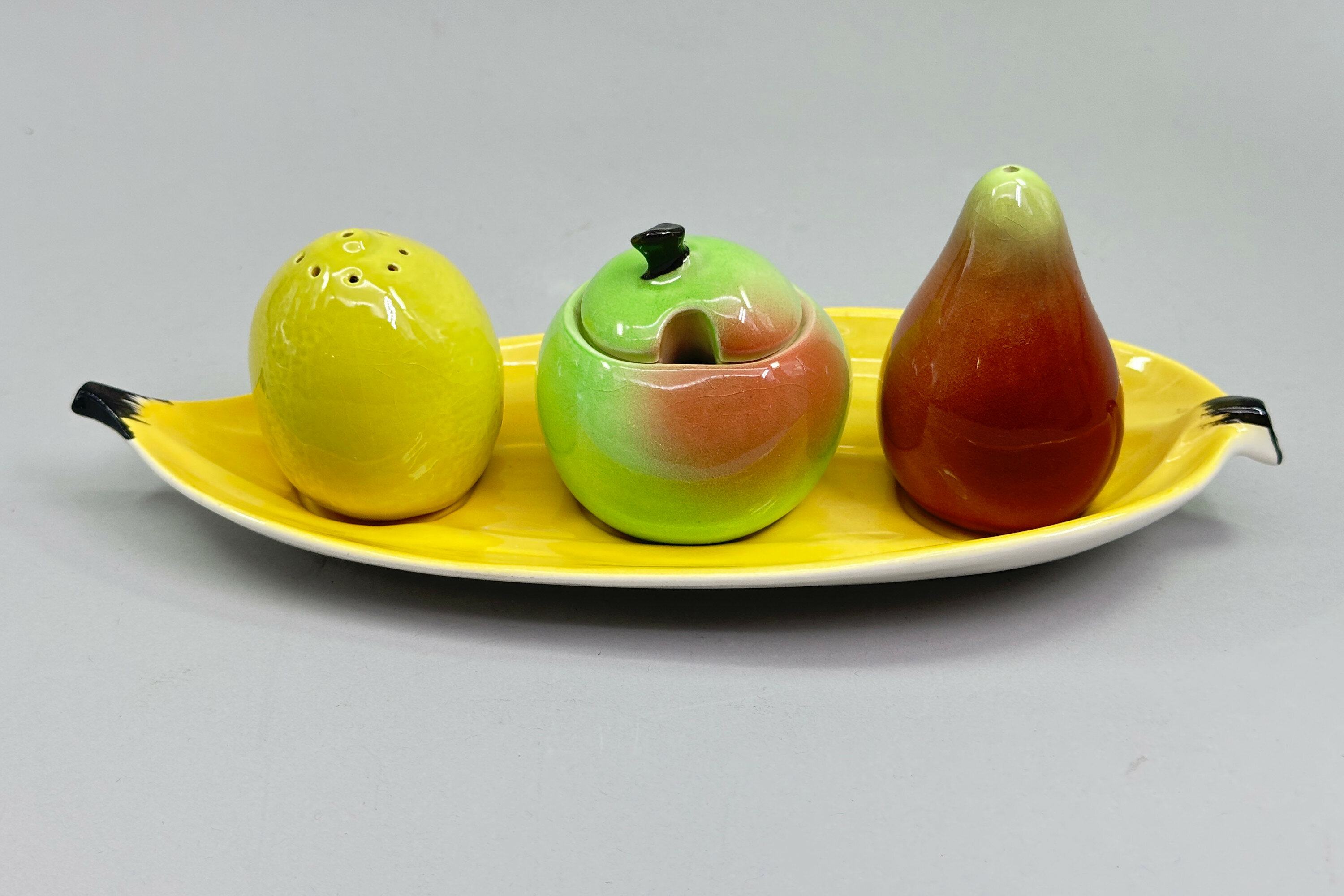
Carlton Ware fruit Cruet Set, Australian Design, 1950s
Price: £35Carlton Ware was the trade mark used by the pottery manufacturer Wiltshaw and Robinson, whose premises were located in Stoke on Trent, four years after the firm’s establishment in 1890. The well known script mark was introduced in 1928. The firm mostly concentrated on decorative giftware and new methods of production introduced in the 1920s put it at the forefront of the earliest Art Deco pottery pieces produced, firstly with designs originating from Tutankhamun’s tomb and then with pieces with an Oriental chinoiserie influence. Tablewares were also produced and this cruet set is an example of the imaginative designs made after the second world war and most likely dates to the 1950s. The appeal is obvious and today this set, complete with the original stoppers for the salt and pepper, can fulfil both a practical and decorative function.
Some examples appear to have an original matching spoon for the mustard pot; if that is the case, then it is absent here, but the spoon often illustrated looks quite generic and may not necessarily have been an integral component.
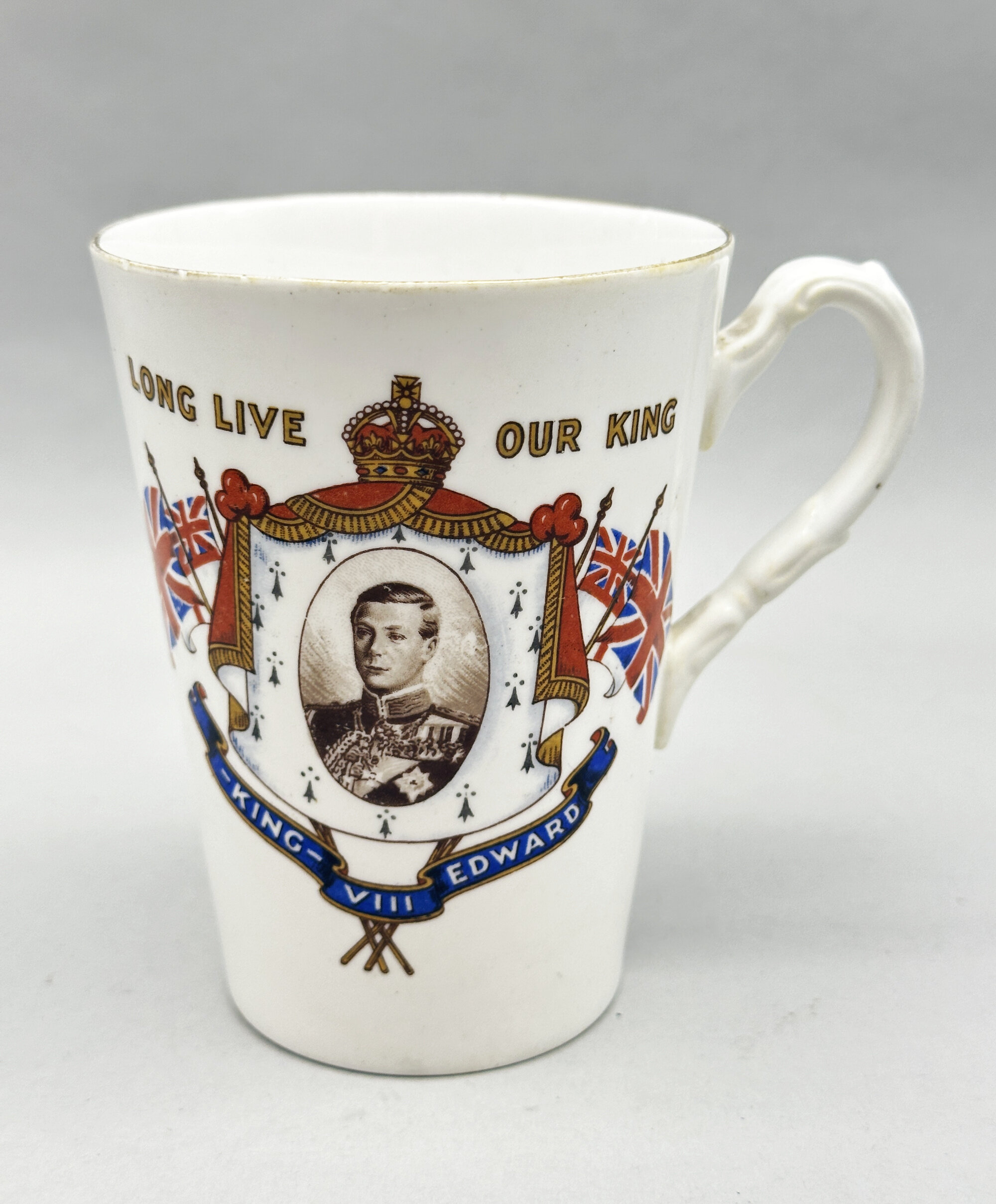
Mug Commemorating the Coronation of Edward VIII in 1937
Price: £25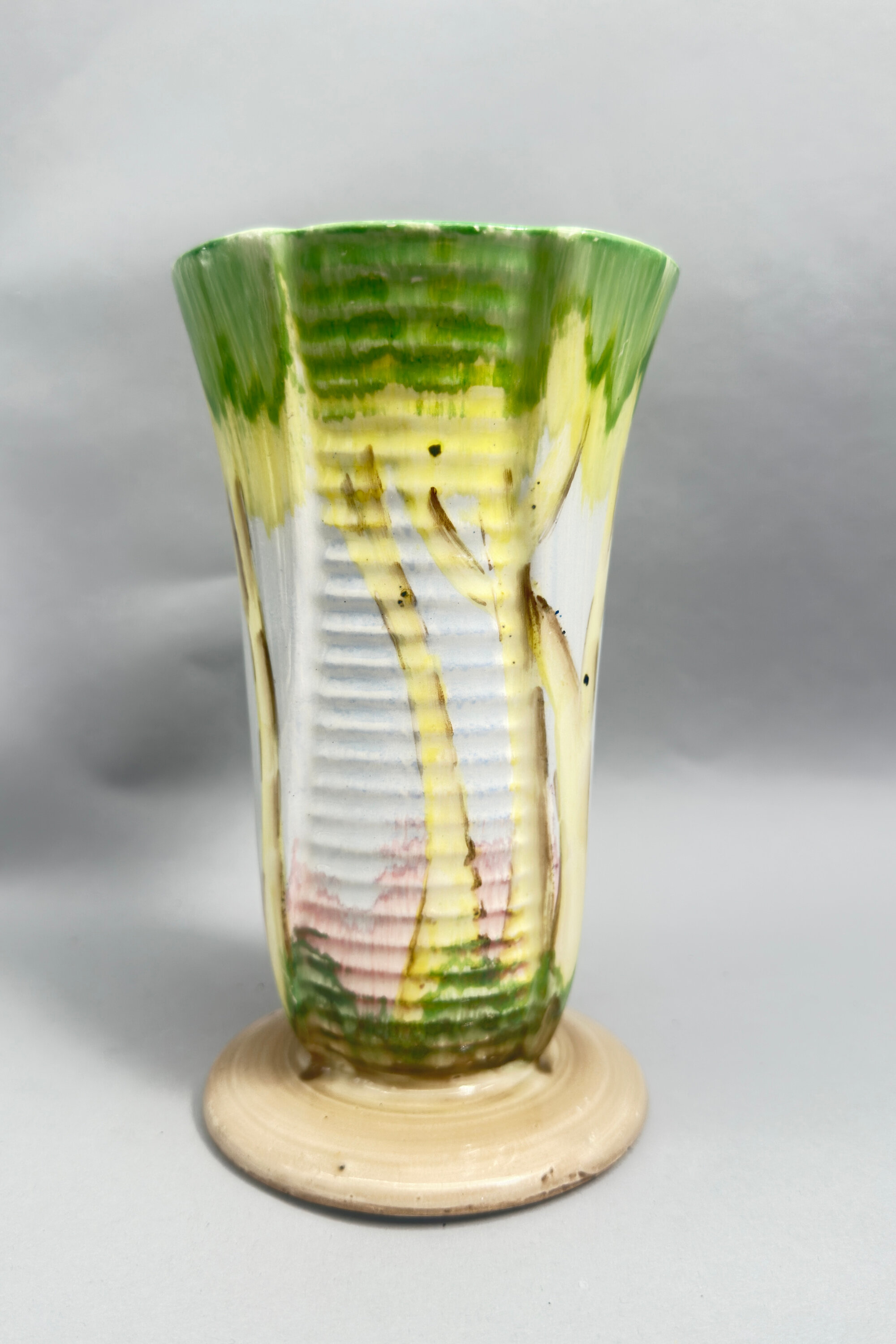
Art Deco style beaker form Vase, probably Beswick, mid C20th
Price: £35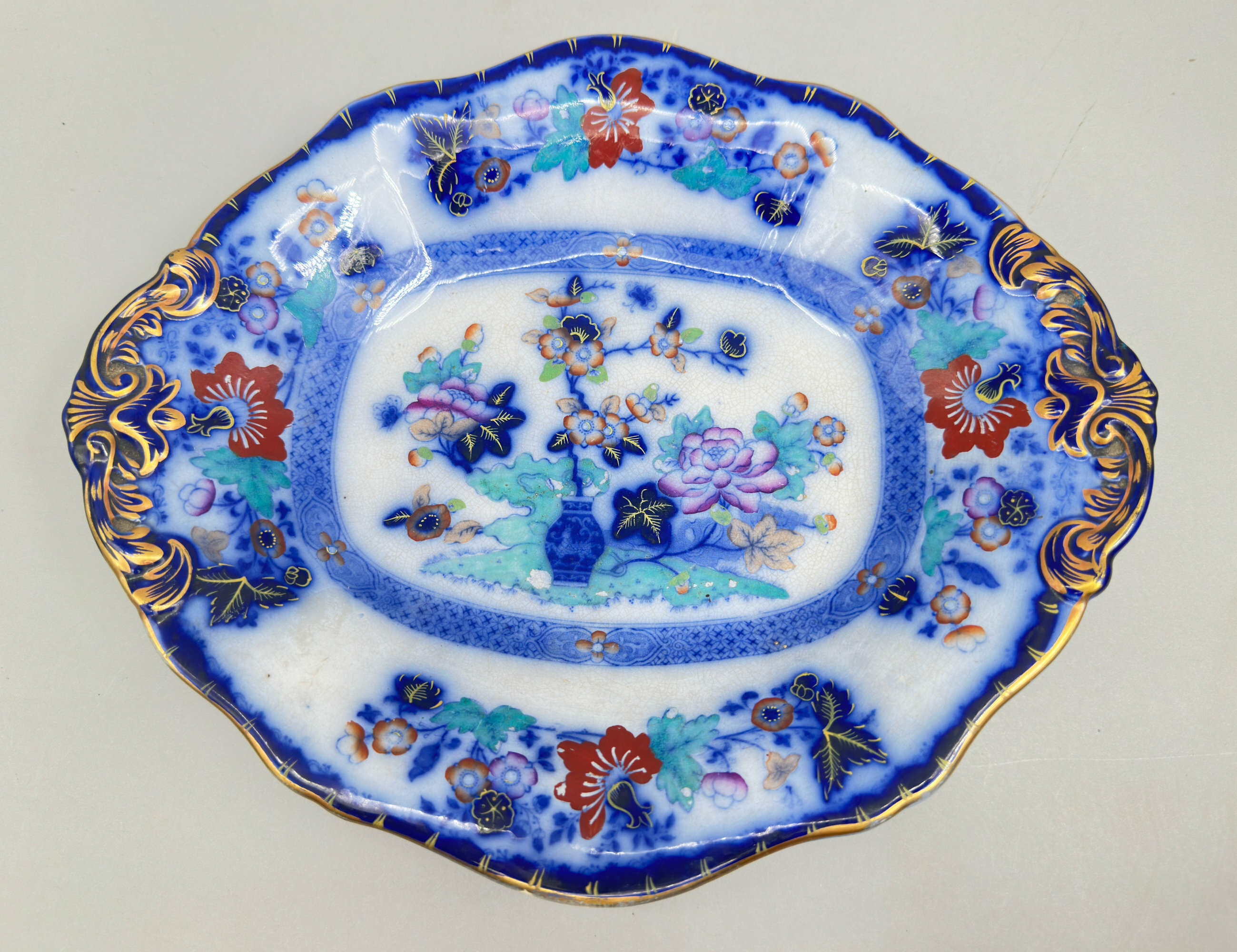
Bombay Japan pattern deep Dish, Minton or Samuel Alcock, English mid C19th
Price: £25
Oriental Style Vase, West German Pottery, possibly Scheurich, late C20th
Price: £45
West German Bay Keramik Pitcher with stylised floral designs, late C20th
Price: £55Founded by Eduard Bay in the 1930s and based in Ransbach Baumbach in the heart of the main West German pottery producing region, Bay Keramik grew to be one of the most prolific producers of ceramics in the ‘West German’ style and continued production into the 1990s. This piece retains its original paper label and the format of this allows dating to the 1970s/1980s. The jug has almost a slightly rustic feel and recalls much earlier German ceramic items. The numbers on the base indicate the form number but it has not been possible to identify this.

Yellow ground Bursley Ware Dragon Bowl by Frederick Rhead, circa 1920
Price: £55

Chinese style Vase and Cover decorated with ladies and courtiers in a garden scene, C20th
Price: £55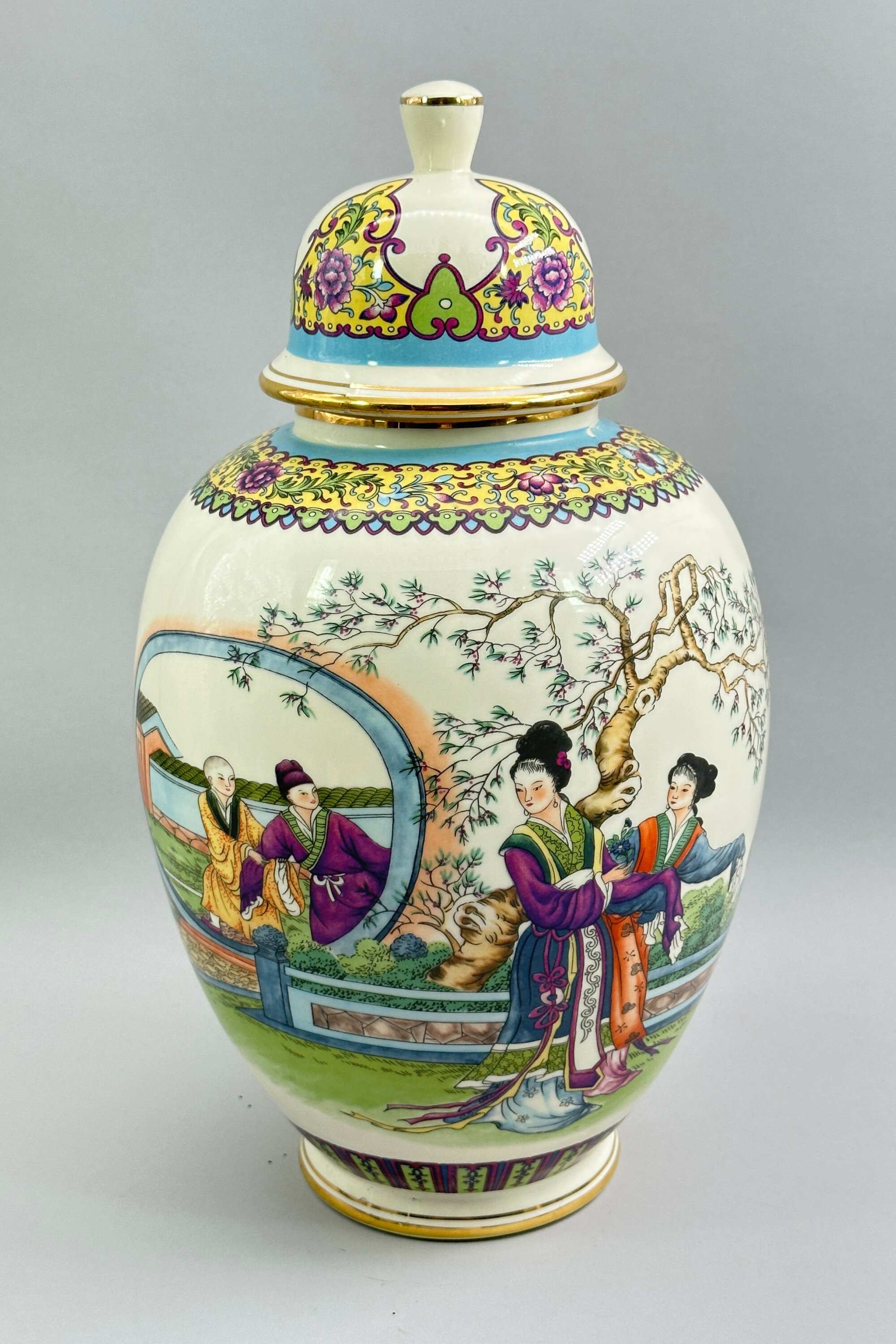
Chinese style Vase and Cover decorated with ladies and courtiers in a garden scene, C20th
Price: £55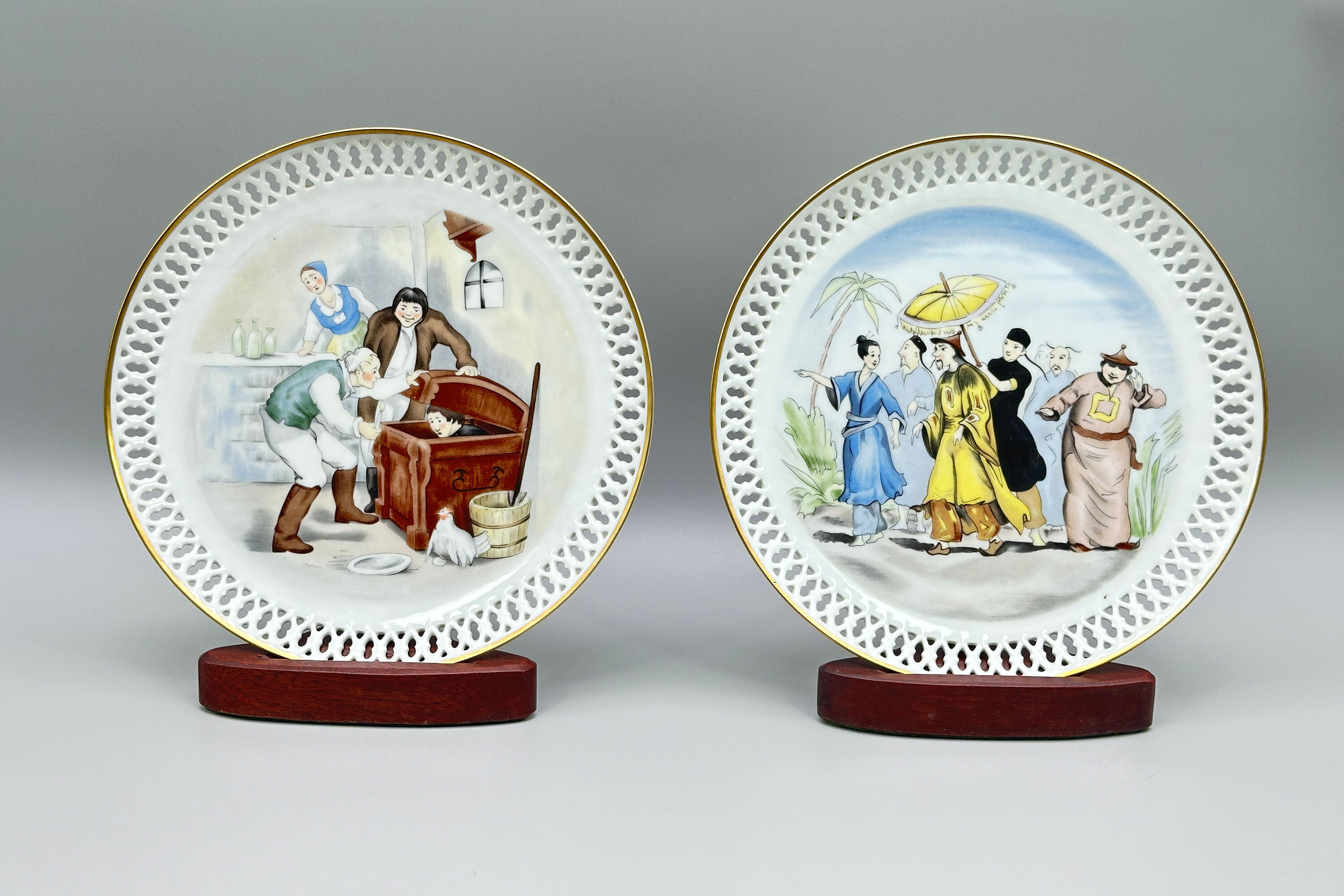
Two Bing & Grøndahl plates, scenes from Hans Christian Andersen, late C20th
Price: £45Bing & Grøndahl was established in 1853 by the sculptor Frederik Vilhelm Grøndahl and the merchant brothers Meyer Hermann Bing and Jacob Herman Bing. Their trademark, which can be seen on these two plates, was that of three towers, which was derived from the Coat of Arms of Copenhagen. Their designs proved popular and it is said that their dinnerware service in the ‘Seagull’ pattern could be found in one in ten Danish households in the 1950s. Eventually, in 1987 the company merged with its competitor, the Royal Porcelain Factory, under the name Royal Copenhagen, but some of the pieces produced thereafter still display the initials ‘B&G’ and the three tower symbol, as here. Originally sold with fitted boxes (not included here), these plates were probably produced in the early years after the merger and are sought after as collectors’ items today.
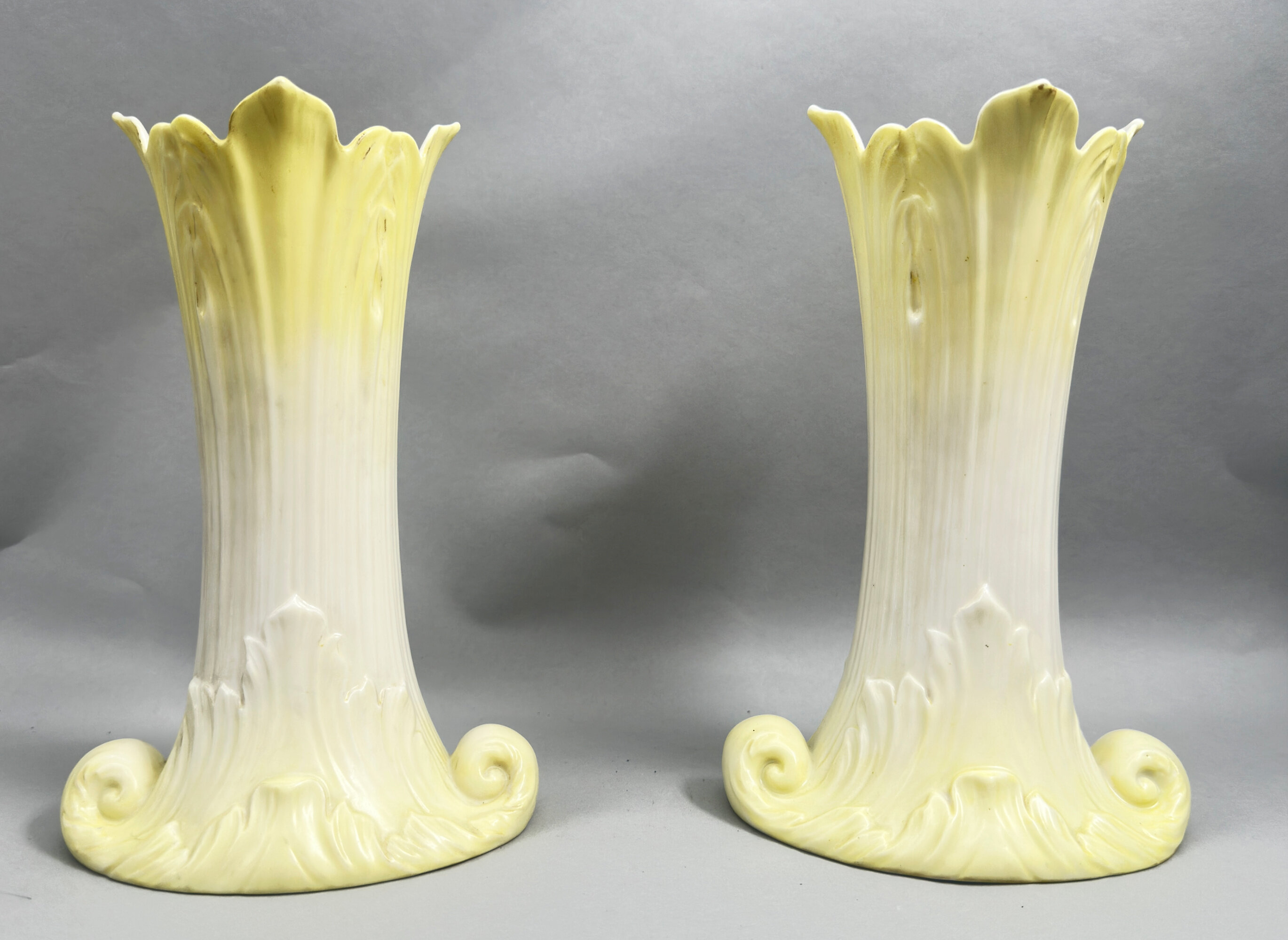
Pair of Royal Worcester Grainger and Co Vases, date mark for 1902
Price: £150The influence of the Art Nouveau movement, with its emphasis on organic and plant forms, is clearly seen here. The vases date to the early 1900s and were made by the ‘Grainger and Co’ branch of the celebrated Royal Worcester factory. The first porcelain factory at Worcester was set up in 1751 by John Wall (a doctor) and William Davis (an apothecary), along with 14 other businessmen. Fifty years later in 1801 Thomas Grainger (1783–1839) started a rival company ‘Grainger’s Worcester Porcelain’ and during the nineteenth century both companies traded successfully. However following the death of George Grainger, the son of Thomas Grainger, in 1889 the Grainger factory was sold to Royal Worcester who continued manufacture on its old rival firm’s St.Martin’s Gate site until finally closing the works in 1902. Ivory style porcelains were one of the specialities of this brief manufacturing period and the date mark ‘L’ which appears on these vases is for the year 1902, just before the two concerns were completely merged.

An Art Deco ceramic group of two Fish by Guido Cacciapuoti, signed, 1930s
Price: £150Guido Cacciapuoti was a celebrated Italian ceramicist. Born in Naples in 1892 and from a family with a tradition in the creation of majolica pottery, Guido exhibited his work widely in the 1920s and finally, in collaboration with his brother, Mario, and Angelo Bignami as the administrative and commercial director, he founded the factory ‘Gres d'Arte Cacciapuoti Bignami & C.' in Milan in 1927. Mario unfortunately died three years later leaving Guido to carry on on his own until his death in 1953.
In the 1930s, Guido’s workshop became famous for the production of ceramic animal sculptures with fish being a particular speciality. More commonly seen are groups of John Dory, again with a red glaze, but the smoother lines here and the particularly intense colour reflect more closely the contemporary Art Deco style. Sought after in their own time, with patrons such as the King of Italy and Mussolini, Guido’s works are highly collectible today and this group would make a striking addition to a collection of Art Deco ceramics with considerable decorative appeal.

Ceramic and Bronze figure of a Blue Tit, Albany Worcester, late C20th
Price: £35
Doulton and Slaters Patent Jardiniere circa 1890
Price: £750The Doulton factory began production in 1815, first at Vauxhall and later moving to Lambeth. In 1882 it opened an additional factory at Burslem, Stoke on Trent in the centre of the English pottery. Known at first mainly for utilitarian works it began to develop decorative wares more extensively in the 1860s and soon gained a reputation for its distinctive designs. As the mark indicates, this piece was made at the Lambeth factory and the absence of ‘England’ in the Doulton mark, which has the typical design of interlocking ‘D’ at its centre, indicates that it dates to before 1891. The decorative technique, employing impressed designs was known as ‘Chine’ ware and protected by the patent ‘Doulton and Slaters Patent’ which is clearly marked underneath. Pieces of linen, lace, net or other fabrics were pressed onto the unfired soft clay shortly after potting, leaving a corresponding pattern behind. This piece has elaborately modelled lotus strands in addition as well as gilt flower heads, an unusual combination which does not seem to often occur. On the base are found stamped numbers and letters which should indicate the pattern number and artist decorator but it has not been possible to identify these accurately. Dating though is confirmed and this was clearly a deluxe item amongst the range of pieces produced at that time.

Pair of Ceramic Figures of Swans, probably continental, C20th
Price: £45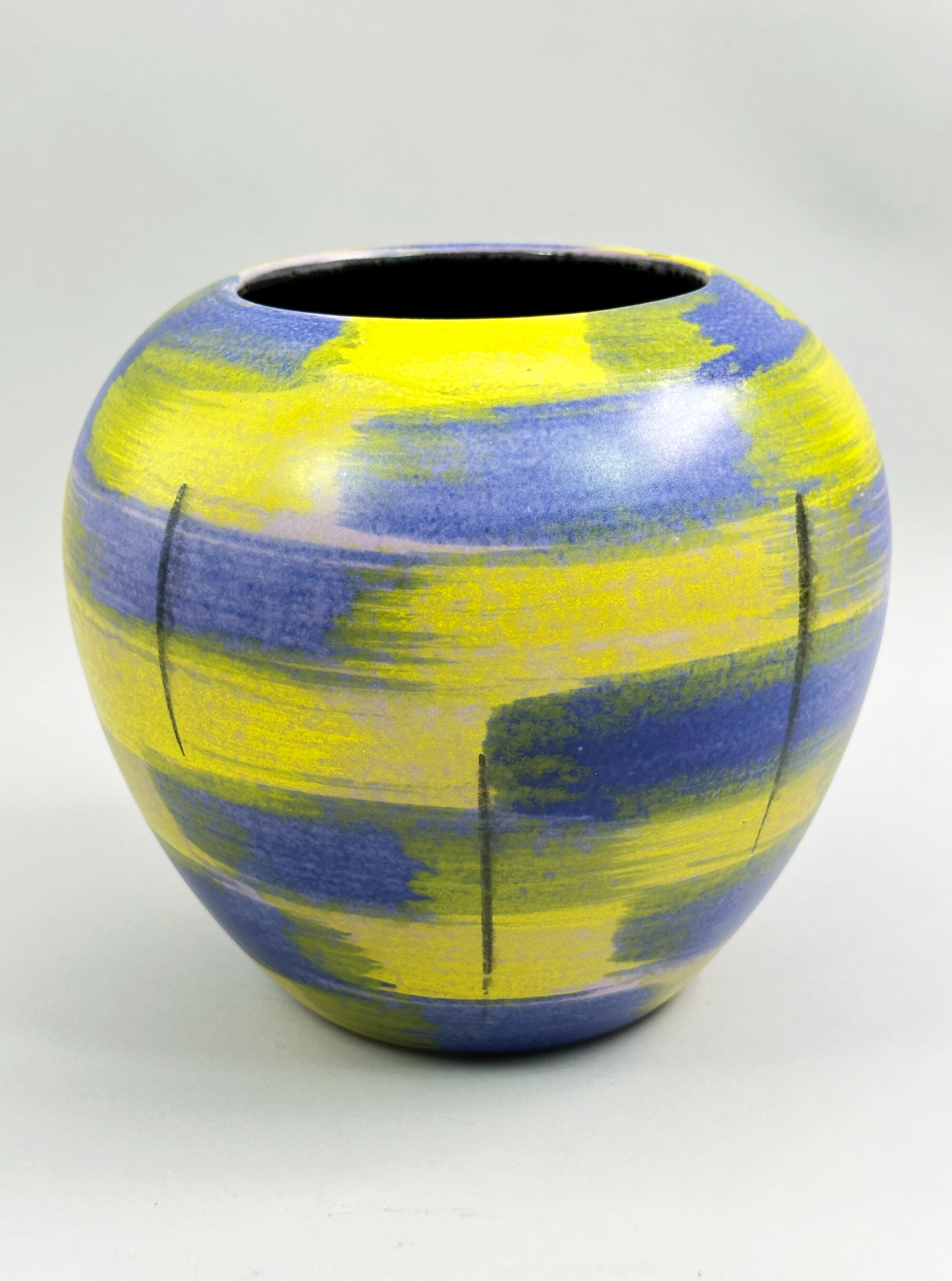
East German Ceramic Vase, VEB Haldensleben, 1950s
Price: £35The factory mark, a shallow dish superimposed over the letter 'H' inside a circle, is that of the East German pottery VEB Haldensleben. VEB stands for 'Volkseigener Betrieb', meaning a people-owned enterprise and used in relationship to the state owned workplaces in the GDR. Haldensleben is a town in Saxony-Anhalt, Germany and a ceramics factory was created there in 1945 with the nationalization of the Carstens Uffrecht plant that followed the division of Germany at the end of WWII. Halsdenleben focused primarily on the manufacture of vases. Its output tended to be of superior quality and employed more restrained glazes than those used by its West German counterparts. Upon the reunifucation of Germany in 1990, the factory was returned to its original owners, the Carstens family. The pattern number here is found on other pieces with the same shape but the abstract decoration used is quite individual and evocative of 1950s and early 1960s designs.
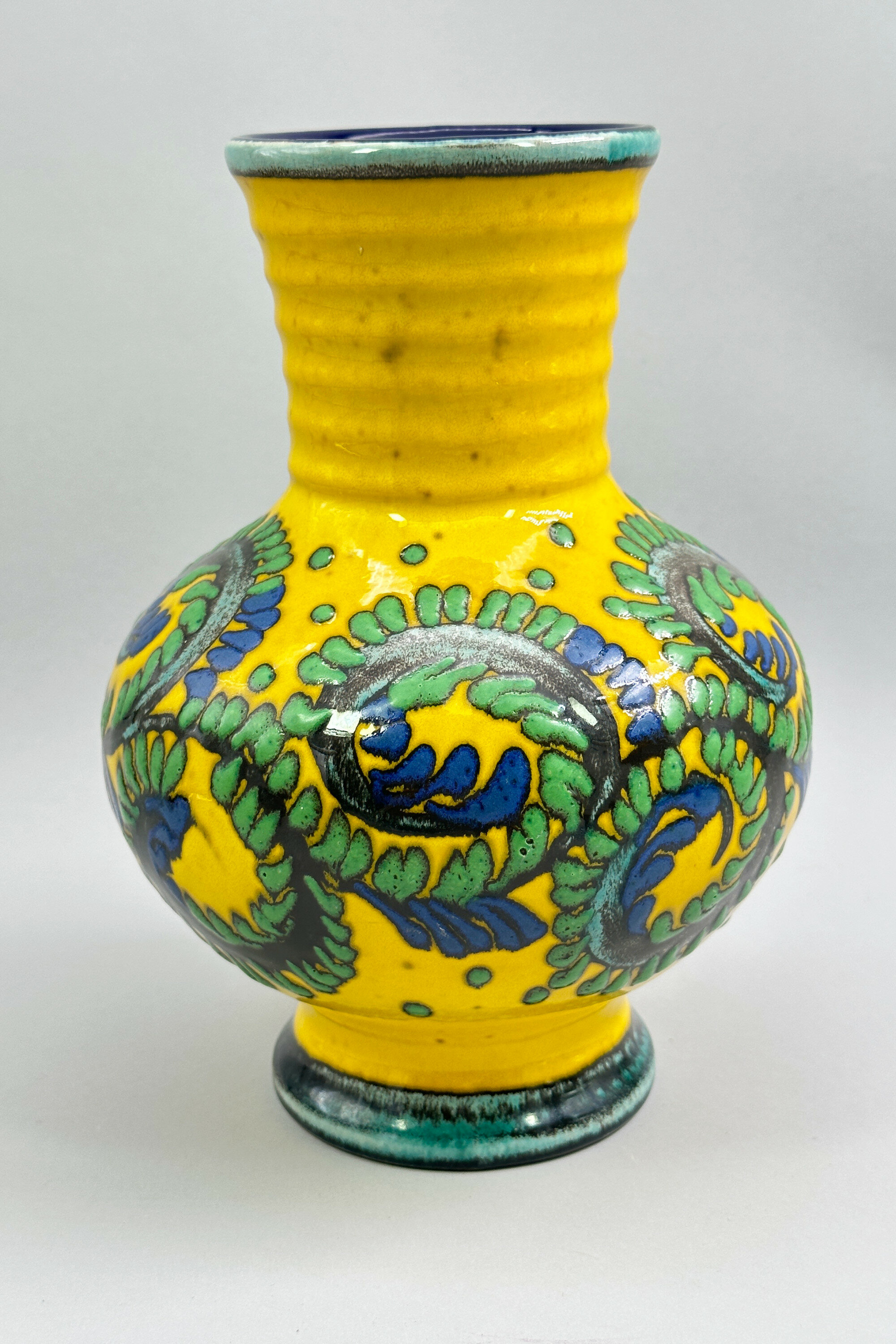
West German Ceramic Vase, Marei, 1970s
Price: £45While not stamped with a maker's mark, vases of this type are attributed to the West German Ceramics factory Marei which produced pieces from 1949 to 2016. Marei was the commonly used abbreviation for the firm's name which was Majolikafabrik Rheinbach Jean Fuss and Sohn. The pieces are distinguished by the use of a reddish clay but this was sometimes more brown or dark brown depending on the suppliers used. Marks are usually impressed into the base although these are often just pattern numbers, as here. Many pieces are unmarked and some are stamped 'MADE IN GERMANY' or 'W.GERMANY'. The pattern number here is '7104'and is found on similar pieces with the same shape but different decoration. This vase was probably made in the 1970s and is typical of the striking designs the firm produced.
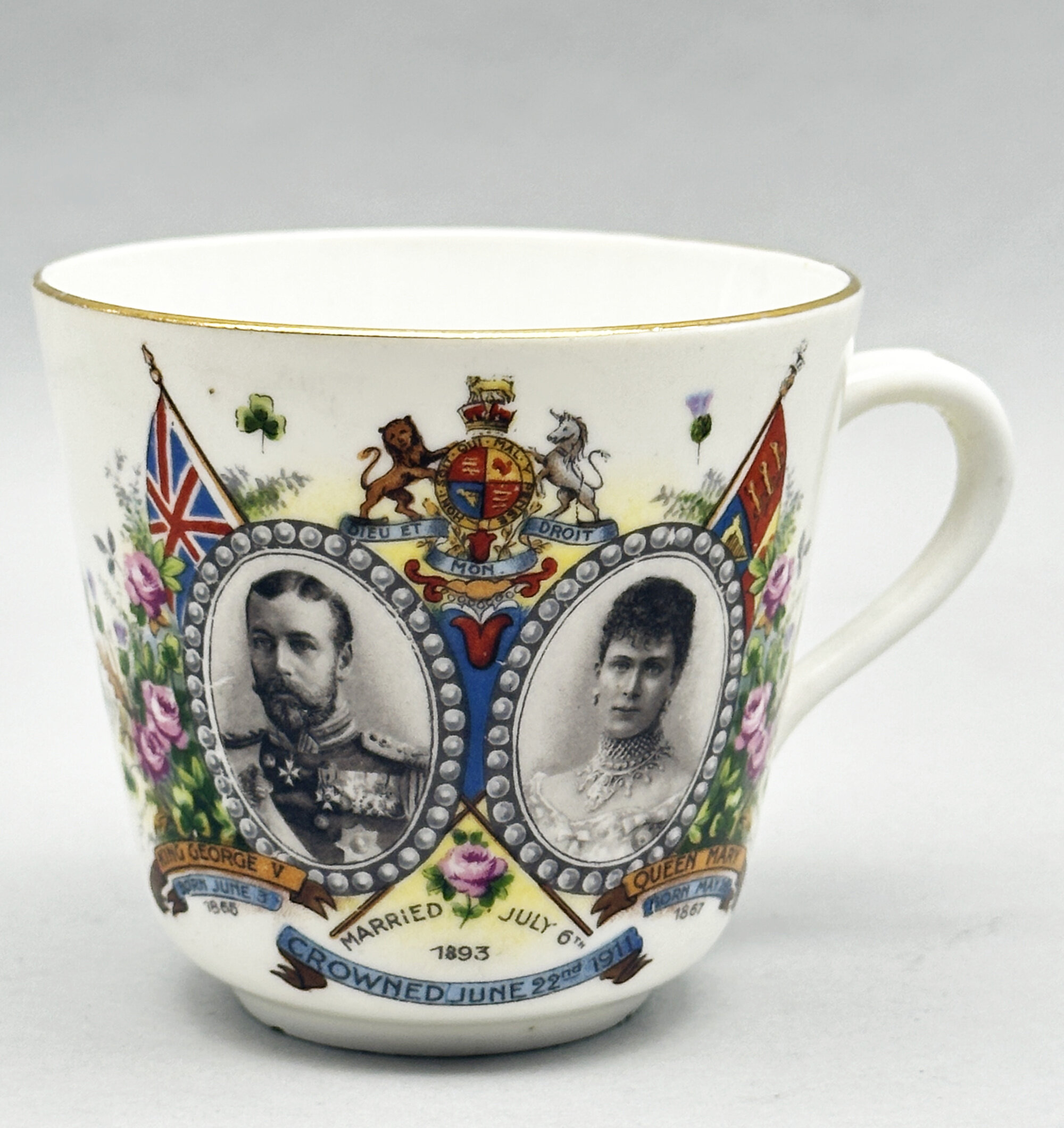
Cup : Marriage and Coronation of King George V and Queen Mary, 1911
Price: £10Production of this piece was presumably contemporary with the coronation in 1911 and many similar pieces were made by other factories at the time, more often in a straight sided mug shape. The form here suggests that there might have been an original saucer but none seem to have survived.
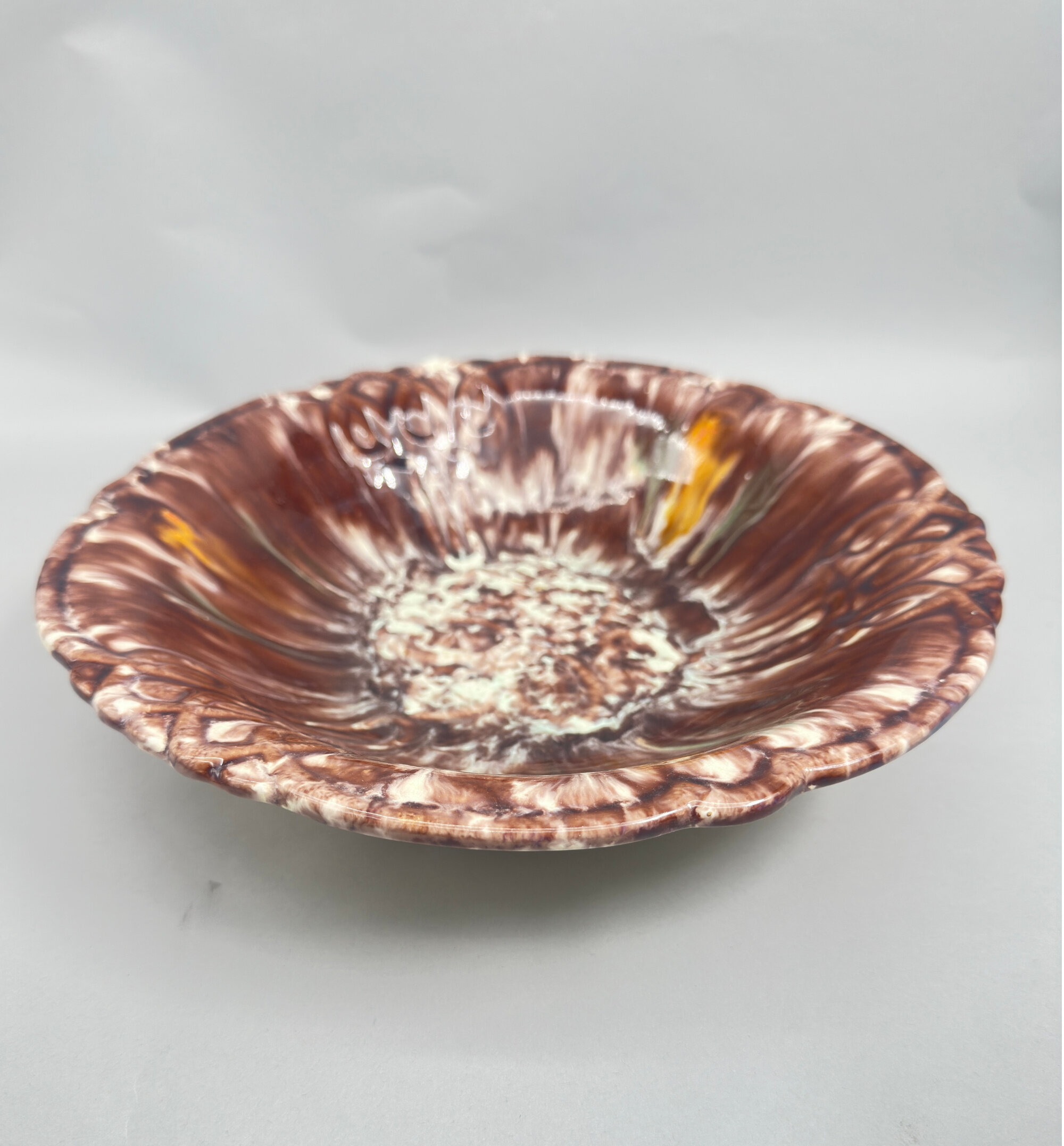
Majolica Footed Fruit Bowl, Germany, 1930s
Price: £55
West German Vase with drip glaze decoration, Scheurich, 1960s
Price: £45Although not marked as such, this vase has all the hallmarks of the firm Scheurich Keramik which started production in 1954, rather later than most of its competitors, but soon became the largest producer of commercial art pottery in Germany. Their pieces rarely carried the factory name but usually the model number followed by the height in centimetres with ‘W-Germany’ below, as here. Model ‘517’ can be found in a variety of different glazes but the colourings here with the contrast between browns and cream are particularly successful. Dating is to the 1960s.
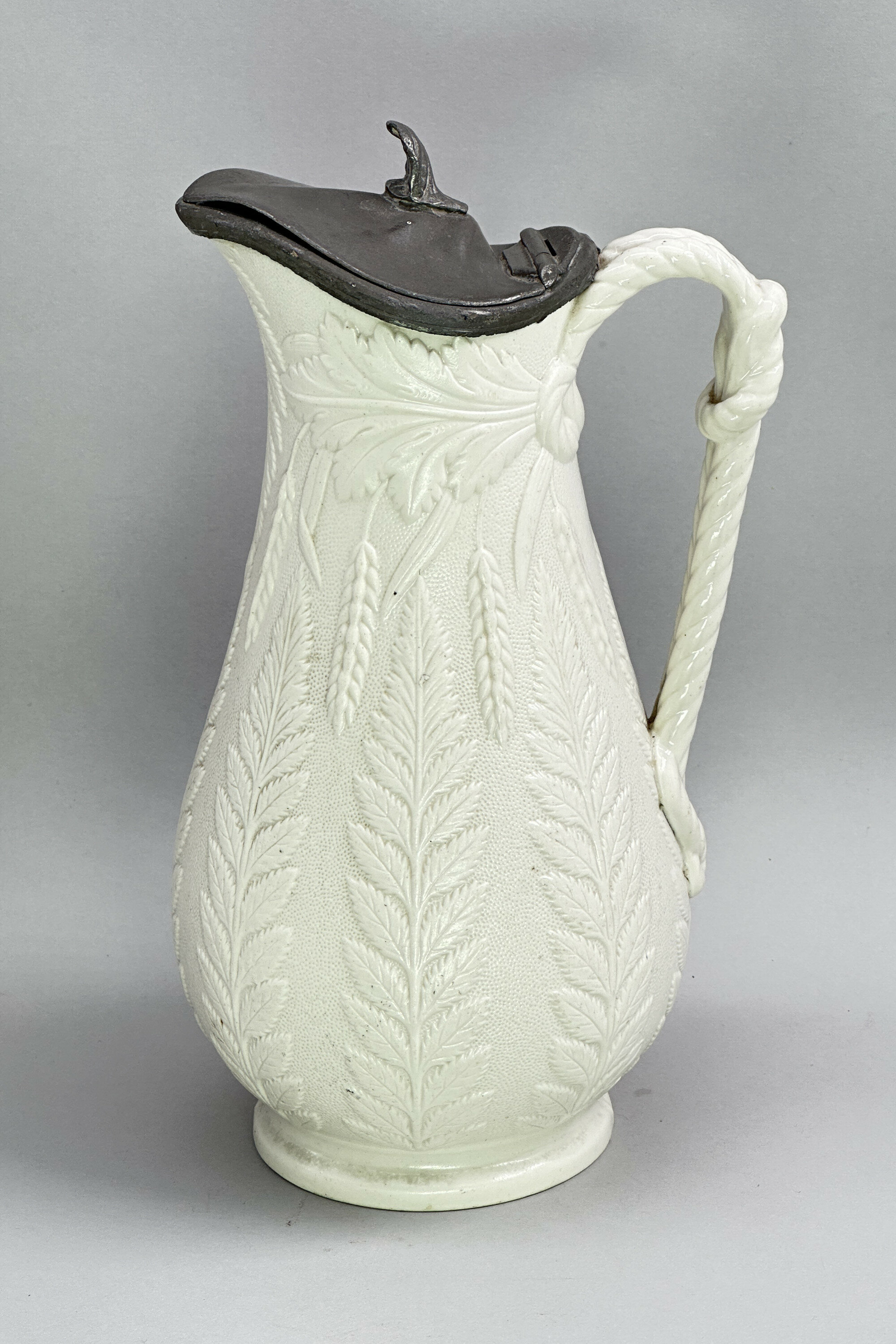
Antique English Staffordshire pitcher, William Brownfield and Sons, circa 1860.
Price: £55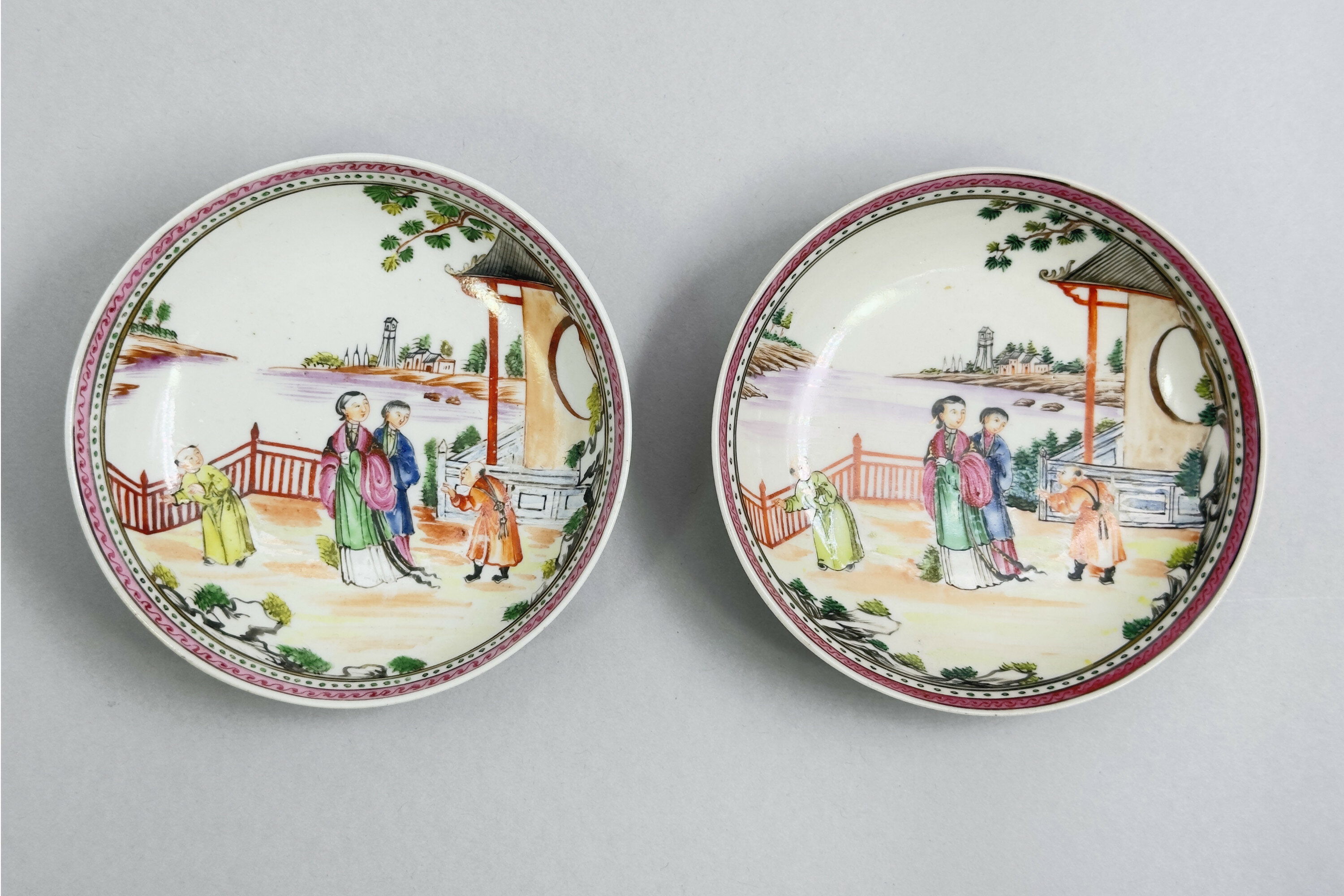
Pair of Worcester Saucers with Chinoiserie Decoration circa 1780
Price: £45While close to the Chinese originals, many features indicate European and indeed English manufacture, in particular the drawing of the ladies’ heads, the palette of colours used, the borders employed and, most importantly, the glaze and paste of the reverse. The most likely producer here was the Worcester factory whose ‘Mandarin’ pieces were well known and a circa date in the second half of the eighteenth century is reasonable. The saucers would have come from a small tea service with matching bowls and various serving items, including, of course, a teapot. Not so likely to be used now, they provide an elegant example of the vogue for Chinoiserie in England at the time.
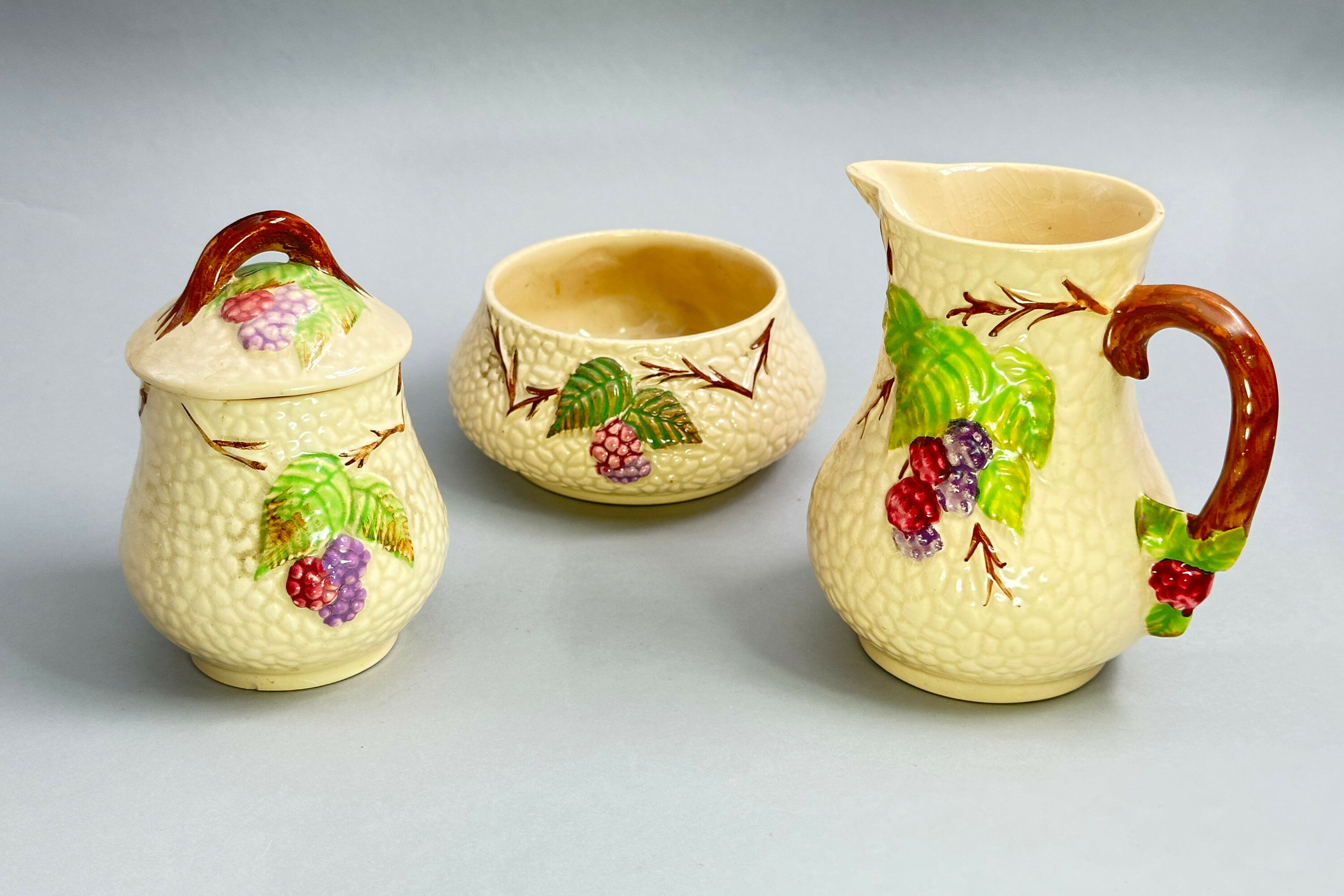
Set of three Wade Bramble Pattern teaware items, 1950s
Price: £25Wade Ceramics Ltd was a manufacturer of porcelain and earthenware, headquartered in Stoke-on-Trent, England. Founded in 1867, it was run by various members of the Wade family until the death of George Anthony Wade in 1987 after which there was a succession of management buyouts. Despite substantial investment in 2009, the firm eventually went into administration in 2022. Wade produced a wide variety of ceramics, including the well known Wade Whimsies animal figurines. A pair of Art Deco green glazed ‘salts’ are also included in this sale. The ‘Bramble’ design was created in the 1950s and a wide variety of tea service shapes were produced in the pattern. Collectors today can attempt to assemble examples from the whole of the range, towards which these three pieces might provide some assistance.

Bay Ceramic Ewer No 268-30, West Germany, 1960s
Price: £55Bay Ceramics was founded by Eduard Bay in the 1930s and based in Ransbach Baumbach, the heart of the main West German pottery producing region. Their productions included vases in a wide variety of shapes and designs which continued in production until the 1980s. Bodo Mans was amongst their most famous designers working in the 1950s and 1960s. He seems to have concentrated on organic semi abstract designs and ewers in this form, with the same pattern number but in a variety of different glazes, are attributed to him. This monochrome mustard glaze seems particularly attractive and complements the design very successfully producing a striking and decorative item which might enhance a wide variety of interior settings.
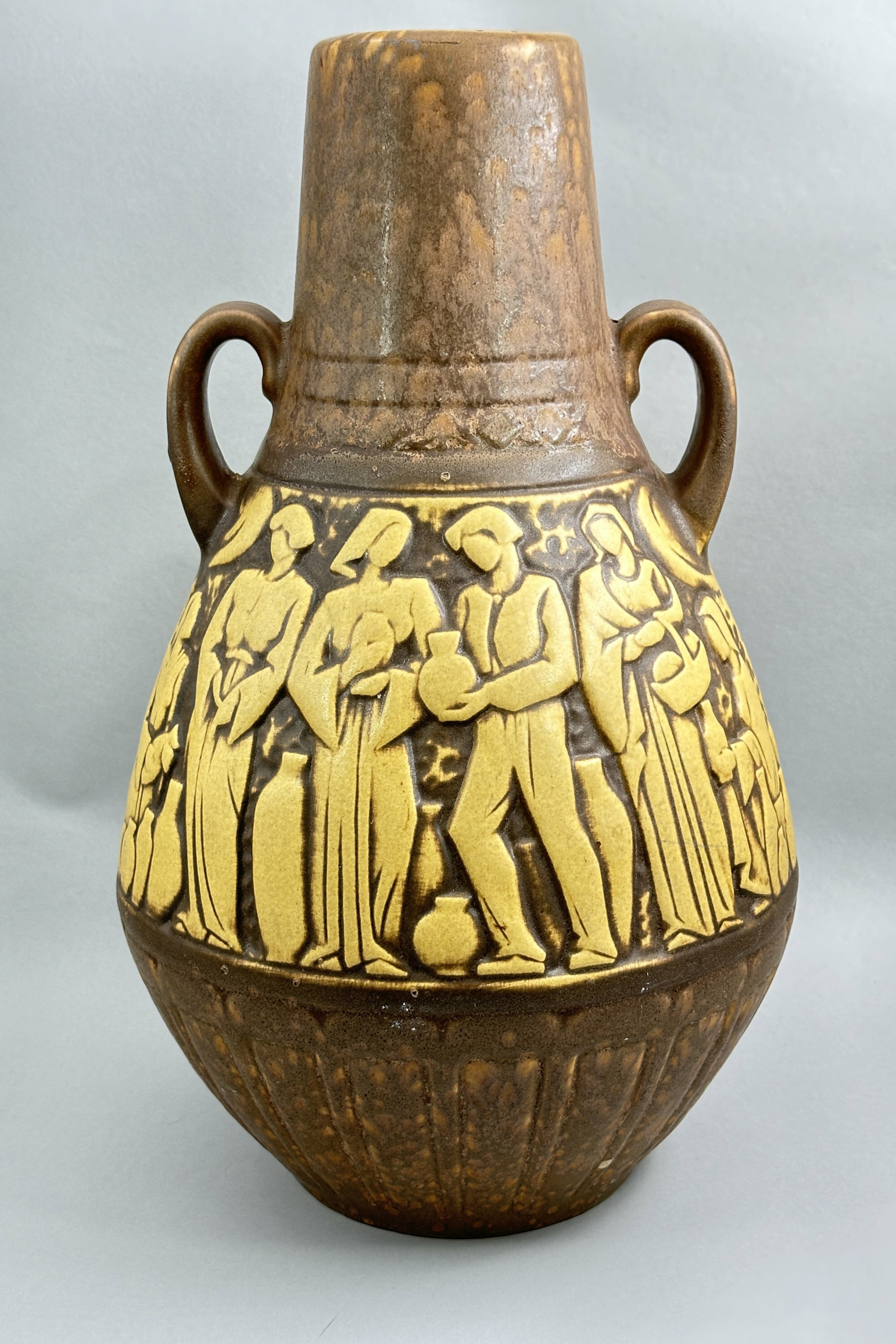
West German Scheurich Vase, Market Scene Pattern, 225-46, 1970s
Price: £150In 1954, Alois Scheurich founded the Scheurich Keramik factory, having been in partnership before then in the firm ‘Scheurich and Greulich’ (S&G) since 1927. While founded later than many of its competitors, Scheurich grew to become the principal exporter of West German ceramics through until the 1980s and beyond, making vases in a wide variety of shapes and designs. Made in the 1970s, this vase has a retrospective feel recalling Soviet designs from the 1920s and 1930s. The figures seem to be grouped in a stylised market scene with various pitchers containing perhaps wine or oil. The symbolism is unclear unless it refers to the vase itself which could be regarded as recalling the form of the Greek amphora. But whatever the ‘meaning’ we have an imposing and unusual decorative item here which stands rather apart from many of the other pieces produced by its manufacturer.

Two Wood Boxes : Marriage of Charles and Diana, Birth of Prince William, late C20th
Price: £15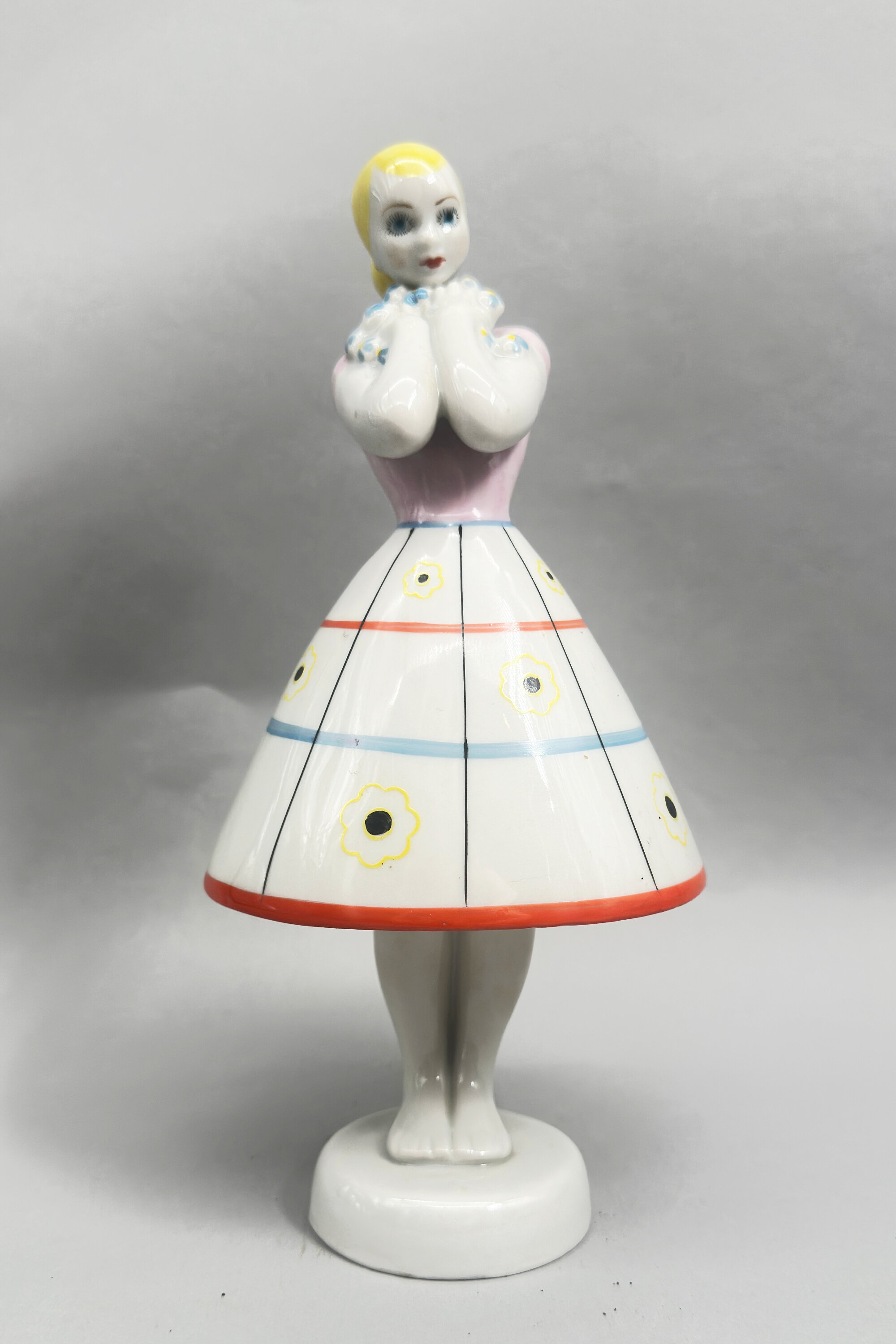
Figurine of a girl, Baranivka Ukraine, 1950s
Price: £55The Baranivka Porcelain Factory, one of Ukraine's oldest porcelain manufacturers, was founded in 1802-1804 by Mykhailo Mezer. Situated at Baranivka, at the time in Poland but now part of Ukraine, the factory was considerably assisted in its development by the discovery of rich clay deposits in the area. Production was continuous even during the Soviet era until the early twenty first century. Both the angular modelling and the abstract decoration of this piece point to a dating in the 1950s when production would have revived after the second world war and more contemporary styles adopted.
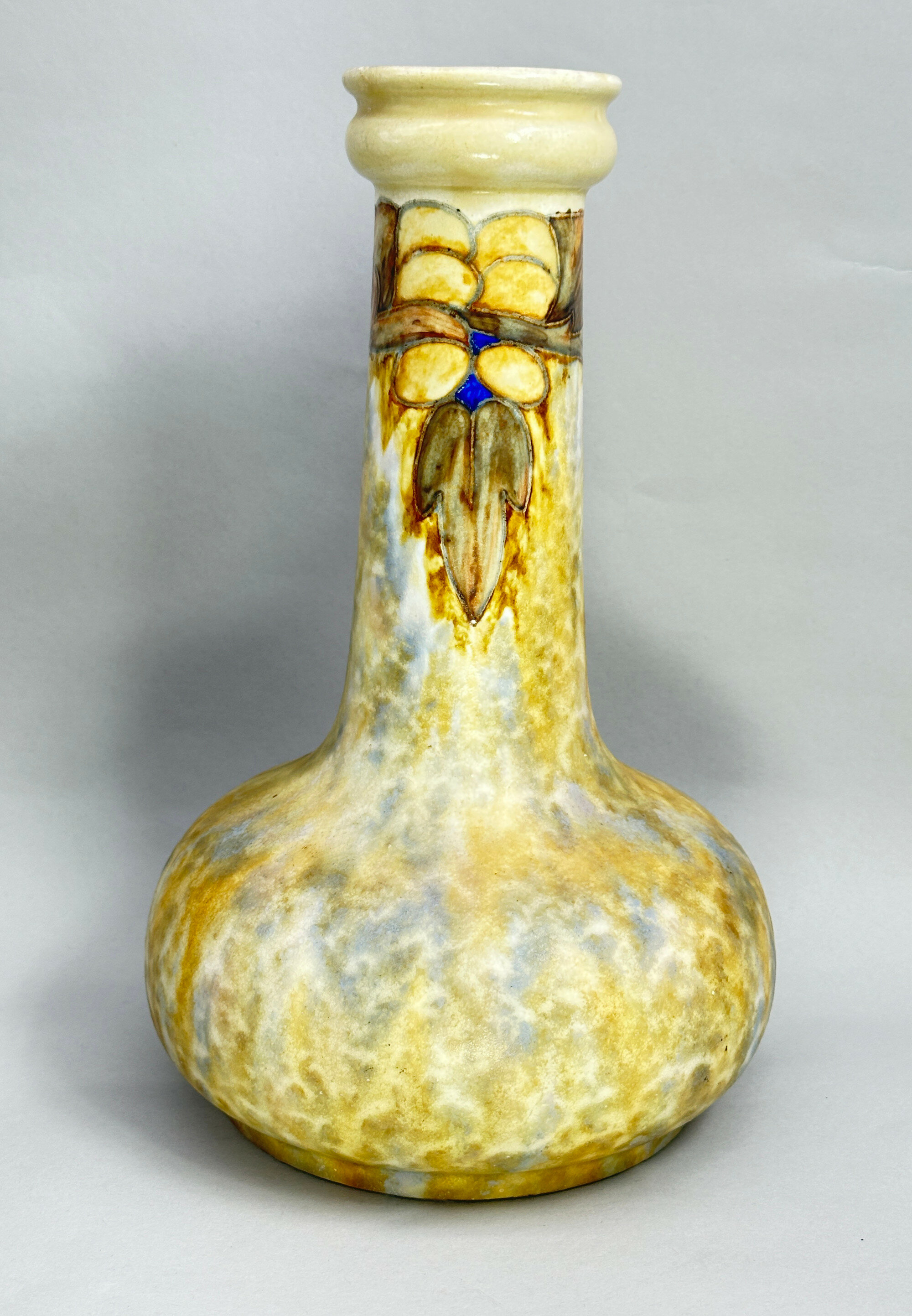
Cranston Ware Art Nouveau Style Vase, early C20th
Price: £95Cranston Ware was one of the ranges produced by the Pearl Pottery Company, based in Hanley, Stoke on Trent. Founded in 1892, the firm produced a varied selection of ceramic wares, often following contemporary fashions, until its closure in 1947. This vase is demonstrably in the Art Nouveau style and would have been produced when it was at its zenith in the early 1900s. The pattern was known as ‘Tukan’ ware and some of the pieces, but not all, have an impressed mark displaying this. This is an excellent example of the type with the glazes and decorative detail well rendered and certainly deserves the attention of collectors of Art Nouveau.
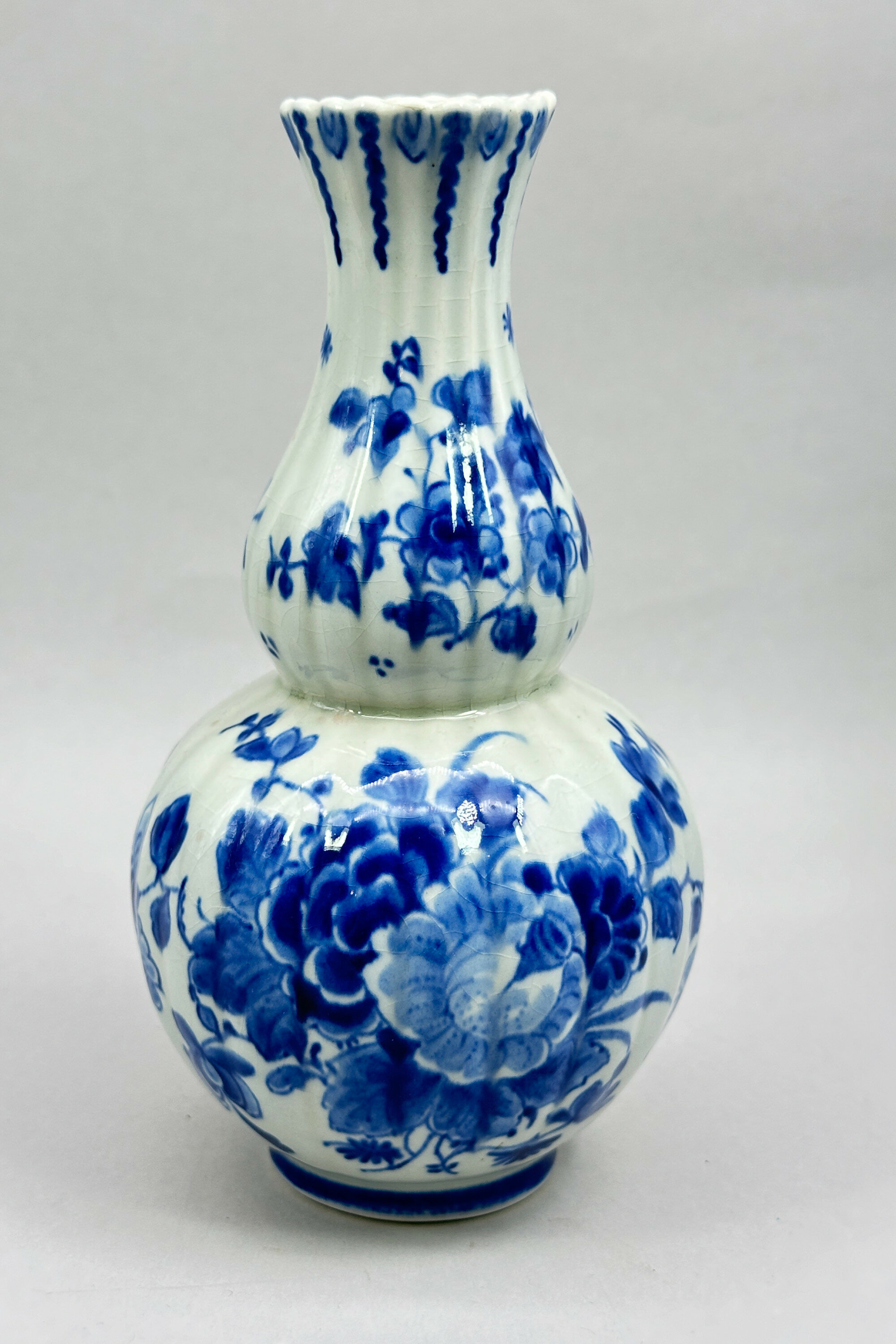
Dutch Delft Blue and White Gourd Vase in C18th Style, late C20th
Price: £25This vase is typical of one of these later creations and copies an eighteenth century original which itself was based on Chinese pieces. The marks underneath, although some of them are blurred, offer a clue to the dating. Below an ‘A’ at the top can be seen a vase which stands for ‘De Porcelyne Fles (The Porcelain Bottle) a factory which was established in 1653 and continues production today. There follow the initials ‘JT’ as a monogram standing for Joost Thooft who bought the factory in 1876 and below this ‘Delft’. At the bottom are usually found the painter’s initials to the left and letters to the right which are the date mark. On this vase these are unclear but the painter’s initials read ‘MA’ which appears to stand for M.H.van Aalst who worked for the firm from 1941to 1983. This would fit with a likely dating here to the second half of the twentieth century, but the artist has successfully recreated the work of his predecessors and produced a piece of great charm.
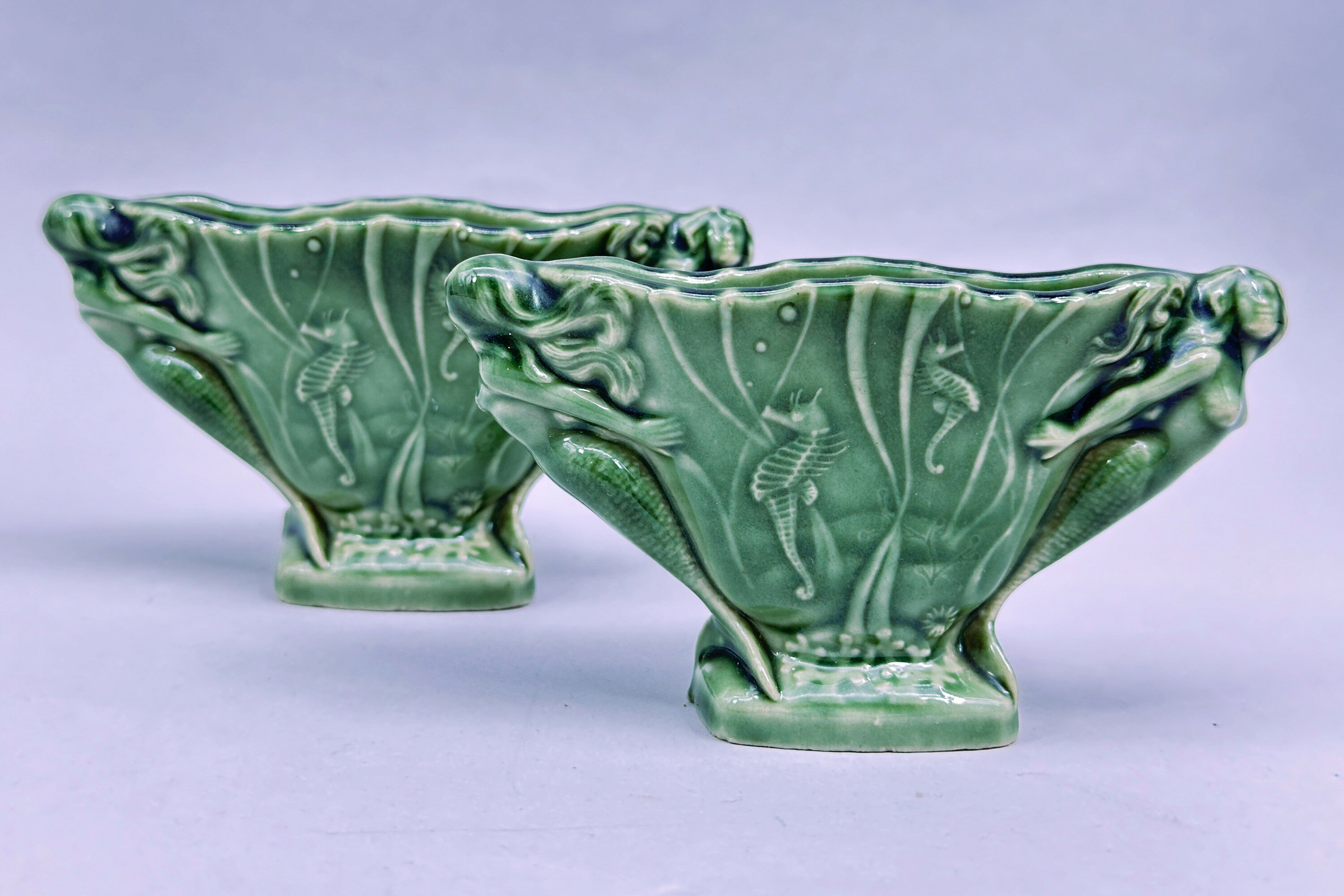
Pair of Wade green glazed Mermaid salts, 1950s
Price: £55Wade Ceramics Ltd was a manufacturer of porcelain and earthenware, headquartered in Stoke-on-Trent, England. Founded in 1867, it was run by various members of the Wade family until the death of George Anthony Wade in 1987 after which there was a succession of management buyouts. Despite substantial investment in 2009, the firm eventually went into administration in 2022. Wade produced a wide variety of ceramics, including the well known Wade Whimsies animal figurines.
This pair of salts is rather different to many of their productions and have a distinctly ‘Art Nouveau’ feel but, in fact, date to the 1950s when this particular format of the factory mark was used. It seems to be one of the rarer forms and pairs are even rarer still, so definitely one for Wade collectors!
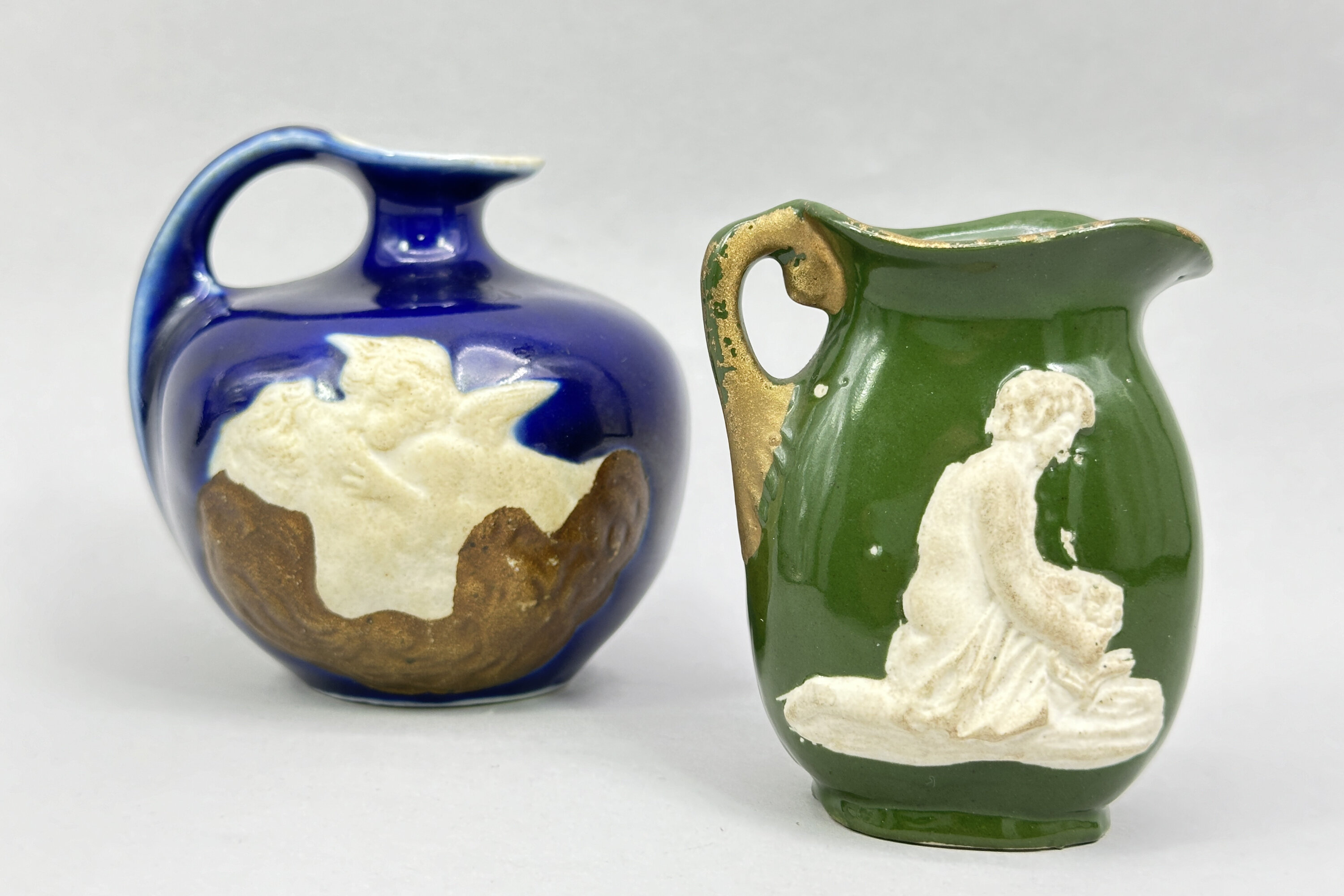
Two Ceramic Jugs with Erotic Decoration, continental perhaps German, circa 1900
Price: £25These pieces represent something of a puzzle. Seen the right way round (with the handle on the right) they are plain and the decoration only reveals itself on the reverse. This suggests a playful intent to conceal which, when combined with the subject matter, suggests something a bit ‘naughty’ which could confirm the second interpretation of what the seated man is holding! The paste, and general style of the pieces, looks continental and a German origin might be a good guess, but no more than that. The blue glazed jug has an impressed mark to the base ‘186 [plus an unidentifiable number]’ which might be the date but is more likely the pattern number; a dating of around 1900 for both seems reasonable - certainly there is an ‘old’ look to the pieces. There are one or two similar examples but little in the way of firm information. One for a collector to puzzle out!
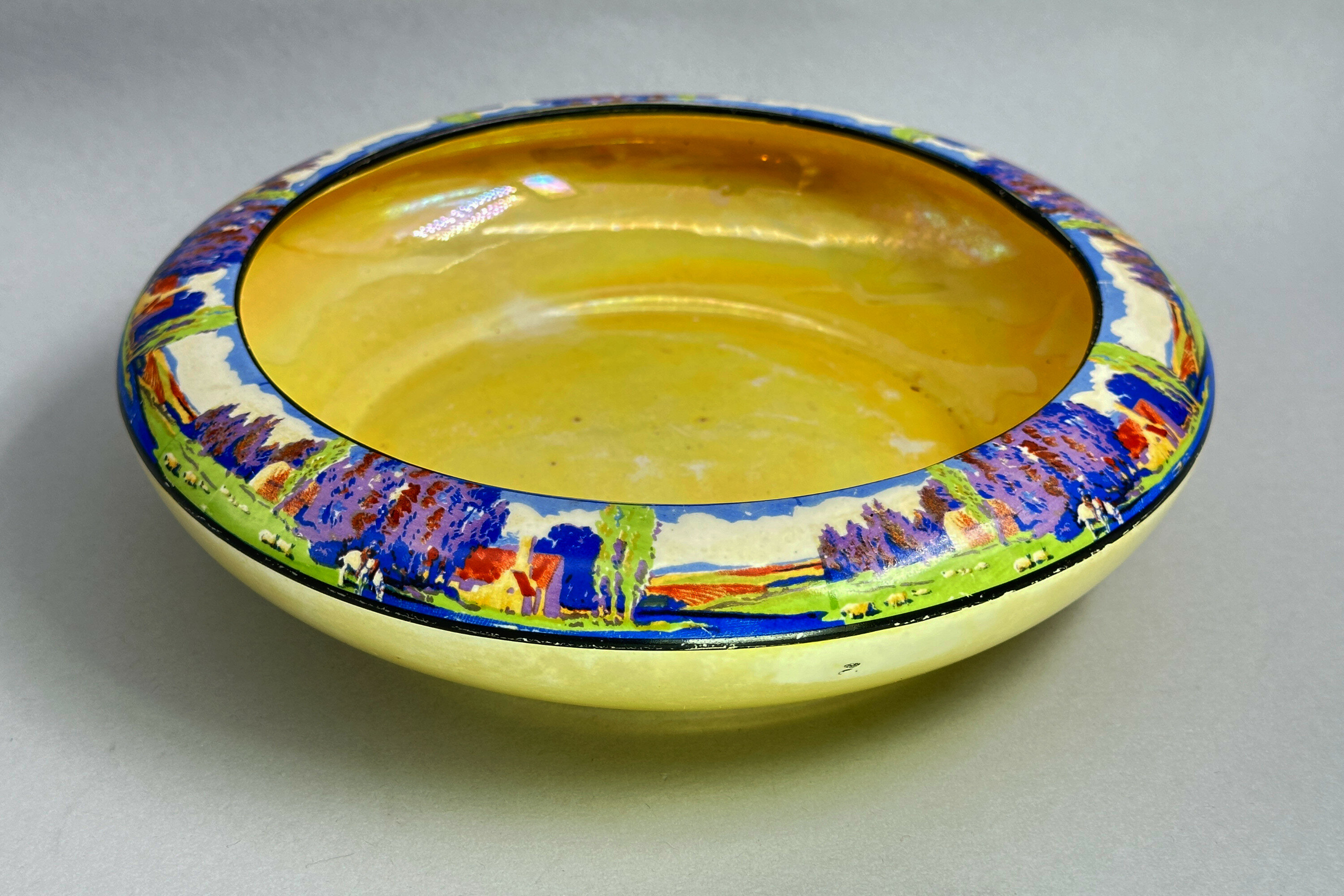
Hanley Ware circular bowl, Lancaster and Sons, 1920s
Price: £25Lancaster & Sons Ltd were manufacturers of earthenware at the Dresden works, Tinkersclough, in the Shelton area of Hanley, Stoke-on-Trent, England. The firm was founded in 1899 under the name ‘Lancaster and Barker’ was renamed ‘Lancaster & Sons Ltd’ in the early 1900s and continued production until 1944. In the 1920s they produced various pieces with rural landscape scenes of which this is an example. Some see reminiscences of the ‘Arts and Crafts’ movement here but the mark found on the bottom clearly dates the piece to the 1920s. The yellow lustre glaze is interesting and free from the crazing sometimes found.
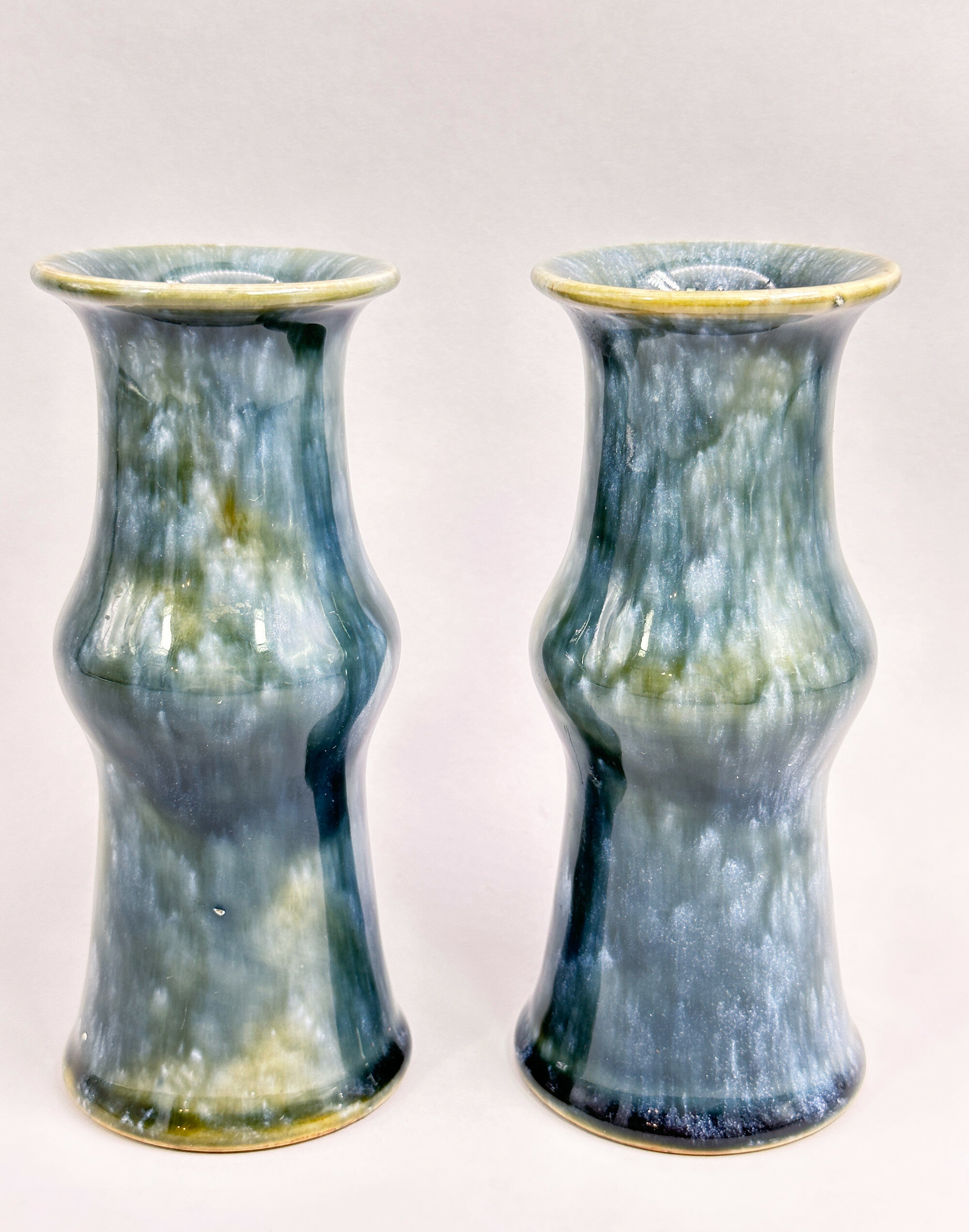
Pair of Royal Doulton slender Ku form Vases, 1920s
Price: £75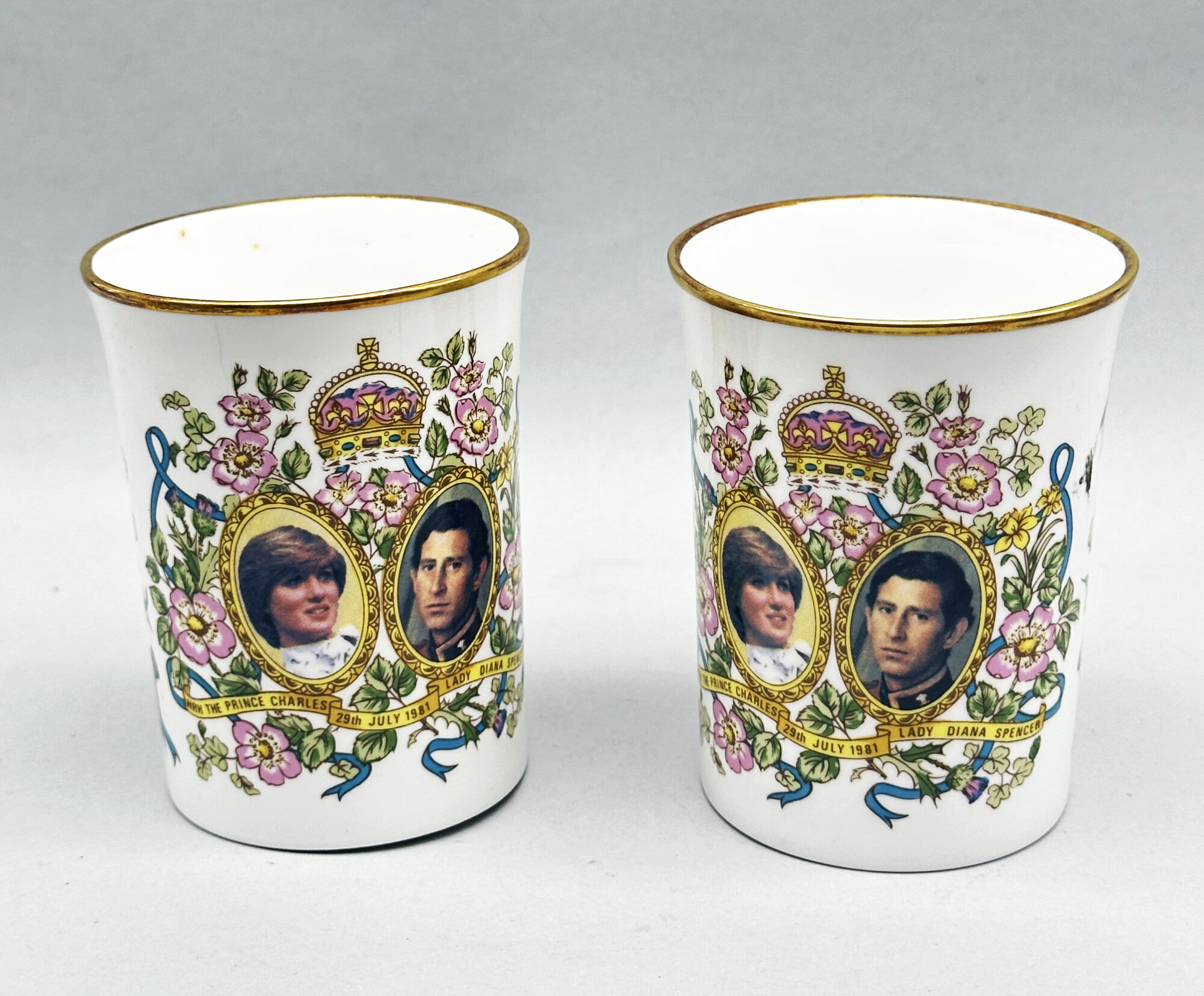
Two Beakers : Wedding of the Prince Charles and Lady Diana Spencer, 1981
Price: £15
Gilt decorated English porcelain powder box and cover, probably mid C20th
Price: £15
Commemorative Ware Silver Jubilee Plate, James Kent Ltd, England, 1935
Price: £35
Set of Japanese Plates decorated with Geisha in landscape scenes, late C20th
Price: £40Please note that the stands are for display purposes only.
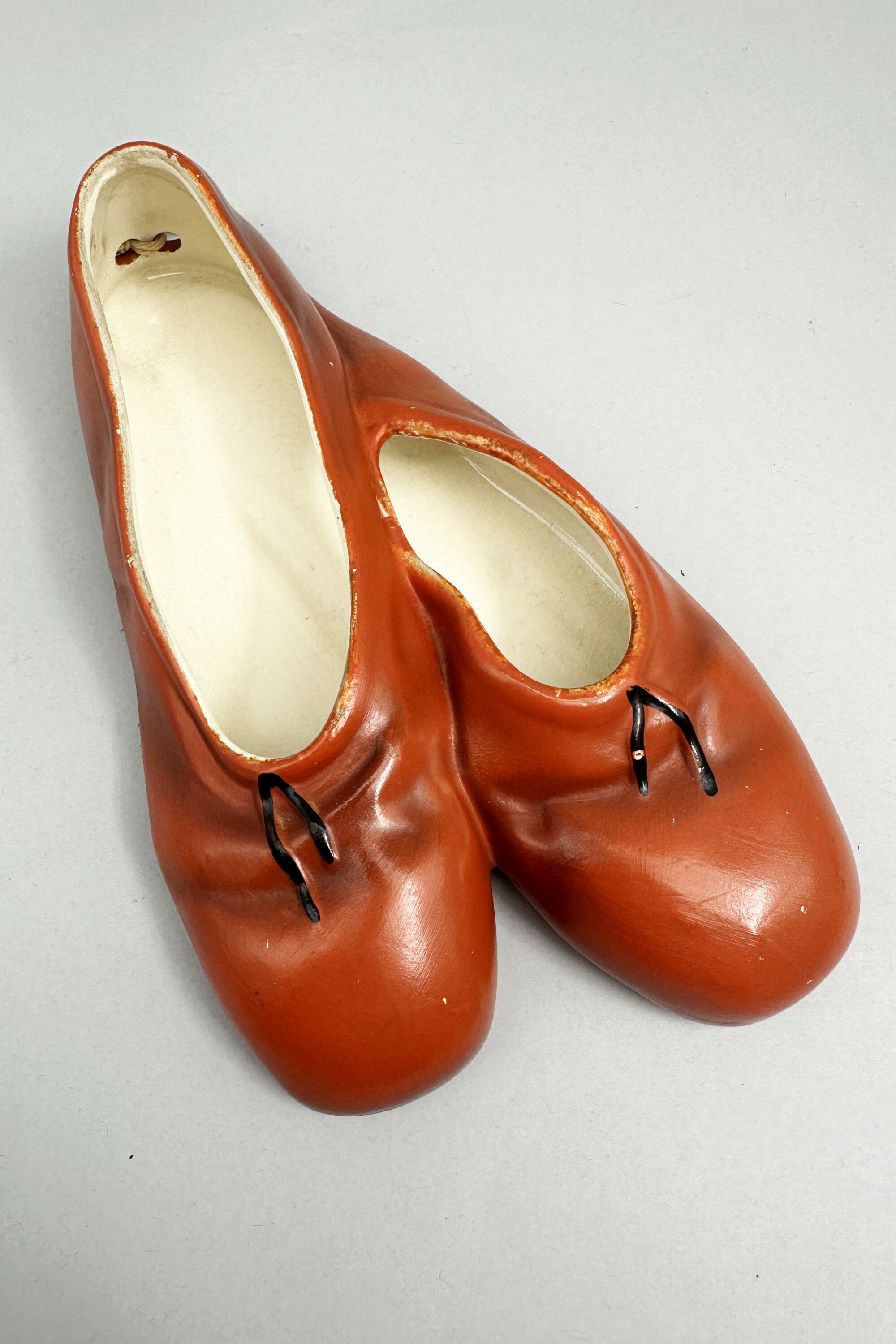
Pair of Brentleigh Ware Wall Hanging Ballet Shoes, 1930s
Price: £35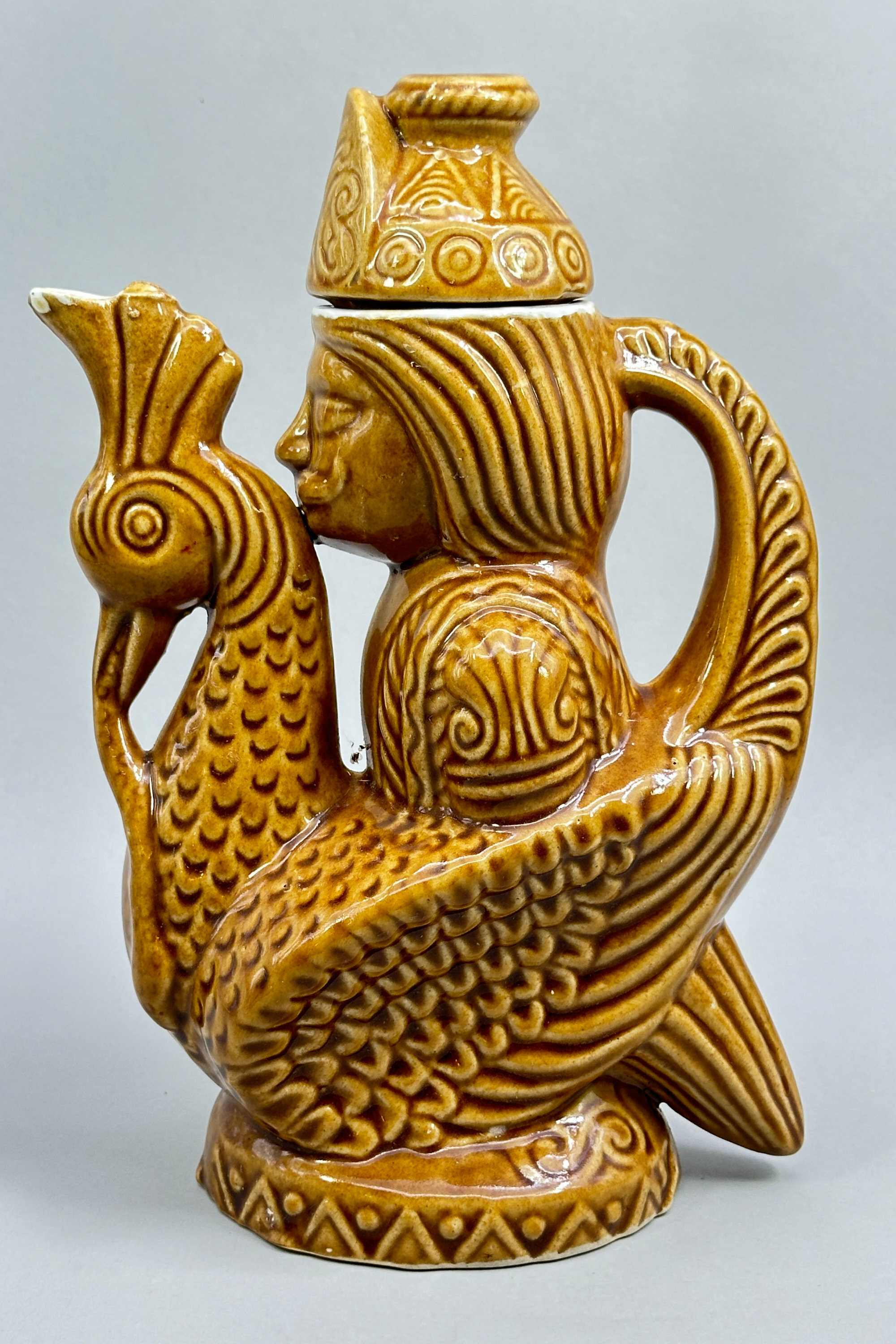
Bird form ewer with cover, possibly Russian c1960
Price: £45
Pair of Capodimonte ceramic Wall Hanging Plaques, boy and girl praying, Italian 1960s
Price: £25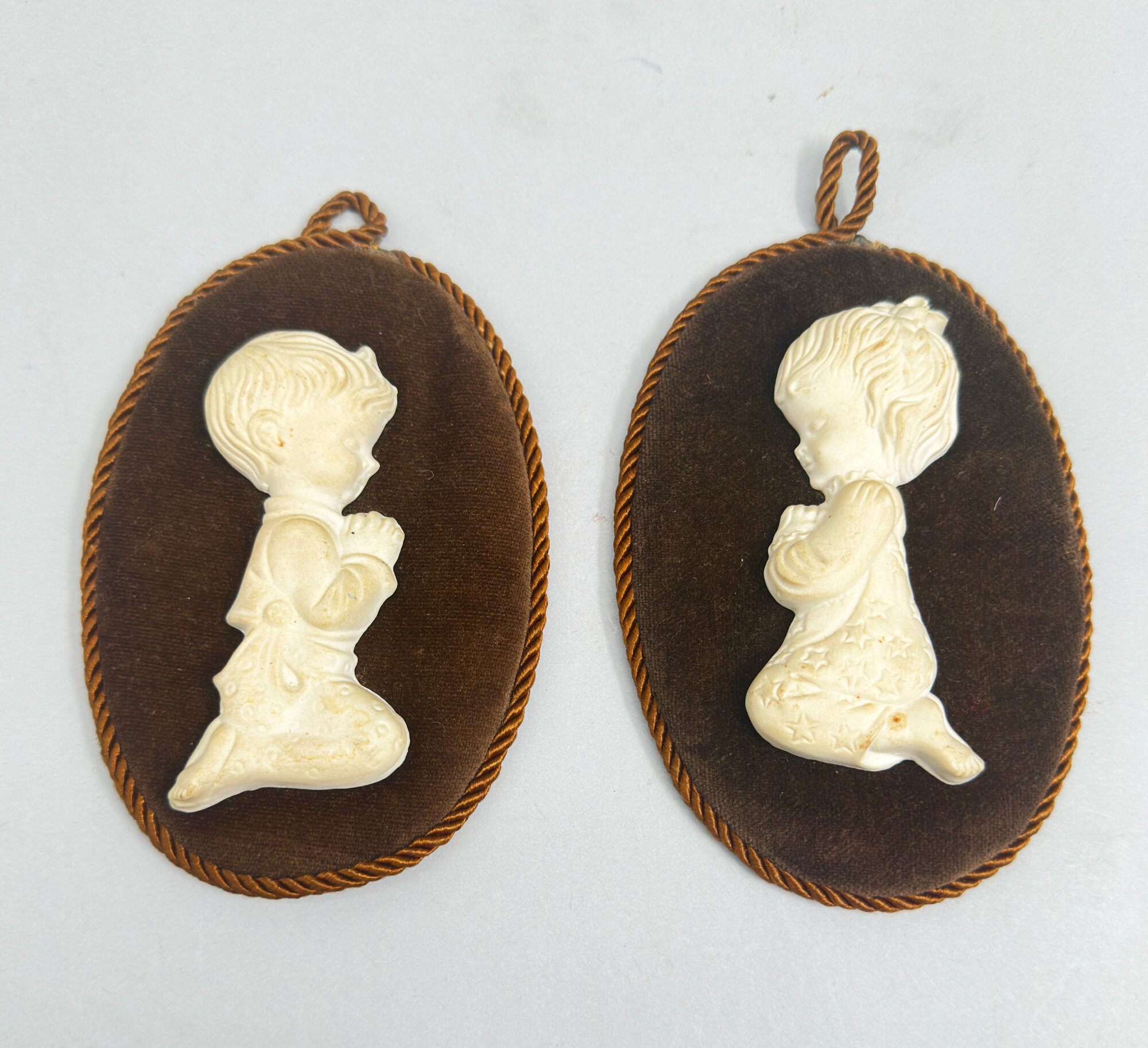
Pair of Capodimonte ceramic Wall Hanging Plaques, boy and girl praying, Italian 1960s
Price: £25
VE Day, 50th Anniversary Commemorative Mug, 1995
Price: £10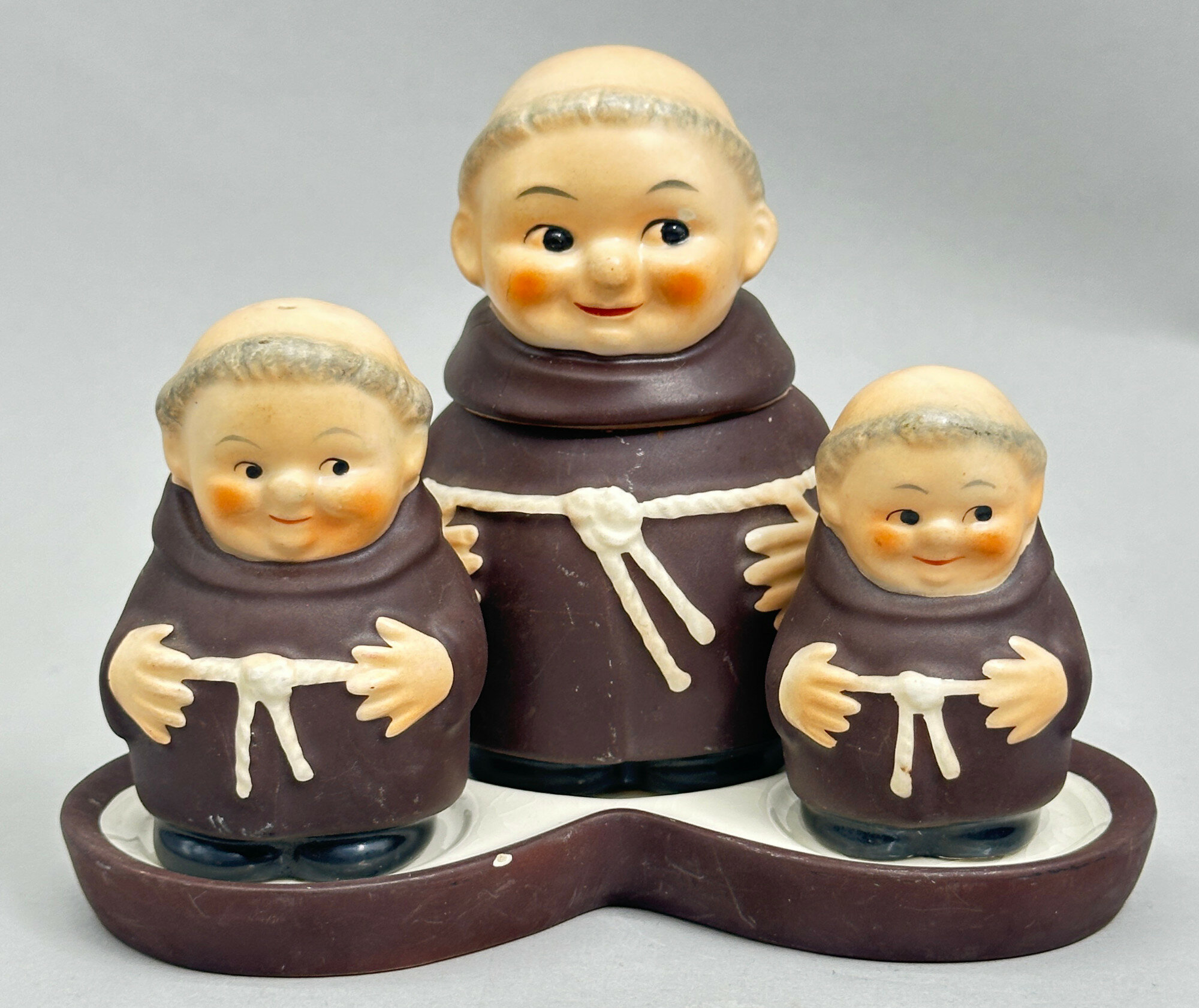
Cruet set in the form of three Friar Tuck Monks on a Tray, Hummel, West Germany, 1960s
Price: £55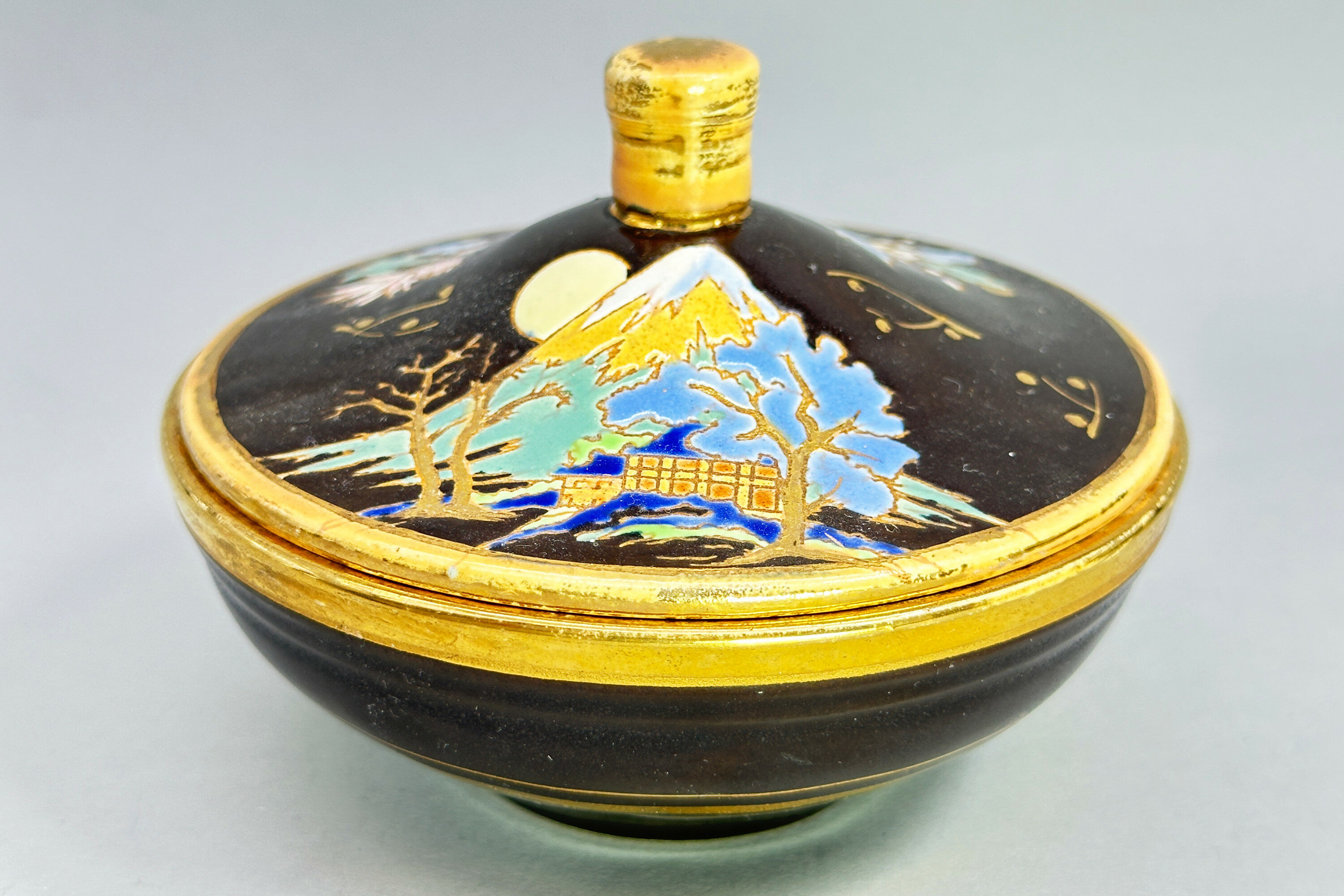
Cosmetic Box with Japonaiserie Decoration, Boch Freres, early C20th
Price: £45The firm Boch Freres Keramis was founded by Eugene and Victor Boch and their brother-in-law, Jean Baptiste Nothomb, in 1841 and was located in La Louviere in eastern Belgium. In 1906 Charles Catteau joined the company as artistic director and was responsible for a new and wide ranging series of designs, some under the influence of Japonisme, transitioning the company from producing utilitarian objects to highly decorative ceramics. His work can clearly be seen here in a piece which appears to be quite unusual. Both the form and the decoration reflect early twentieth century fashion in the clean lines and the images inspired by Japan. There is a hint of the aesthetic movement here producing an object of great attraction and interest.
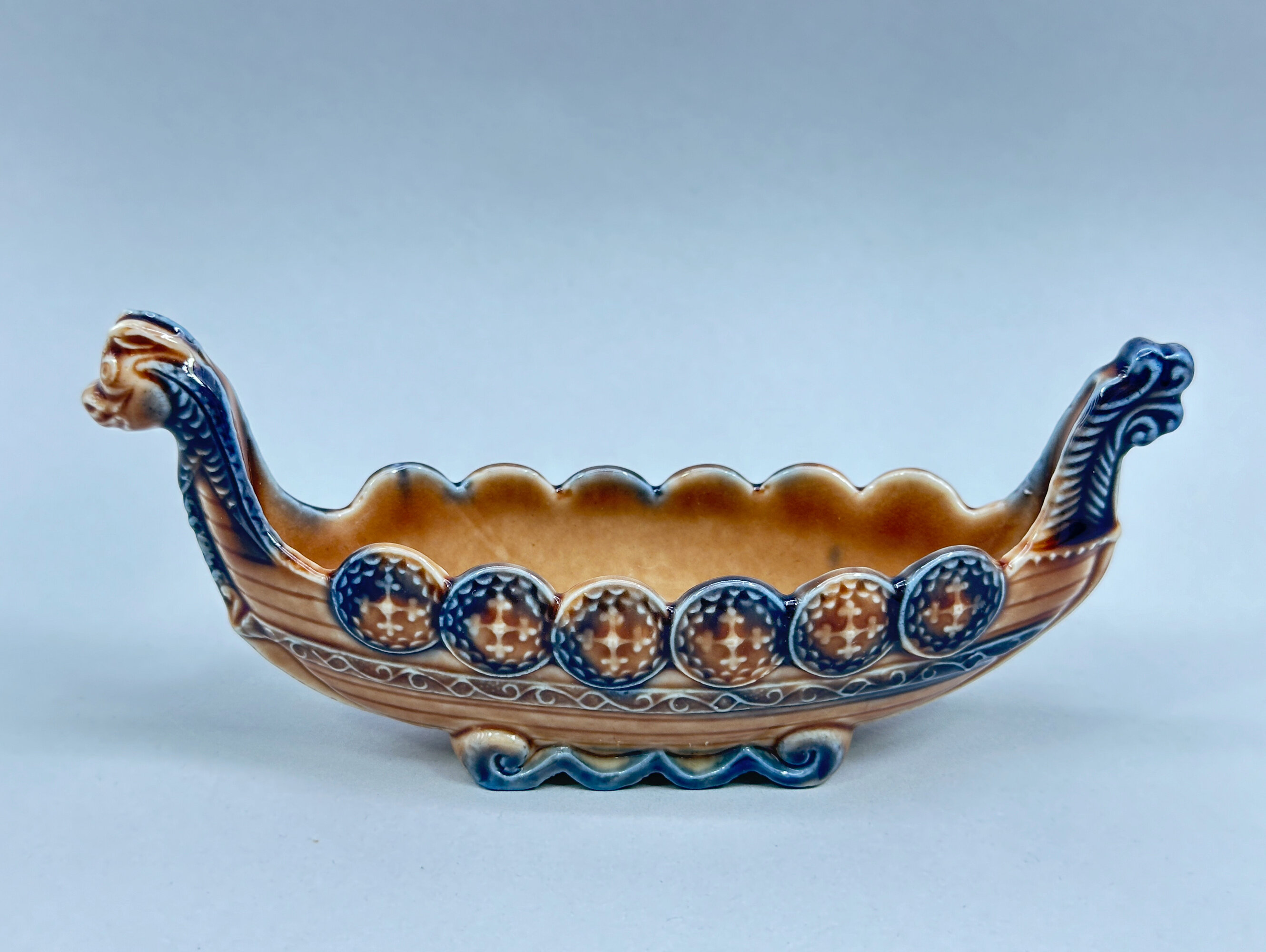
Ceramic Model of a Viking Longboat, Wade, 1950s/1960s
Price: £25Wade Ceramics Ltd was a manufacturer of porcelain and earthenware, headquartered in Stoke-on-Trent, England. Founded in 1867, it was run by various members of the Wade family until the death of George Anthony Wade in 1987 after which there was a succession of management buyouts. Despite substantial investment in 2009, the firm eventually went into administration in 2022. Wade produced a wide variety of ceramics, including the well known Wade Whimsies animal figurines.
Many of their pieces were designed to act as small containers for flowers and trinkets and this piece is a particularly amusing example of the type. Two colour ranges exist, one as here and one with much darker tones which is held to be later. Dating here, then, is most likely to the 1950s/1960s when the Wade production lines were in full swing and enjoying considerable popularity.

Miniature Staffordshire flatback model of two spaniels and a barrel, second half C19th
Price: £55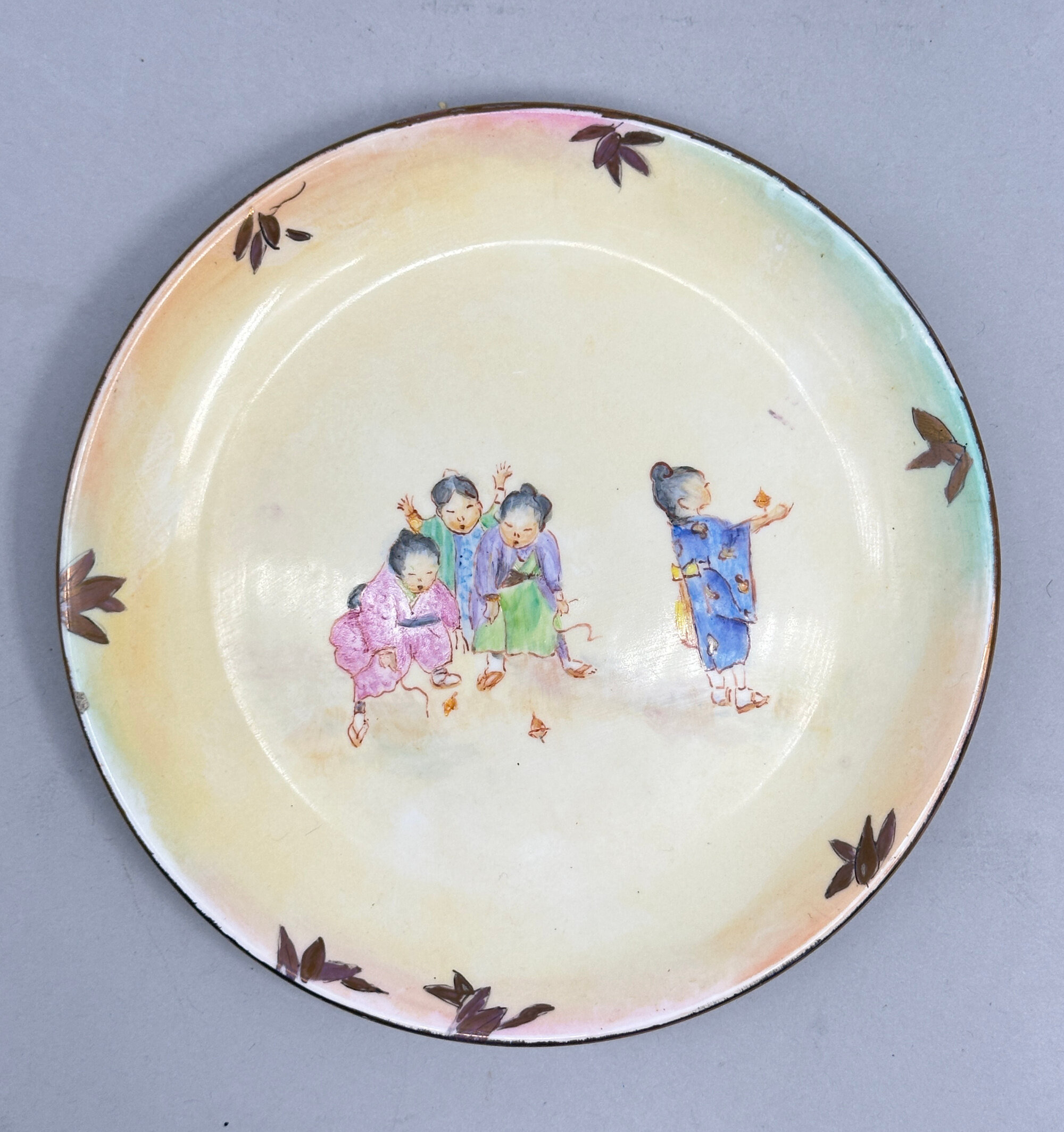
Oriental style ceramic plate, signed Alice Smith, possibly American mid C20th
Price: £10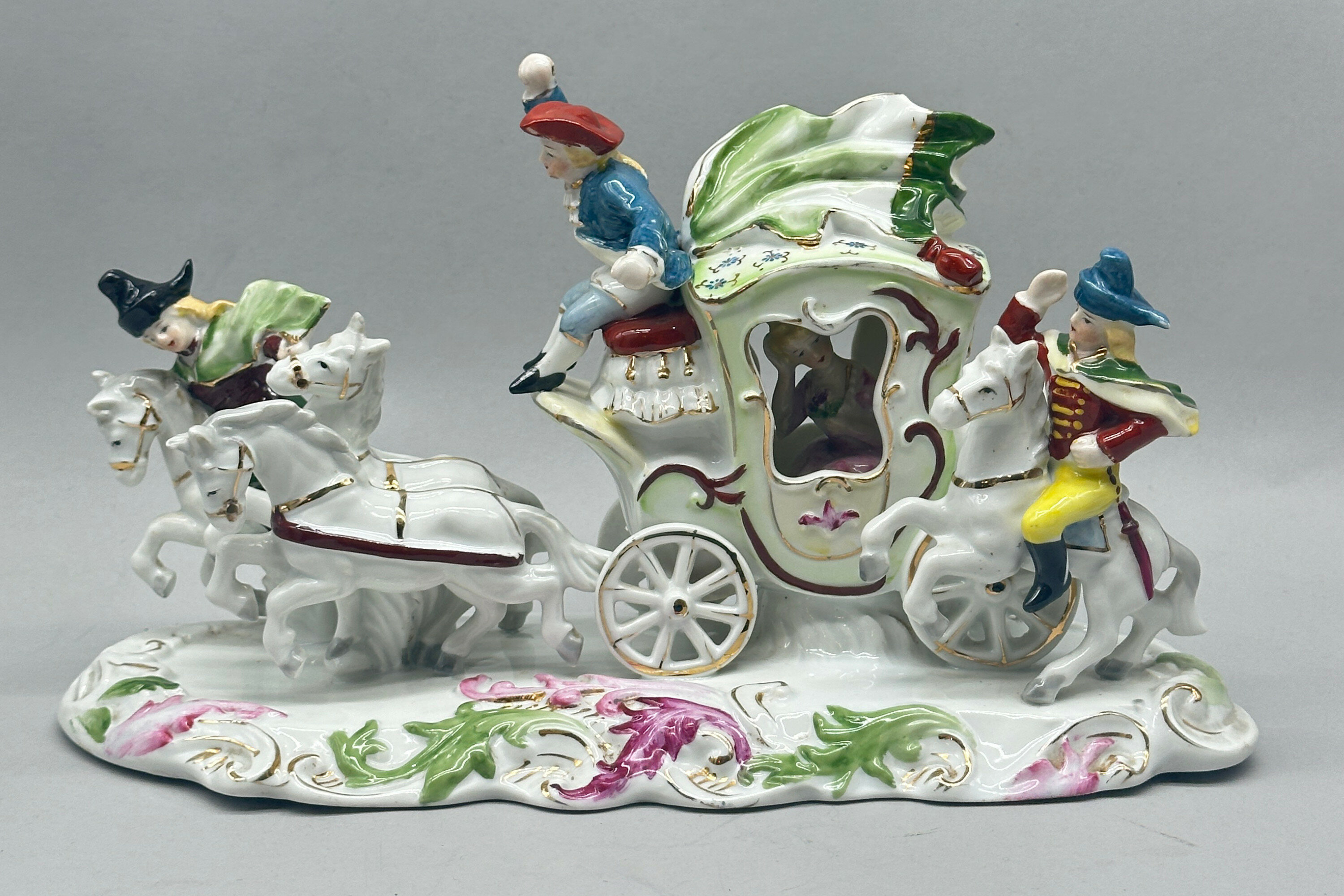
Dresden style model of a Coach and Horses, probably German early C20th
Price: £75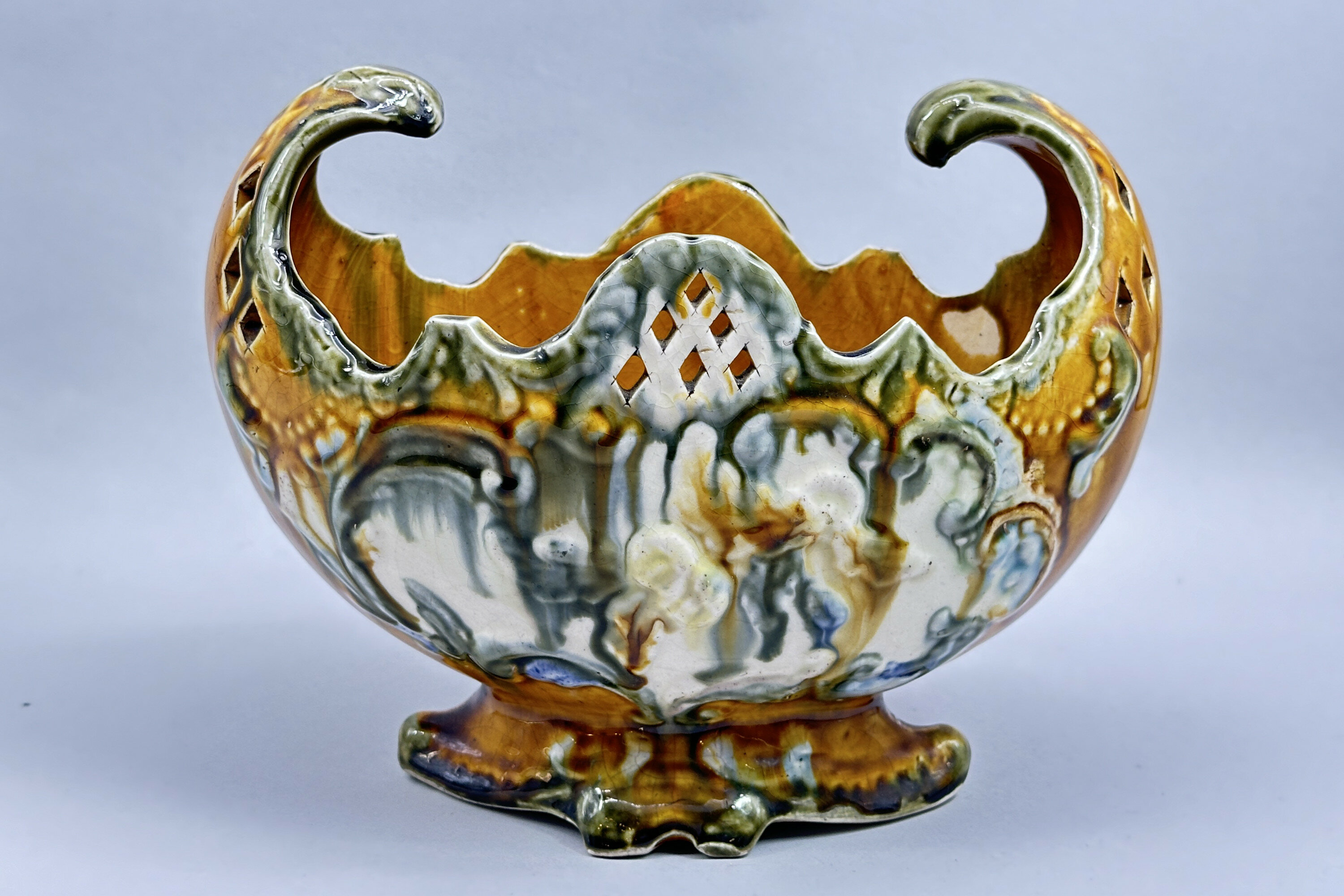
Majolica Style Jardiniere, French, circa 1900
Price: £55This is a French interpretation of the ‘Majolica’ style which became so popular, particularly in England in the second half of the nineteenth century. A very distant relation of the tin glazed Italian and Spanish wares which share the name, nineteenth century majolica employed a wide variety of brightly coloured glazes applied to elaborate forms some of which had a slightly ‘classical’ feel and some a reflection of ‘rococo’ designs. The paste and glazes here suggest France, which produced various pieces in the ‘majolica’ style and dating is probably to the end of the nineteenth century.

Novelty Teapot in the form of an apple, probably English, late C20th, early C21st
Price: £35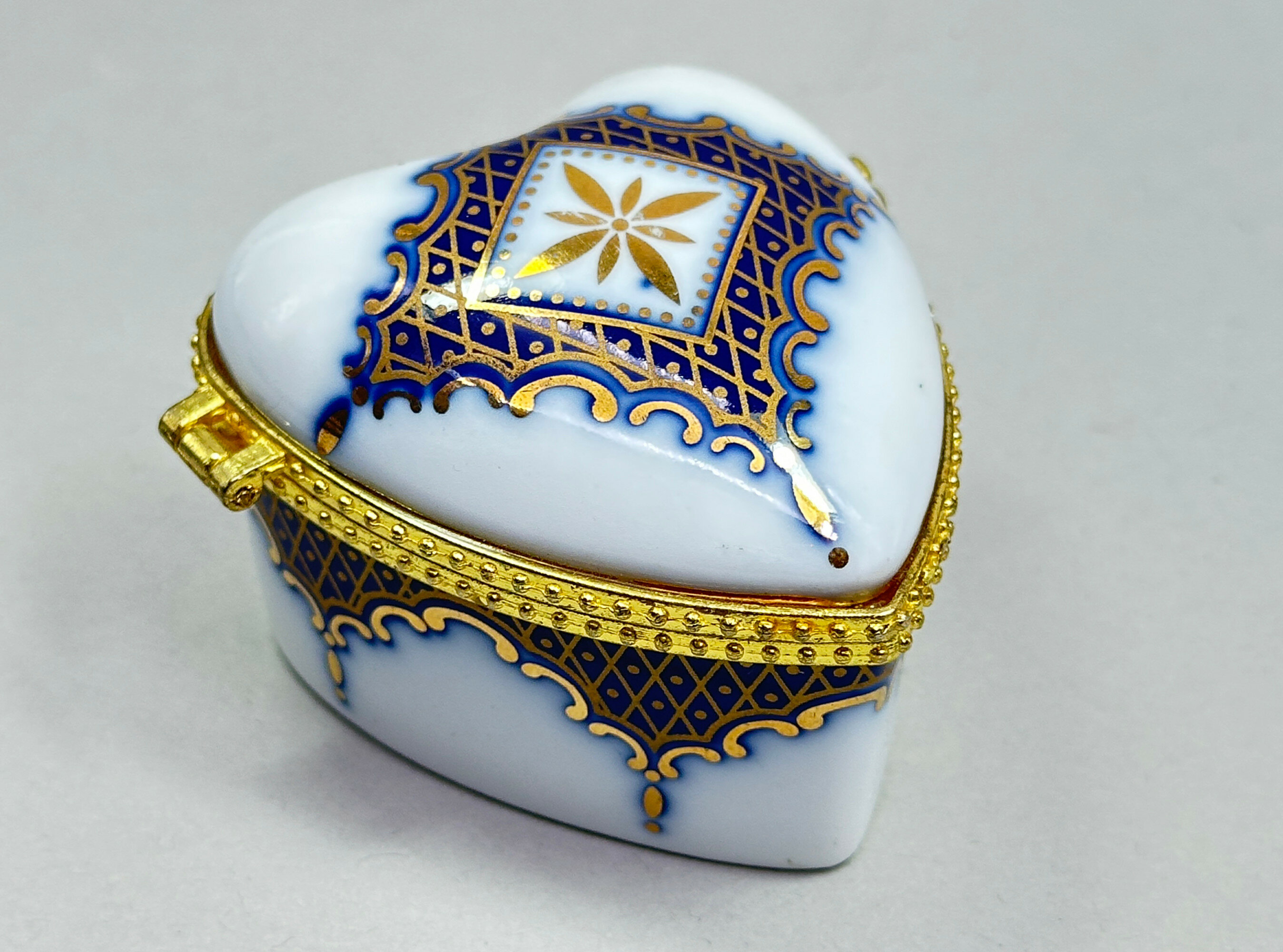
Oriental porcelain European Style Heart Shape Box and Cover, OC & CO, late C20th
Price: £15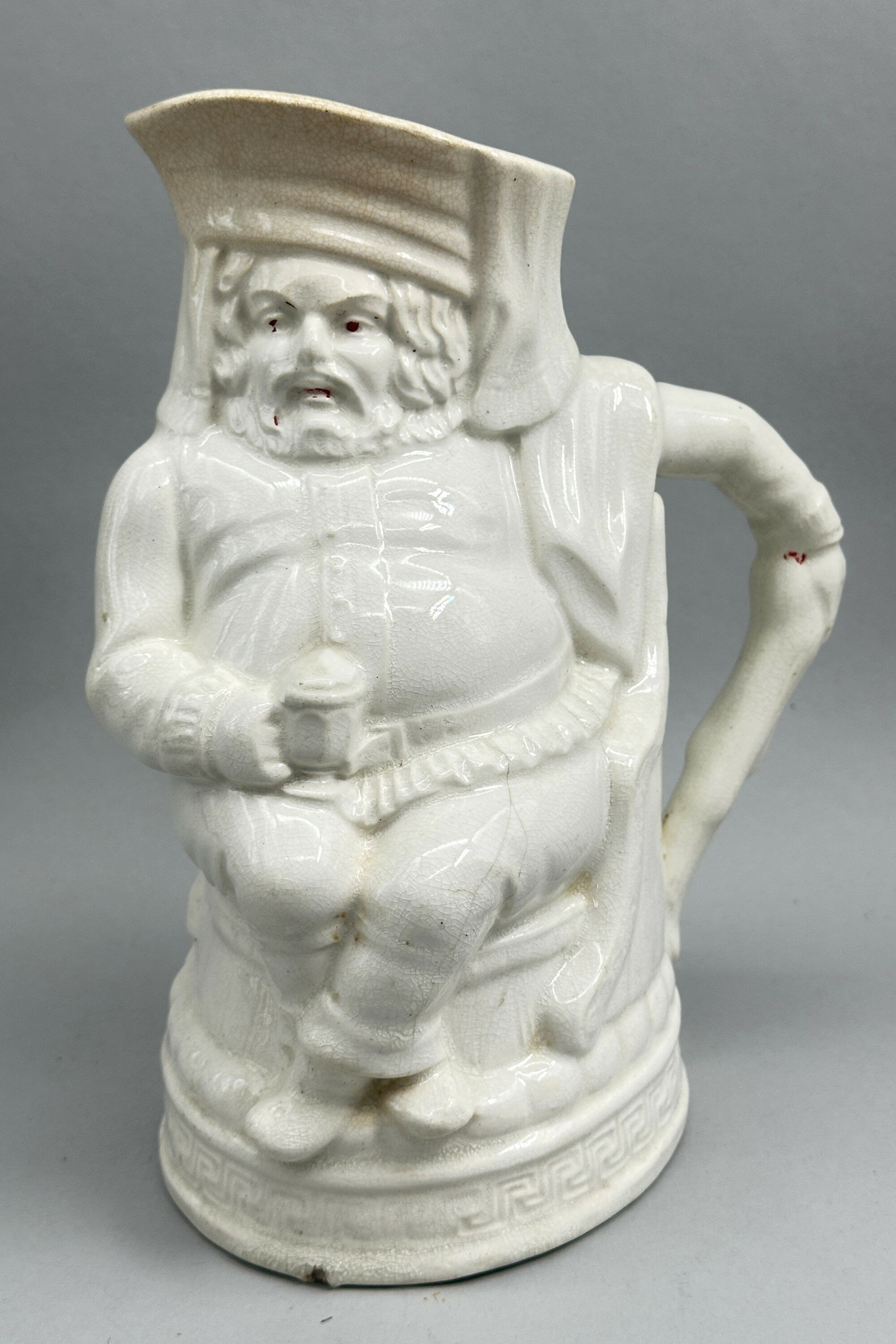
Earthenware Jug, Falstaff or Old King Cole, Furnival and Clark, mid C19th
Price: £75The design for this jug, usually termed ‘Falstaff’ but sometimes ‘Old King Cole’ is known to have been registered (Rd.No. 32601)by the firm Furnival and Clark on December 30th 1845. This was a very short lived partnership between Thomas Furnival and Richard Clark, based at the Stafford Street Pottery Works, Hanley, Staffordshire and which traded from 1844 to 1846 apparently producing just this one model, albeit in a variety of colours. Thomas Furnival had been involved in other firms before this brief venture and was to be involved in others afterwards. The dating of these mugs is usually attributed to the short period when Furnival and Clark traded but it is quite possible that more pieces were produced afterwards by Furnival himself. The paste and finish of this piece, though, which is not marked, certainly suggest a mid nineteenth century dating. In general, the model is quite rare. Some examples were fitted with a Britannia metal or pewter lid but this was never integral to the piece. This striking composition, then, is a rare and desirable item collectors with an interest in British Staffordshire wares.

Large Shelley Harmony Ware Vase glazed in blue and grey, 1930s
Price: £75Shelley Potteries, situated in Staffordshire, was originally known as Wileman & Co. which had also traded under the name ‘The Foley Potteries’. The first Shelley to join the company was Joseph Ball Shelley in 1862, and it remained a Shelley family business until 1966, when it was taken over by Allied English Potteries. Joseph’s son Percy employed first the designer Frederick Rhead then Walter Slater who had worked with Doulton. It was Walter Slater’s son, Eric, who initiated the ‘Harmony’ range in 1932, at first with a series of banded designs as here and then with drip ware patterns which became enormously popular. Harmony ware was produced in a wide variety of colours and shapes, the plain ovoid form being typical and reflecting the Art Deco styles of the period, but this example is exceptionally large with a more unusual range of colourings.

Figure of a Seated Ballerina, Royal Dux, late C20th
Price: £75Duxer Porzellanmanufaktur, or the Dux Porcelain Manufactory, was started in 1860 by Eduard Eichler in what was then Duchov, Bohemia, later to become part of Czechoslovakia. Production was to continue until the beginning of the second world war and beyond and their later pieces are now generally referred to by the abbreviated name, ‘Royal Dux’. The distinctive pink triangle plaque mark was first used in the late nineteenth century but appears on pieces from all dates, the version found here indicating late twentieth century work which is also confirmed by the rather indistinct stamped mark comprising a triangle surrounded by the wording ‘Hand Painted Made in Czech Republic’. The artist is named as ‘V.David’ and there seem to be two other companion pieces in different poses. The quality is quite excellent and explains the original popularity of the firm when it began manufacturing in the nineteenth century and produced highly successful imitations of its contemporary rivals.
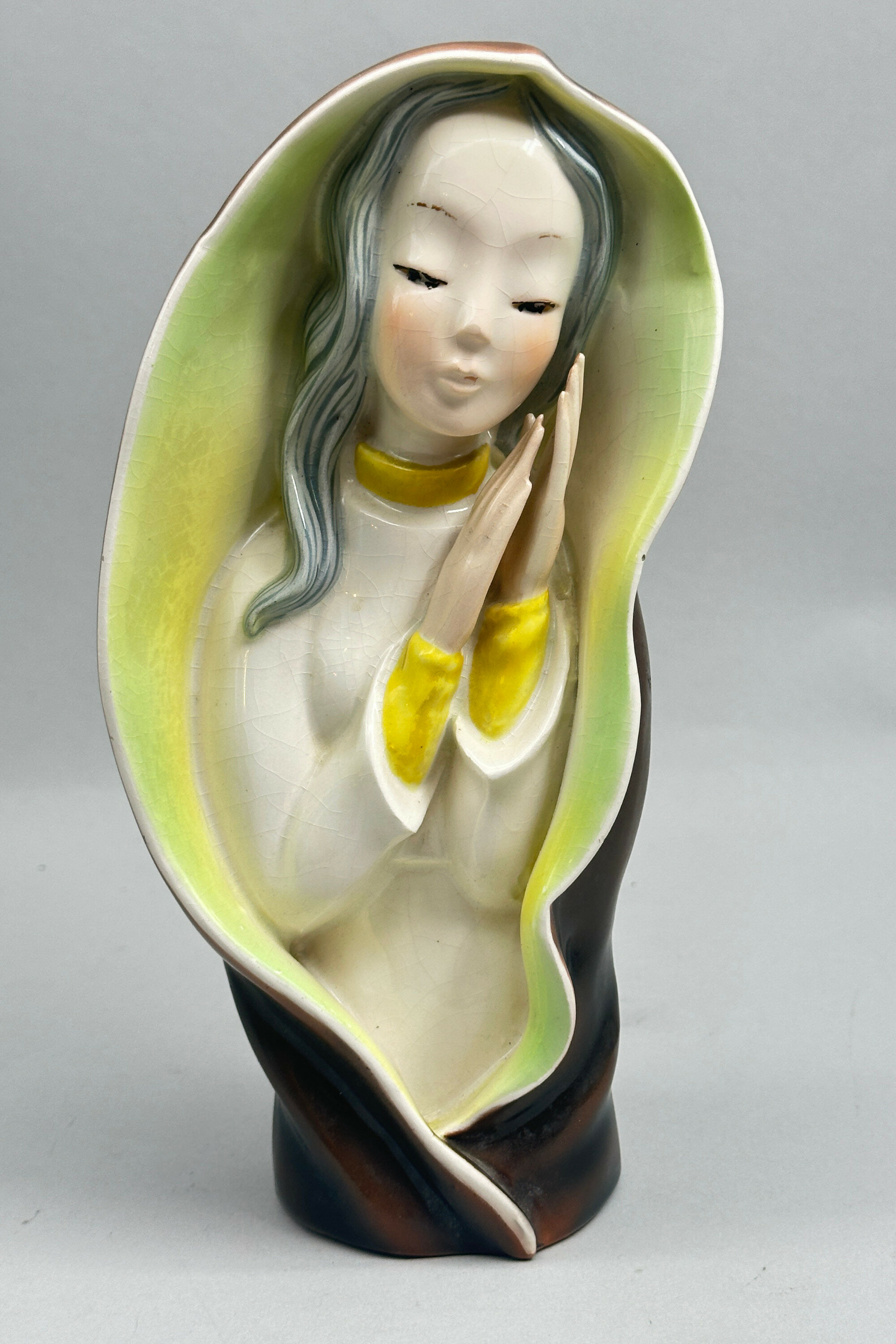
Figure of a Young Girl Praying, Continental, probably mid C20th
Price: £55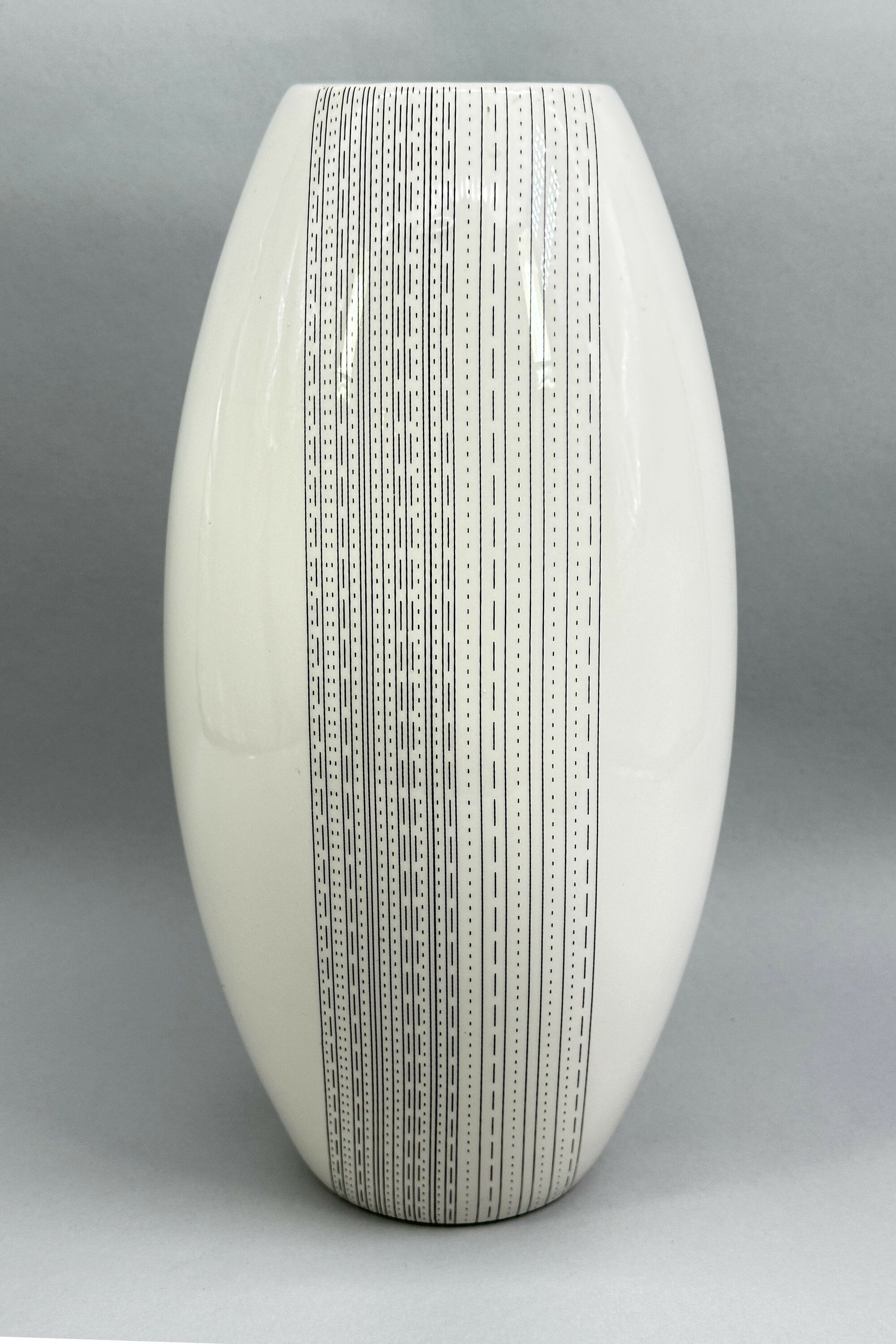
Abstract Design White Glaze Vase, probably British mid C20th
Price: £25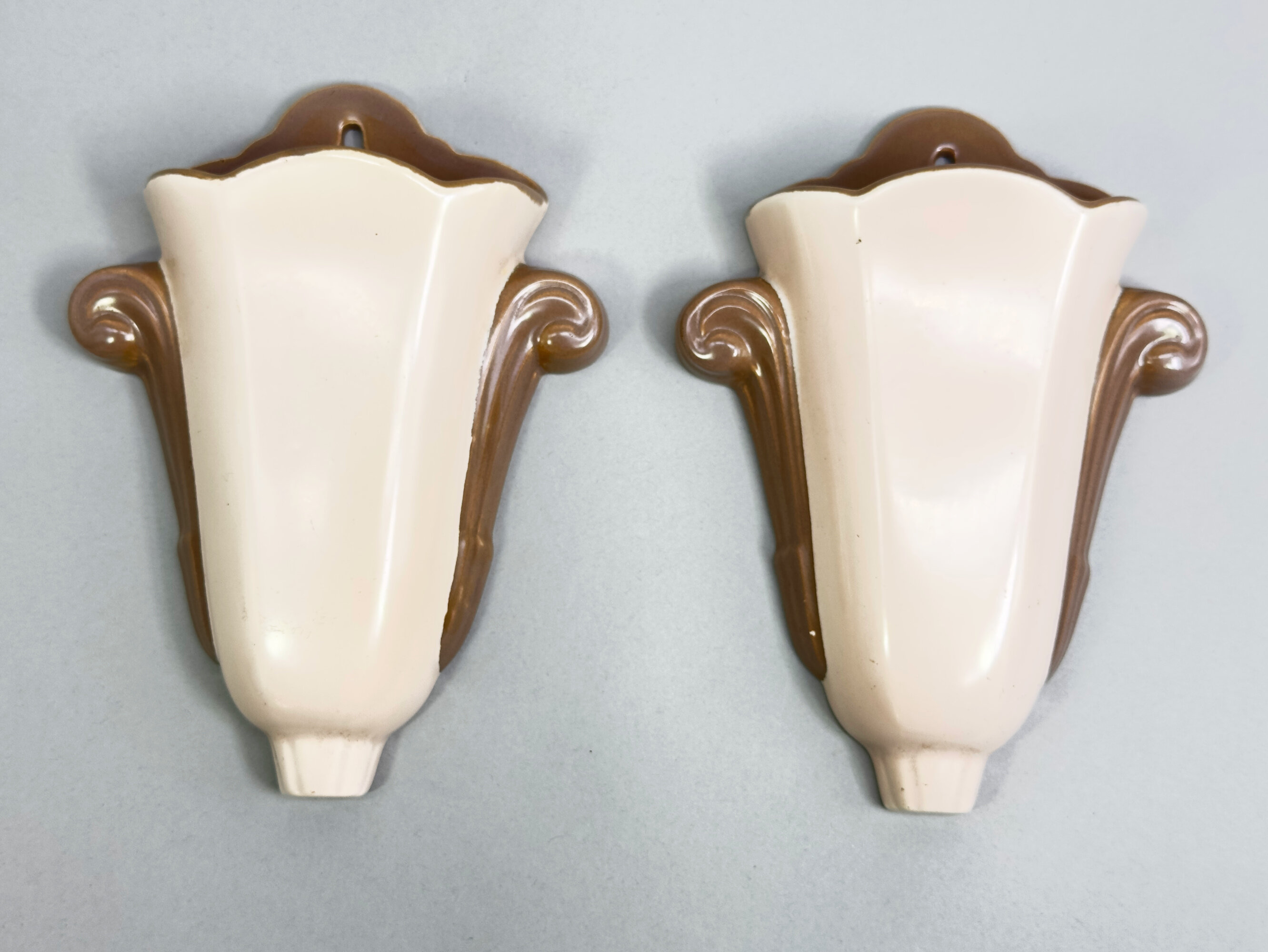
Pair of Art Deco style Wall Pocket Vases, Poole Pottery, mid C20th
Price: £55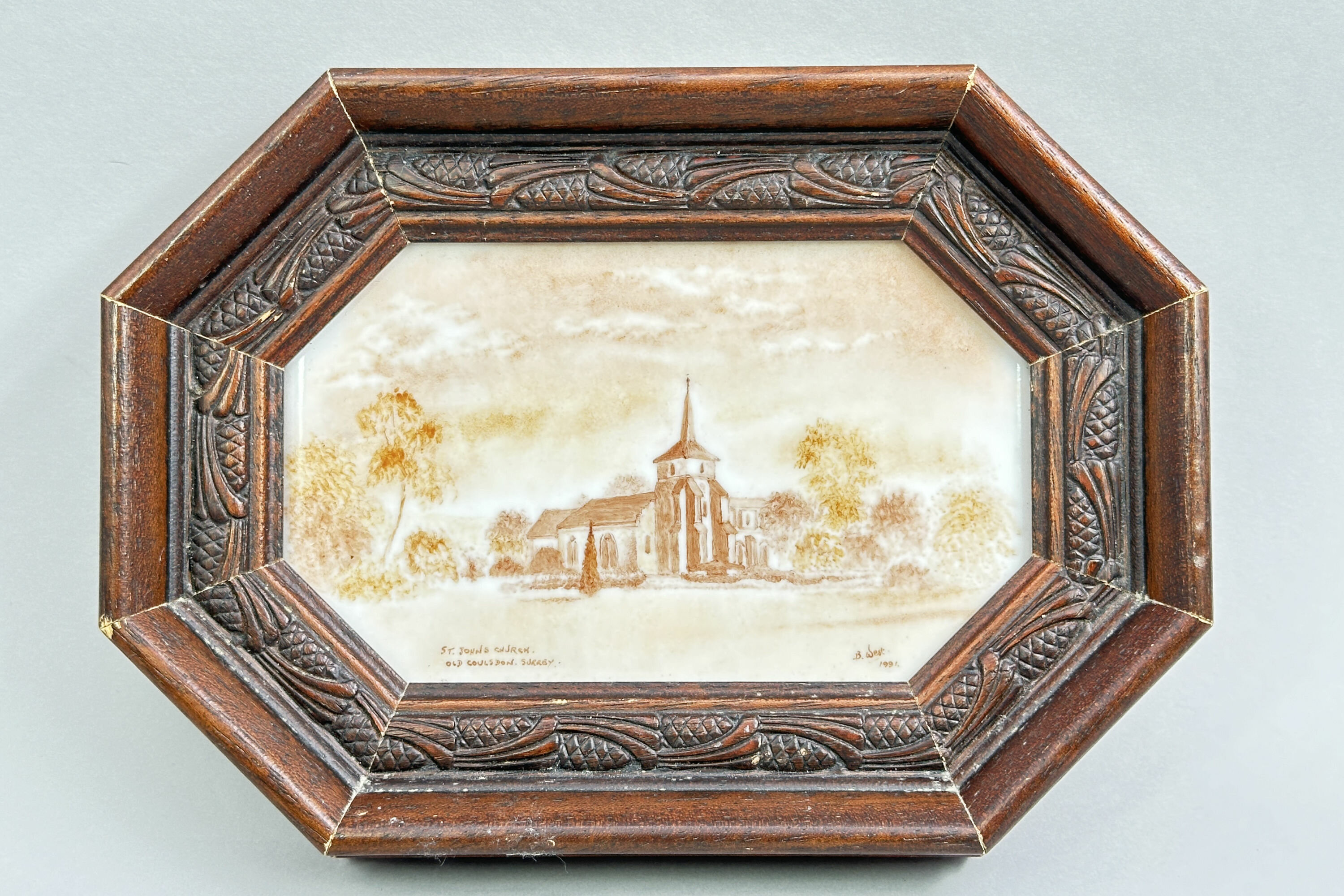
Framed Ceramic Plaque depicting St John’s Church, Old Coulsdon, late C20th
Price: £25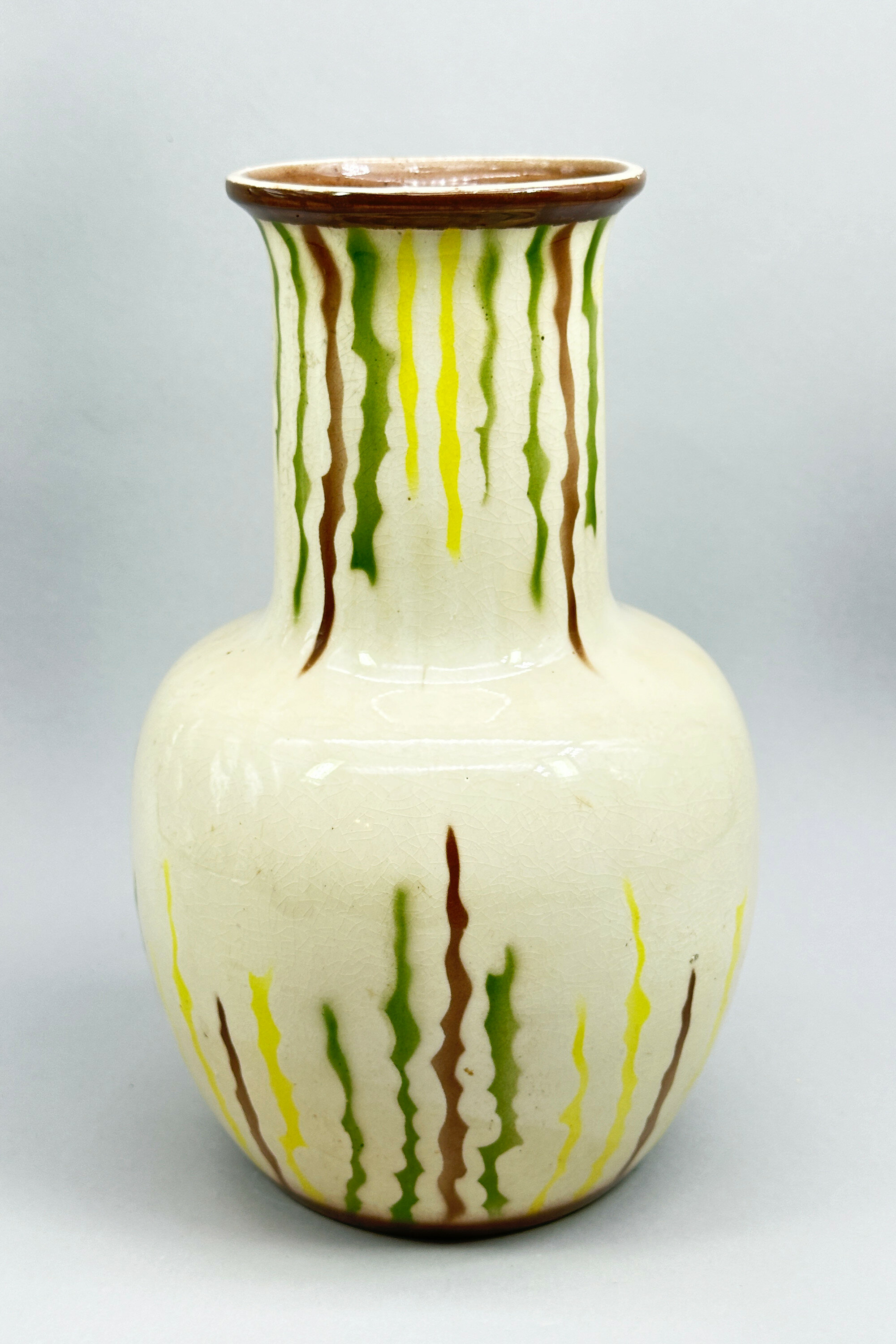
Art Deco style Vase signed E.Radford, mid C20th
Price: £75There were, in fact, two craftsmen working in the C20th British pottery industry with the name Edward Radford, father and son. Radford senior worked for Pilkington’s Royal Lancastrian Pottery in Manchester from 1903 until his retirement in 1936, acting as their main thrower. Radford junior joined his Father in 1905, but the First World War intervened, in which he won a Military Cross for his actions at Passchendaele in 1917 and afterwards he settled in Stoke on Trent, the heart of Britain’s pottery industry. An association developed with H.J.Wood’s Alexandra Pottery in Burslem who produced a range of wares bearing his name in the 1930s, although Radford himself may have acted as more a salesman than the designer. Production continued after the war and even after Radford’s retirement in 1948. The form of mark used here implies the later dating but may have been used earlier. The impressed figures indicate model number. Even if this vase is post war, the style is emphatically that of pre war Art Deco period with the simple lines of the form accompanied by semi abstract decoration vaguely reminiscent of Clarice Cliff combining to produce a piece of timeless attraction.

Continental Figure of a Cellist, Conta and Bohme, Germany late C19th
Price: £55